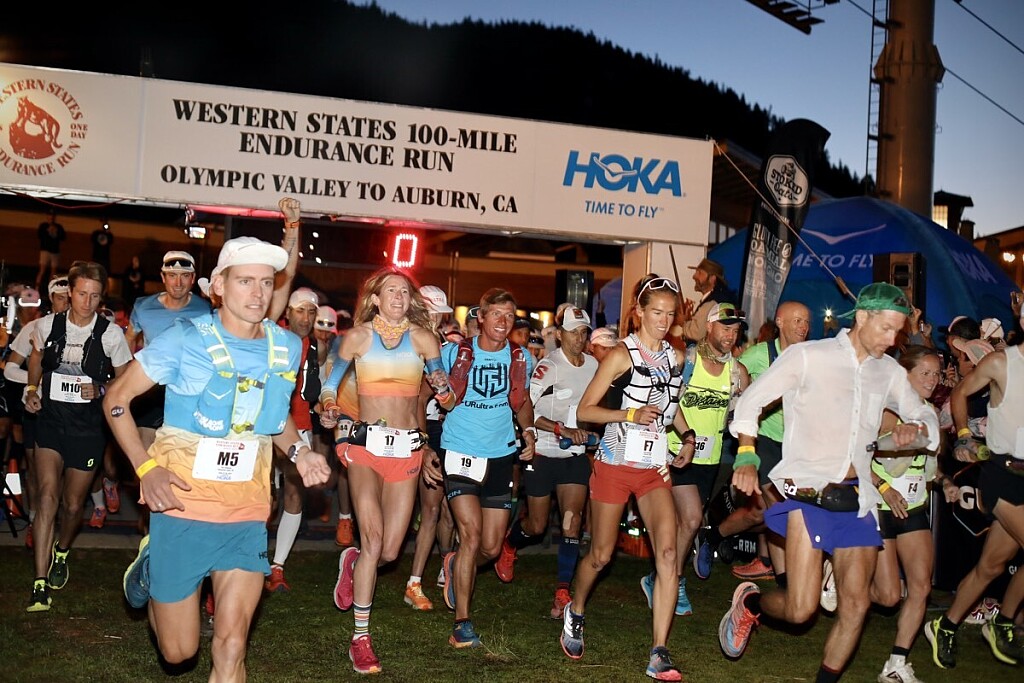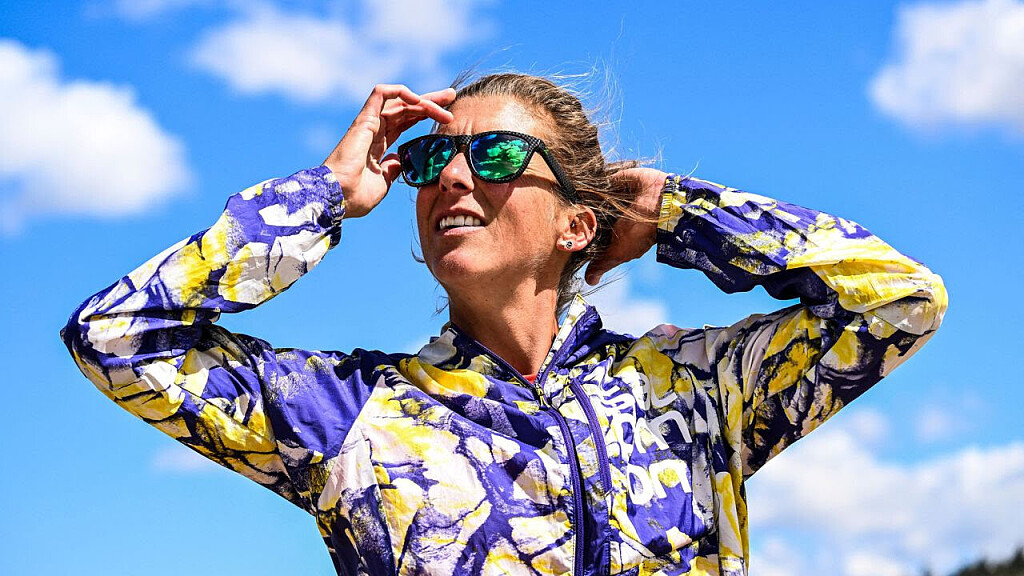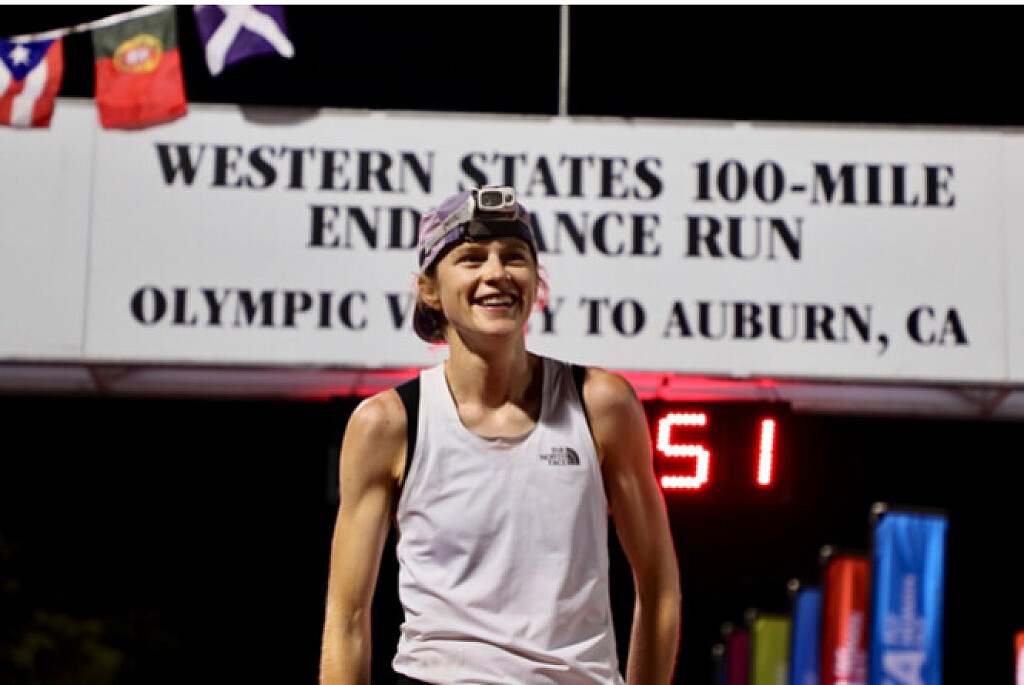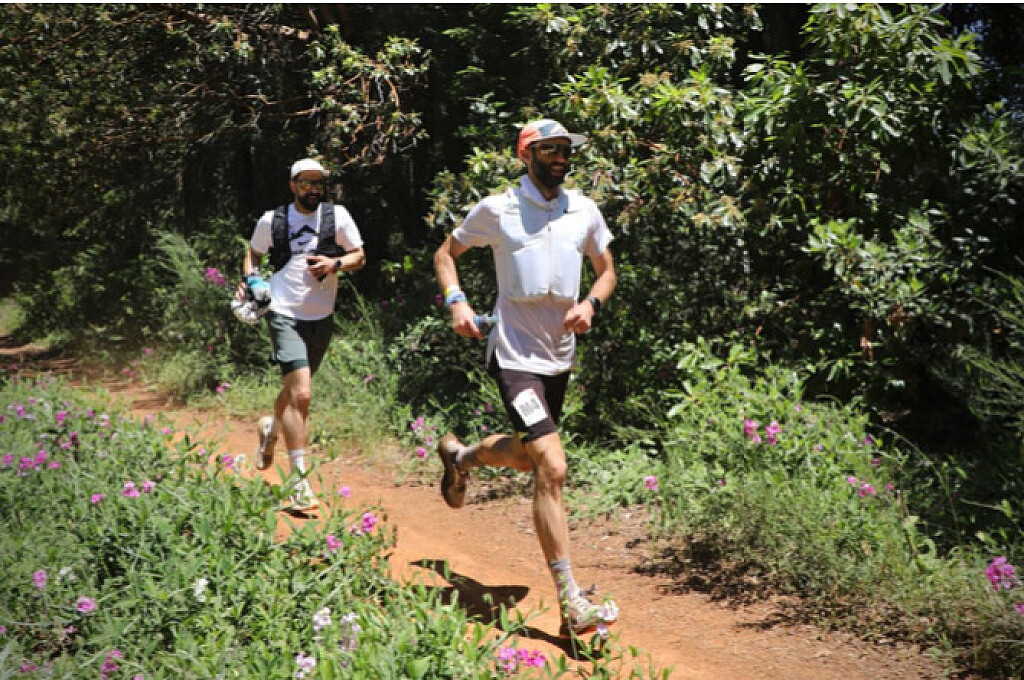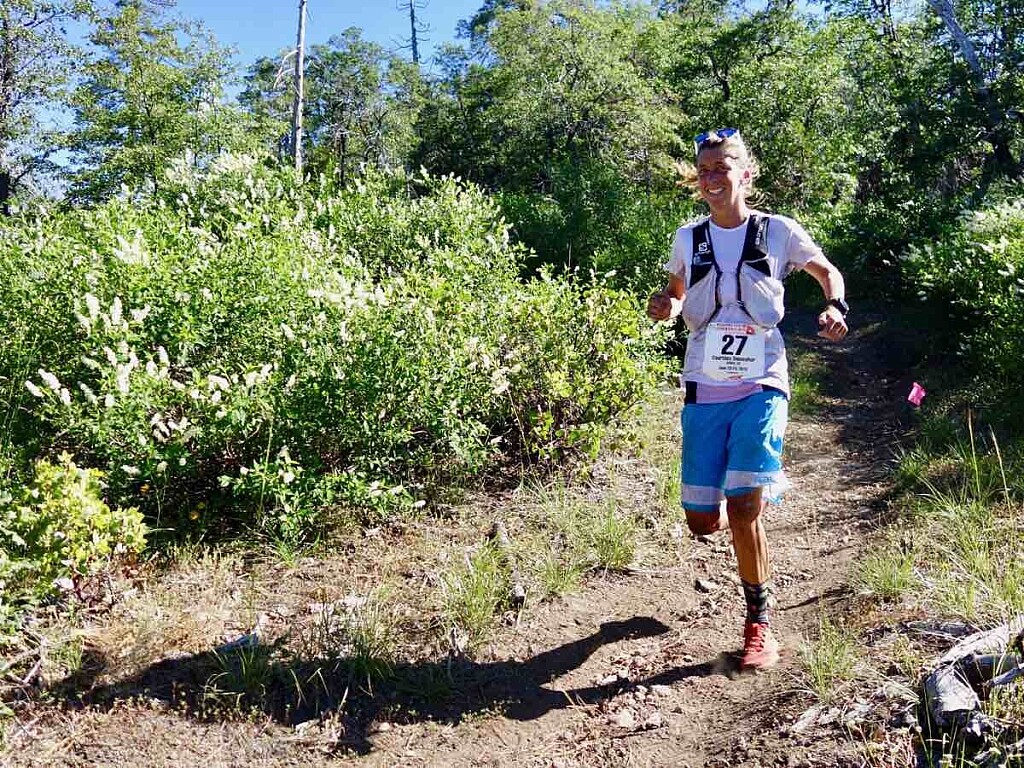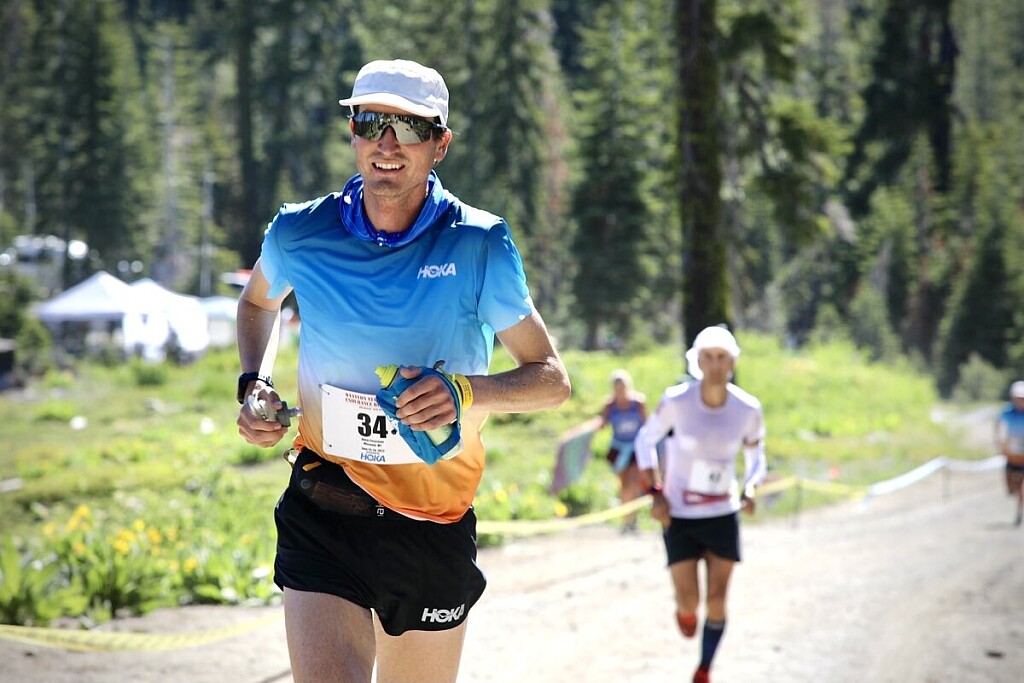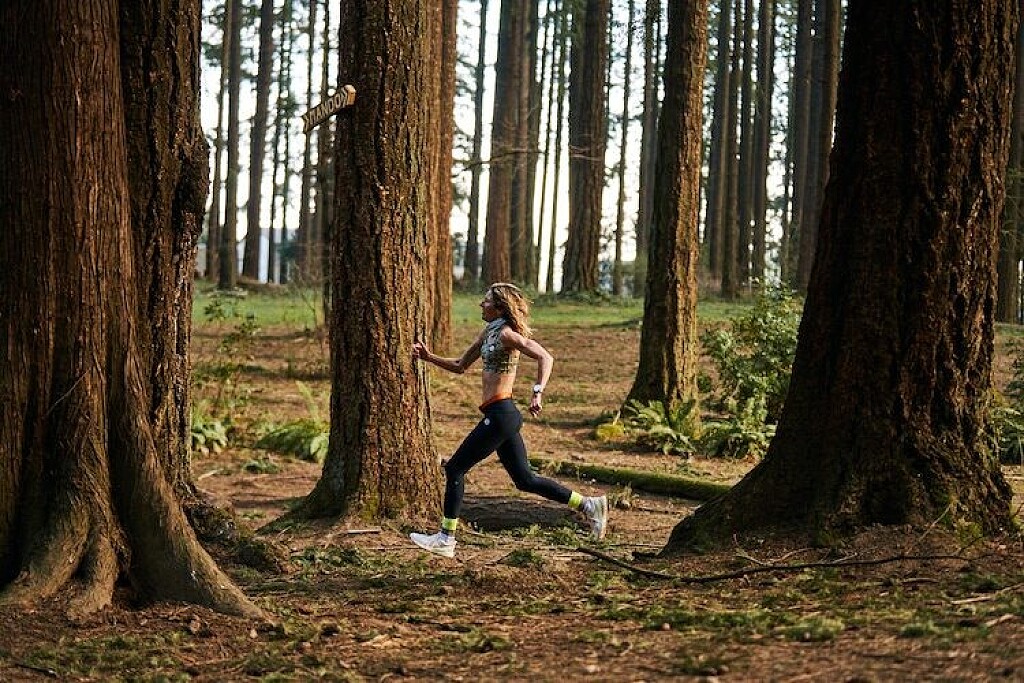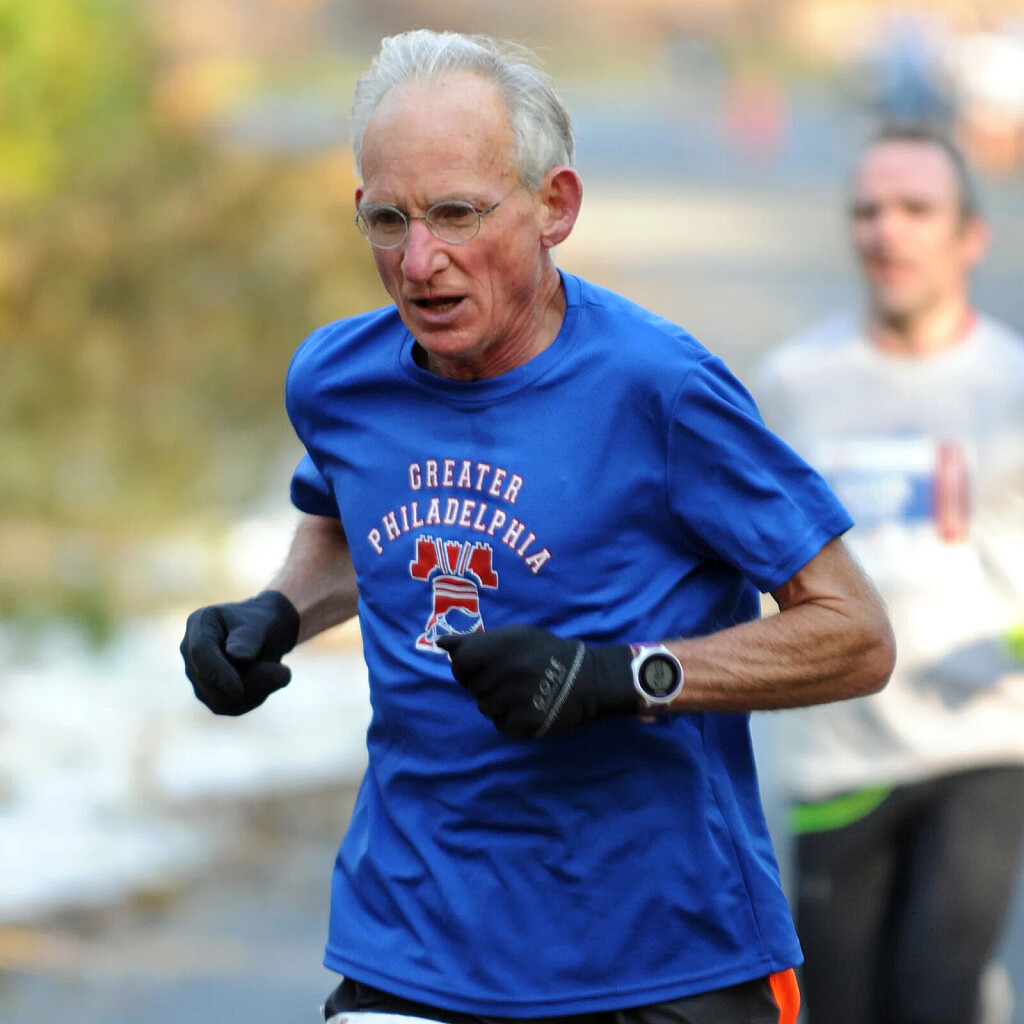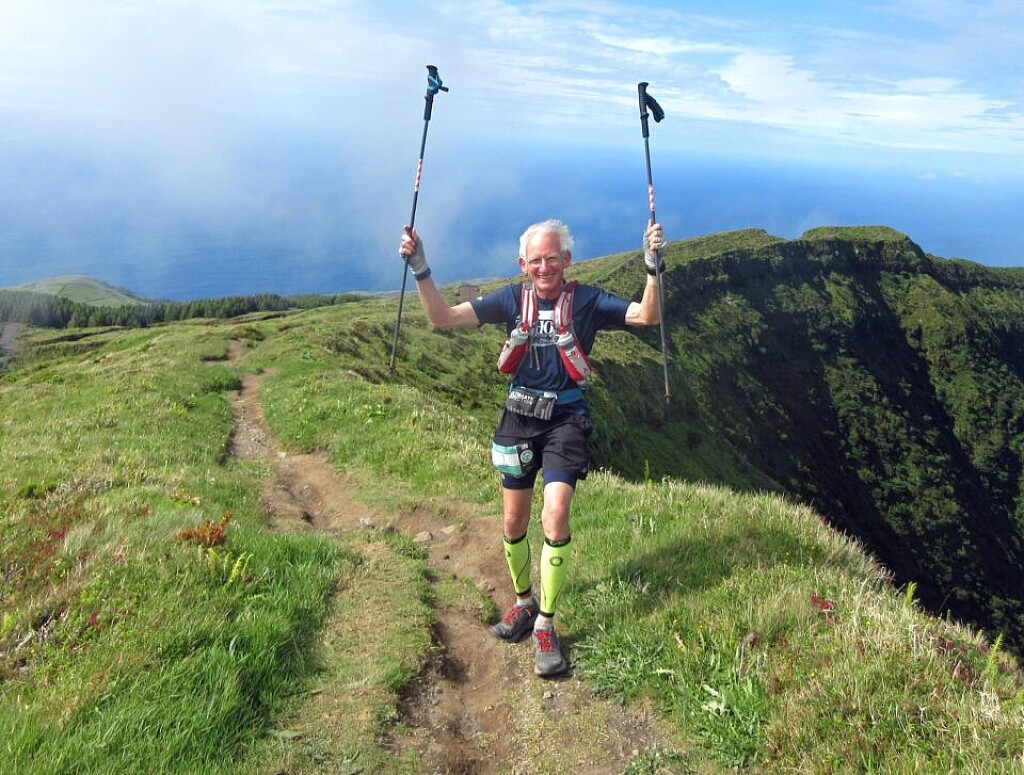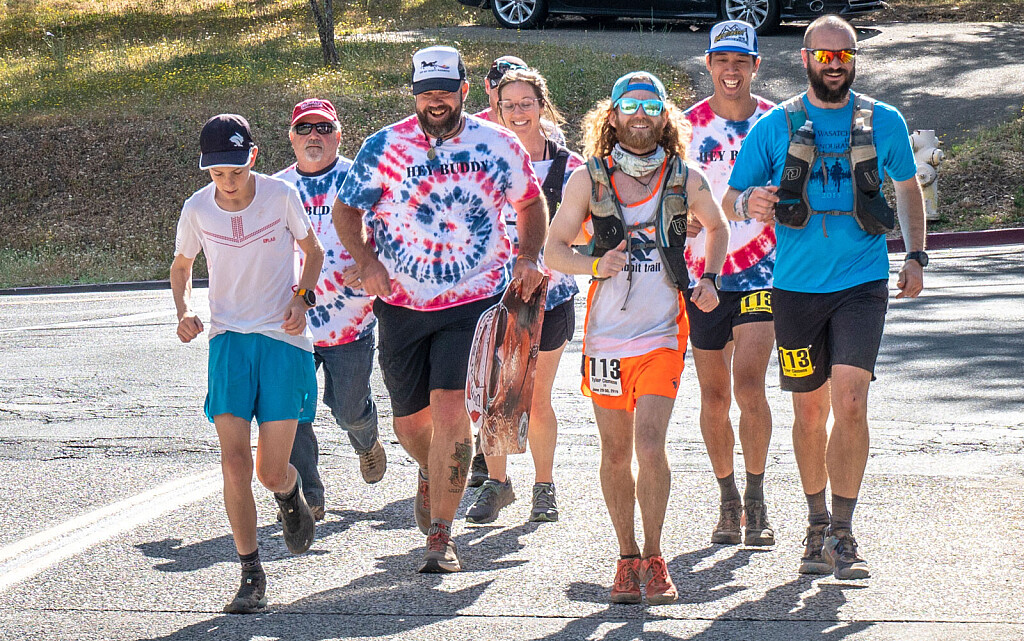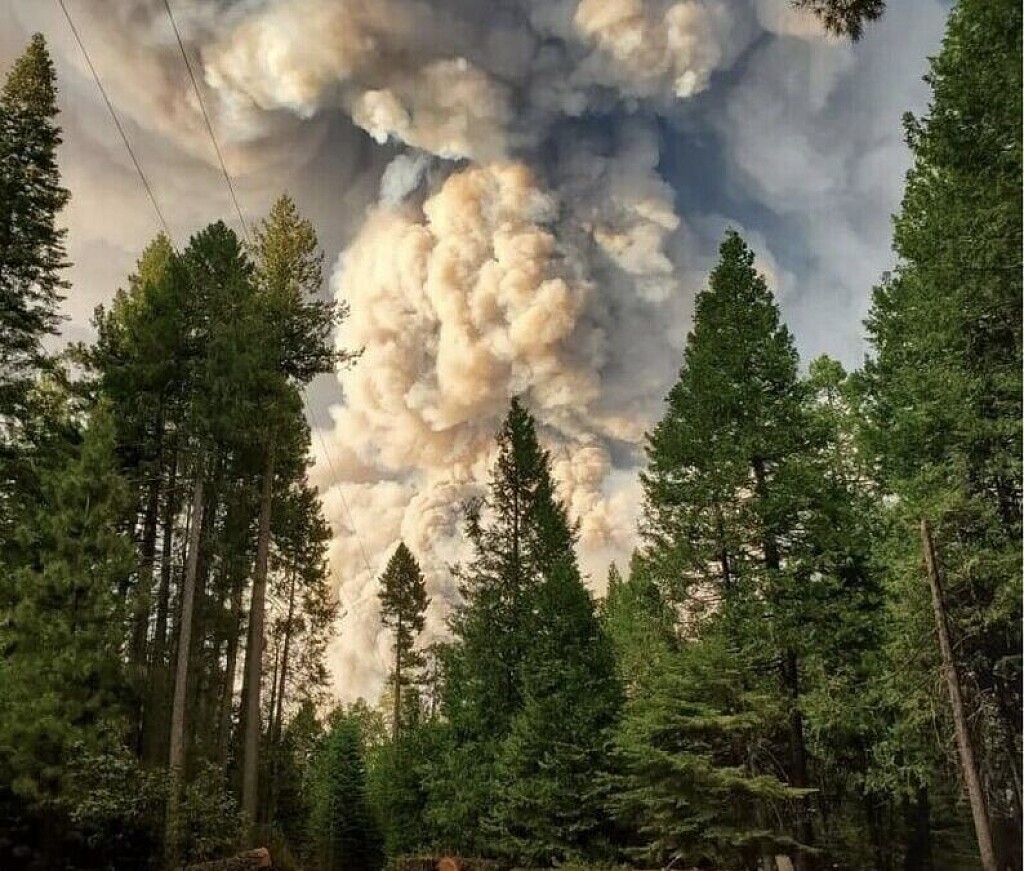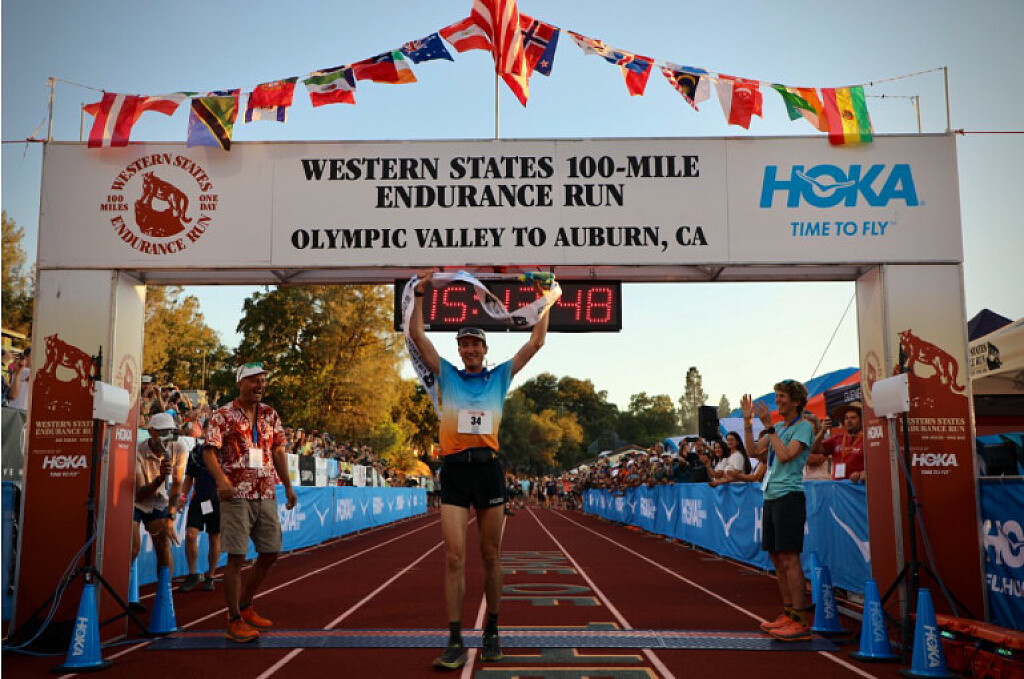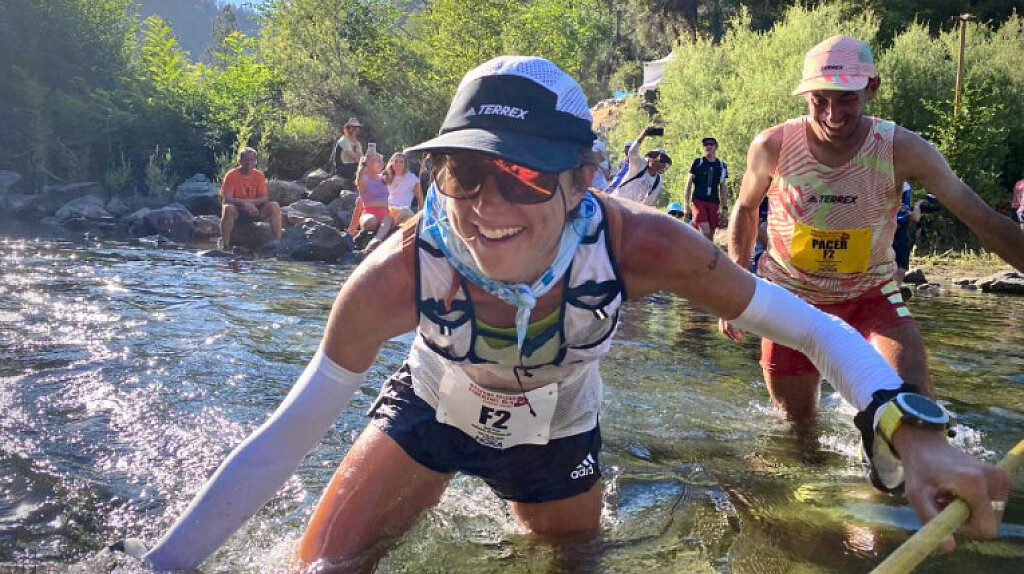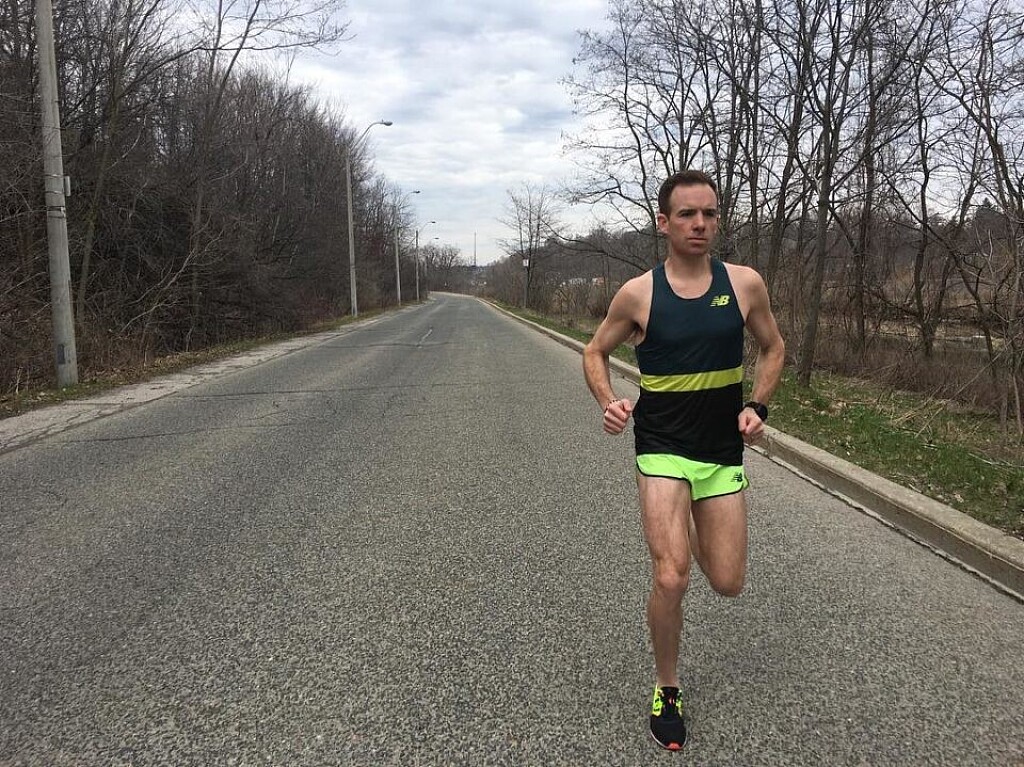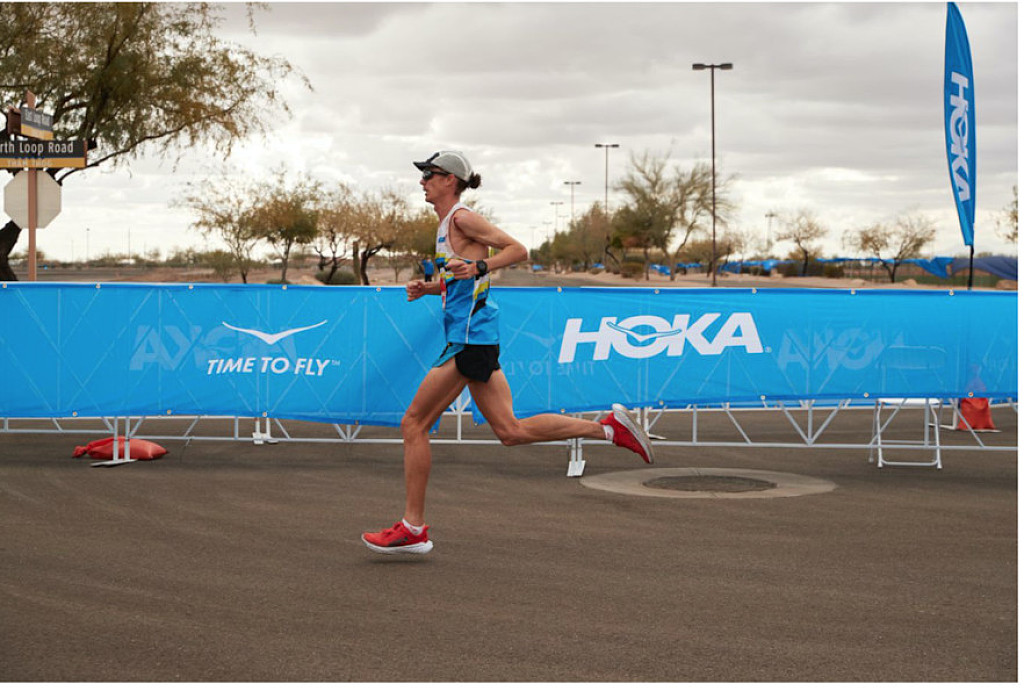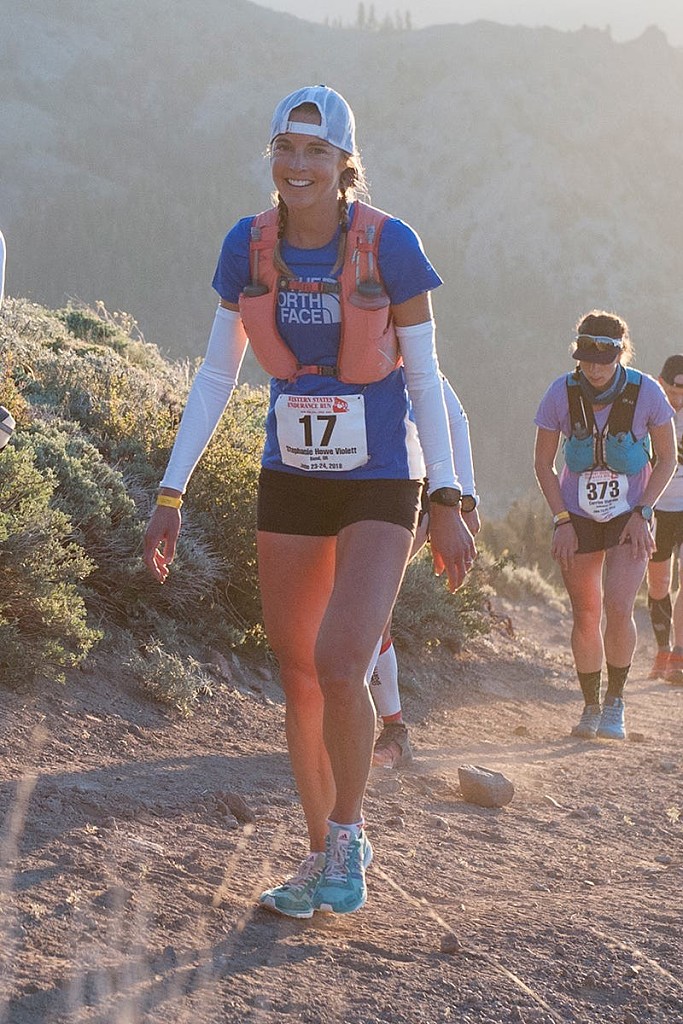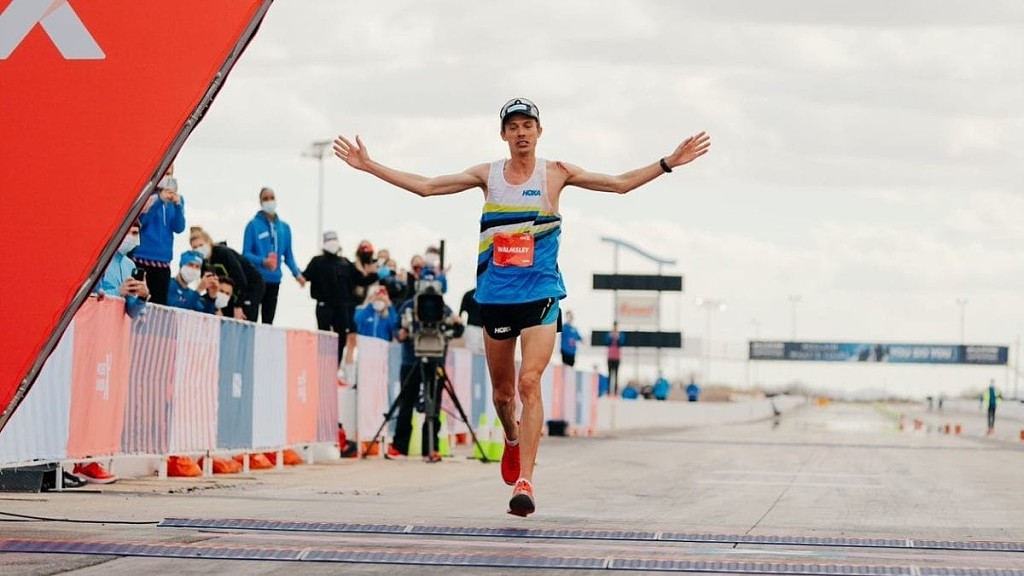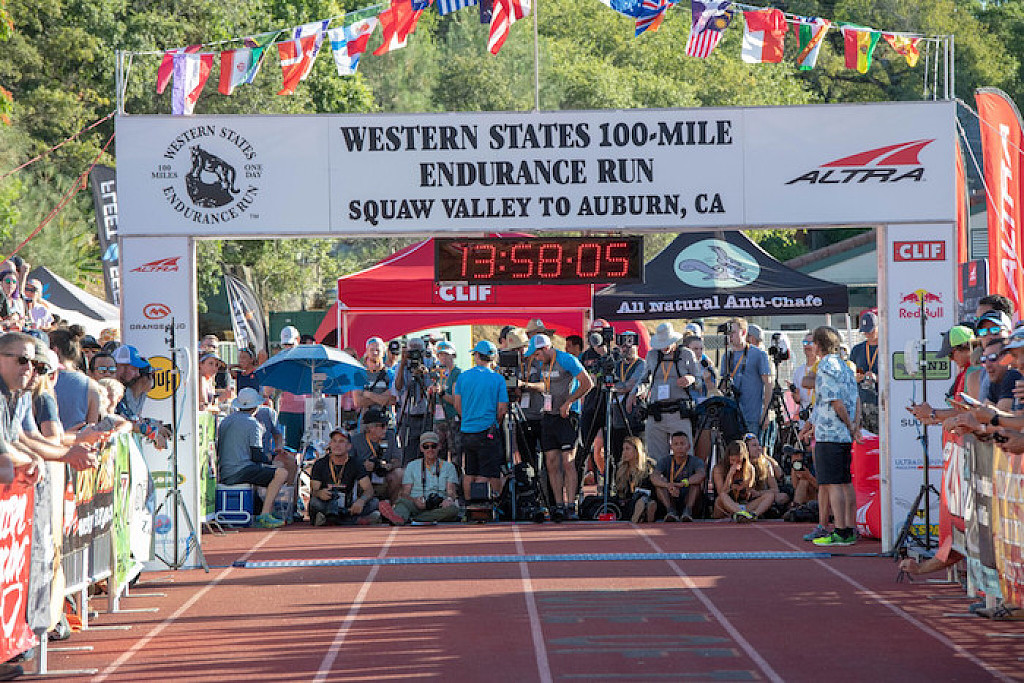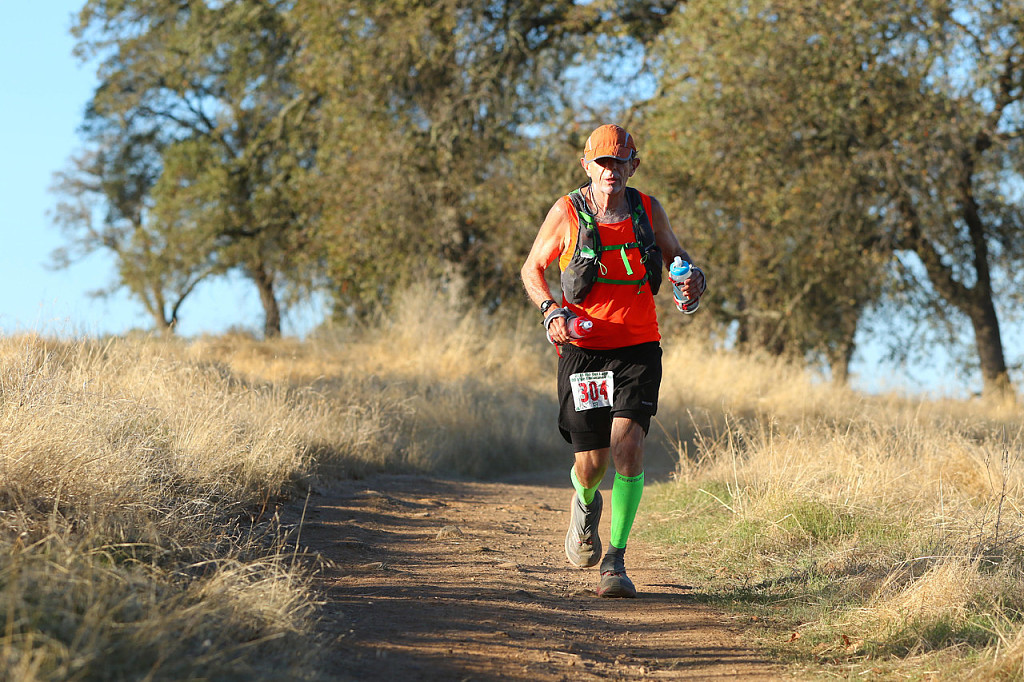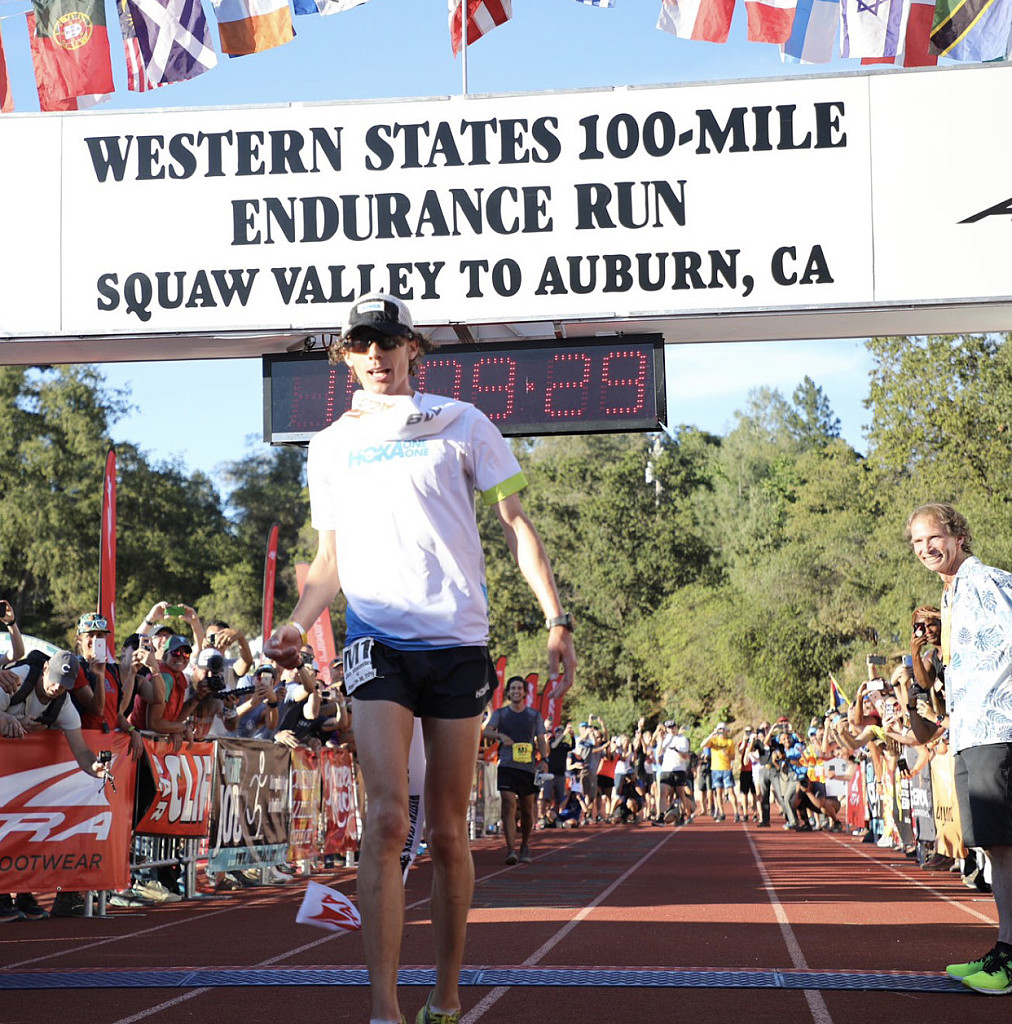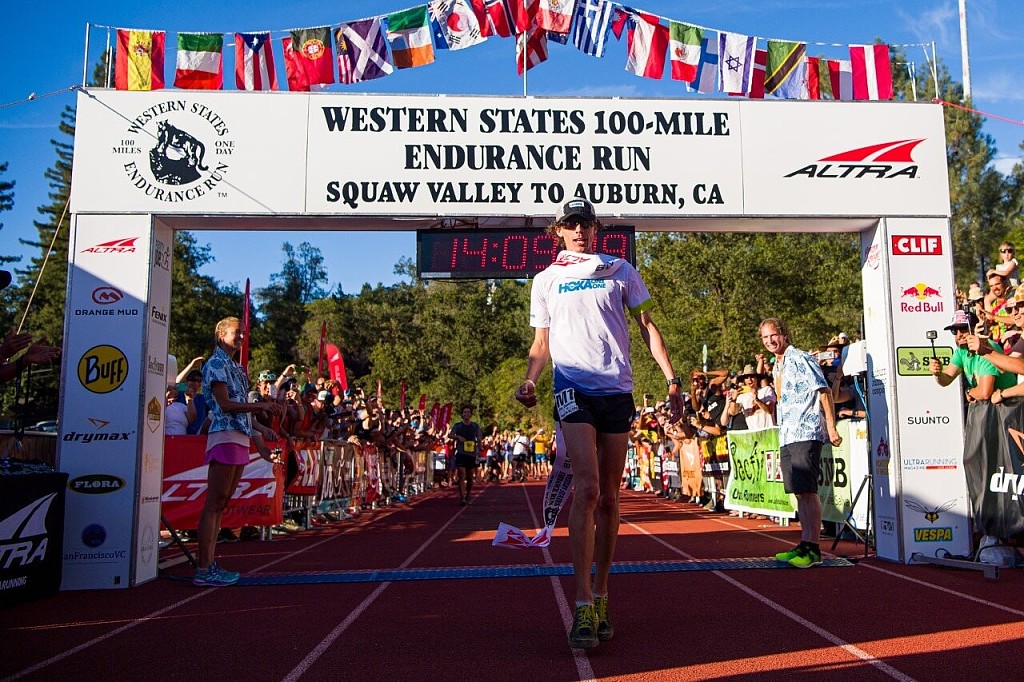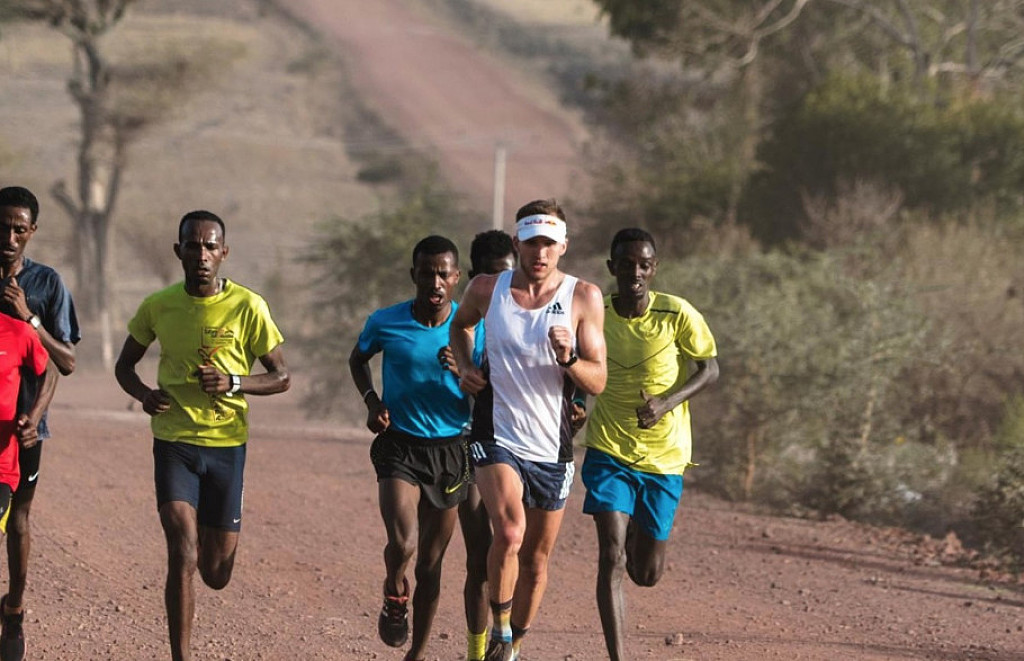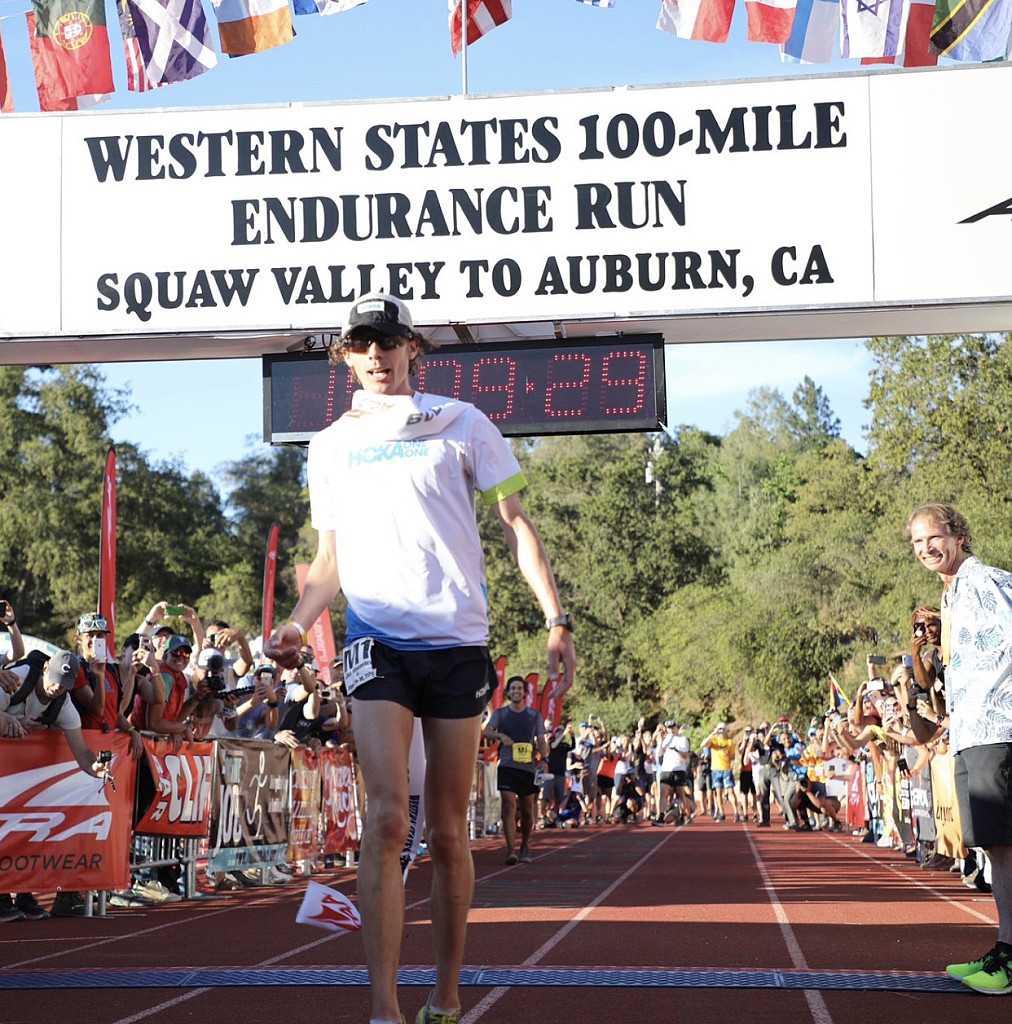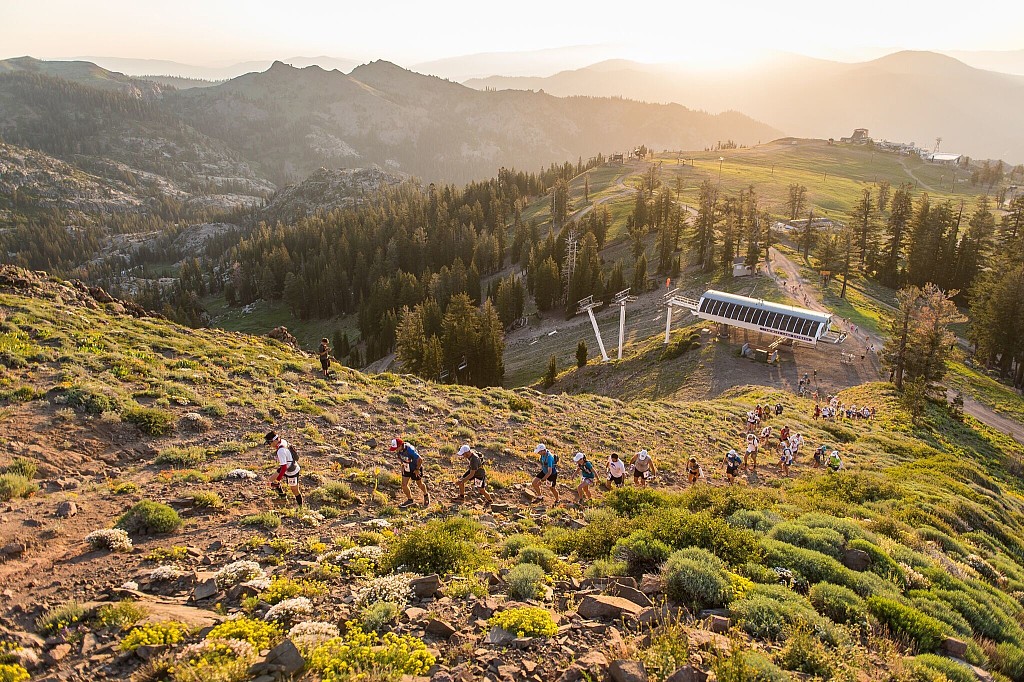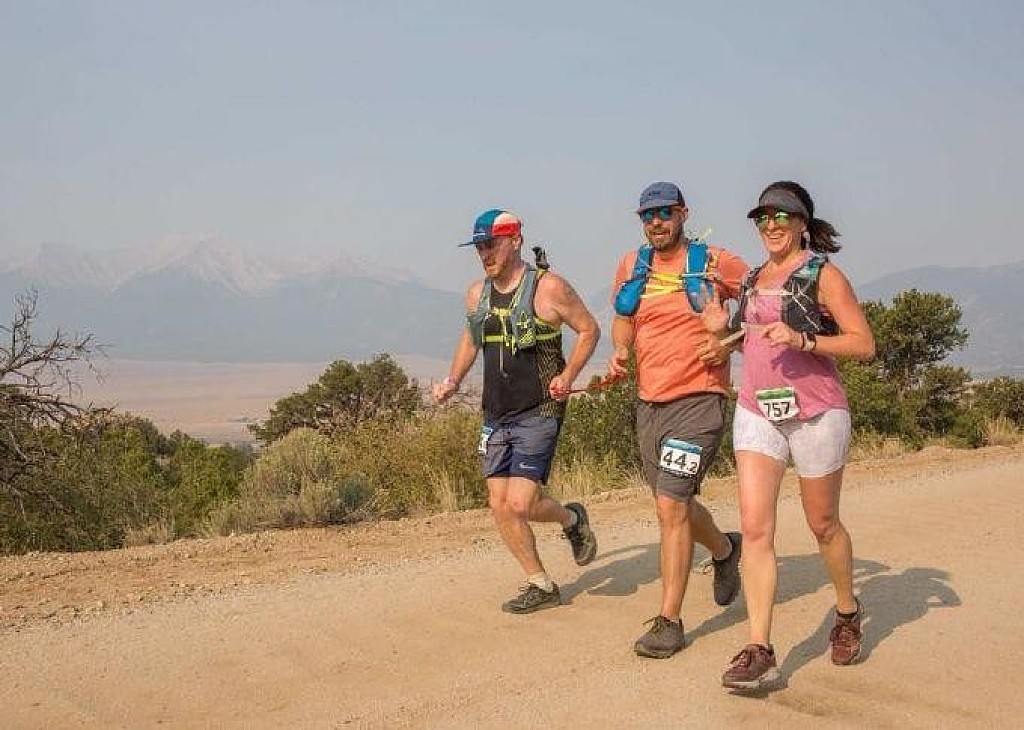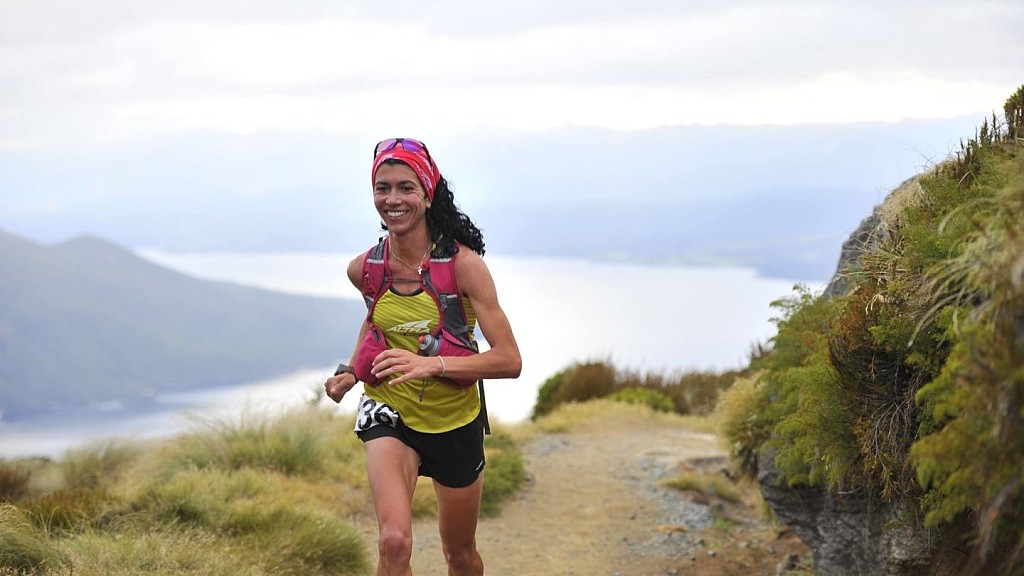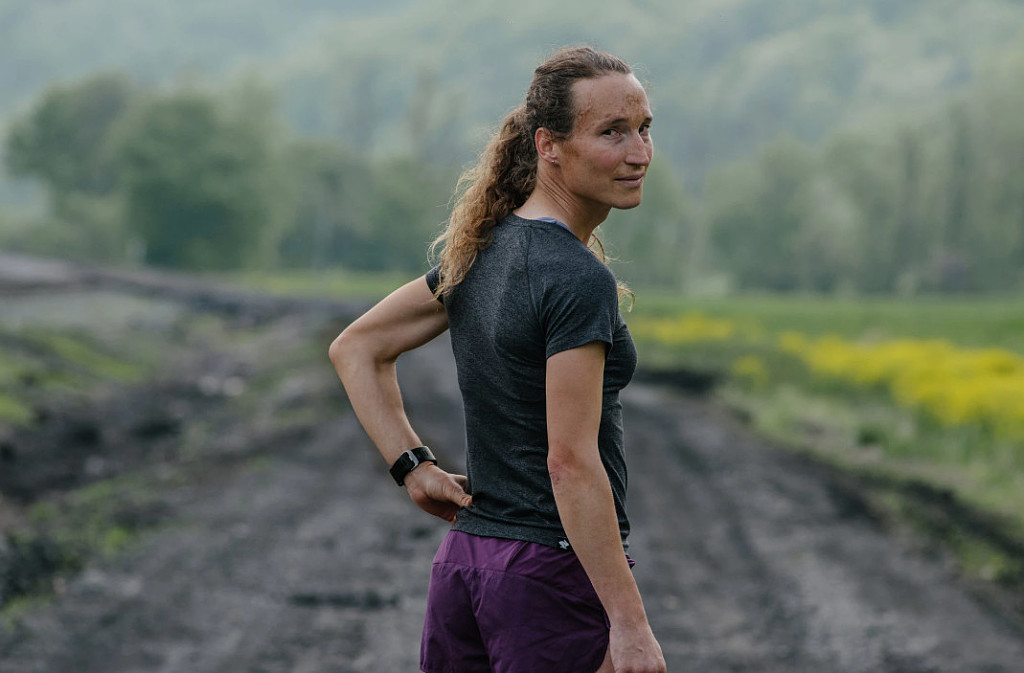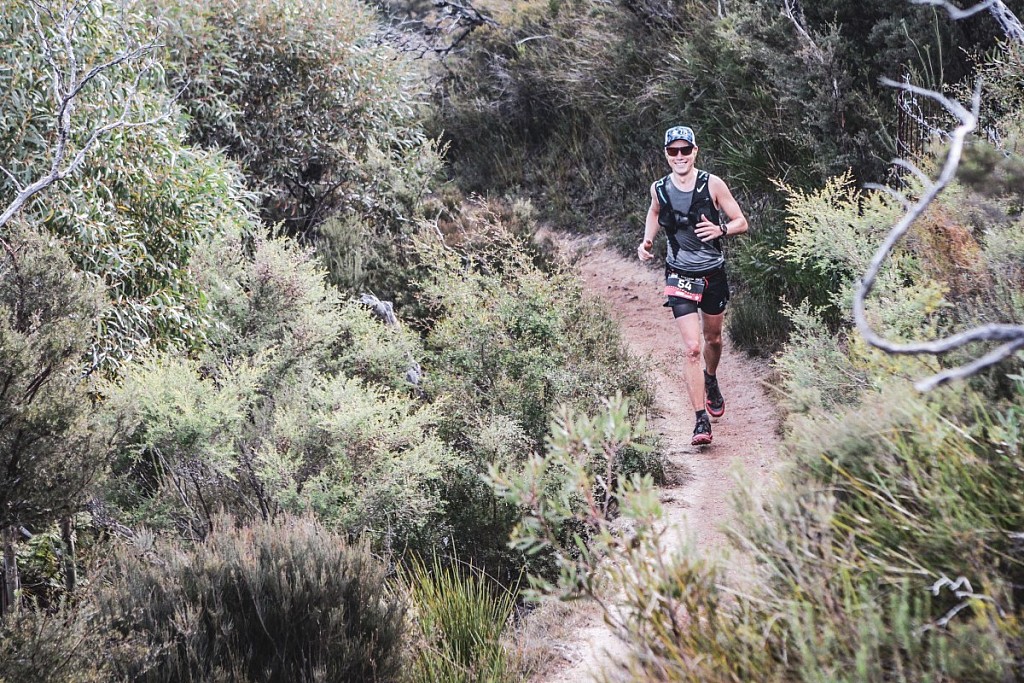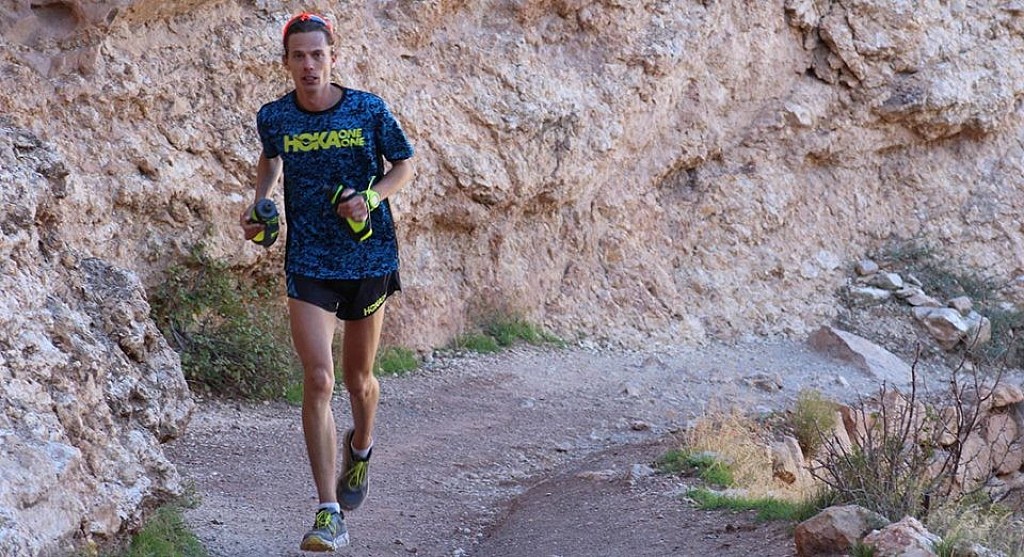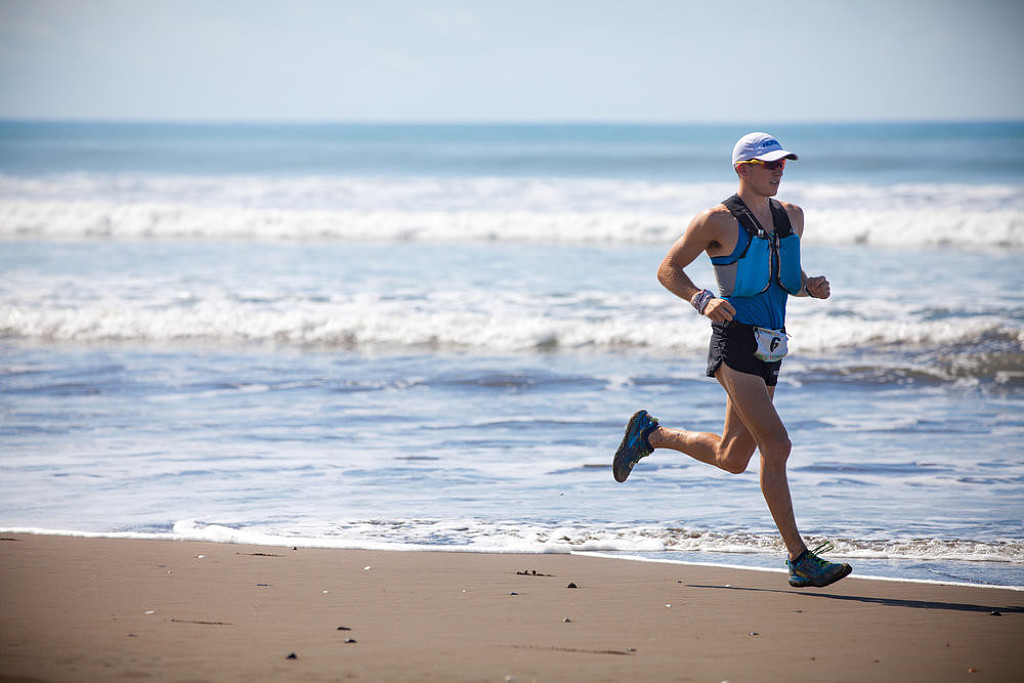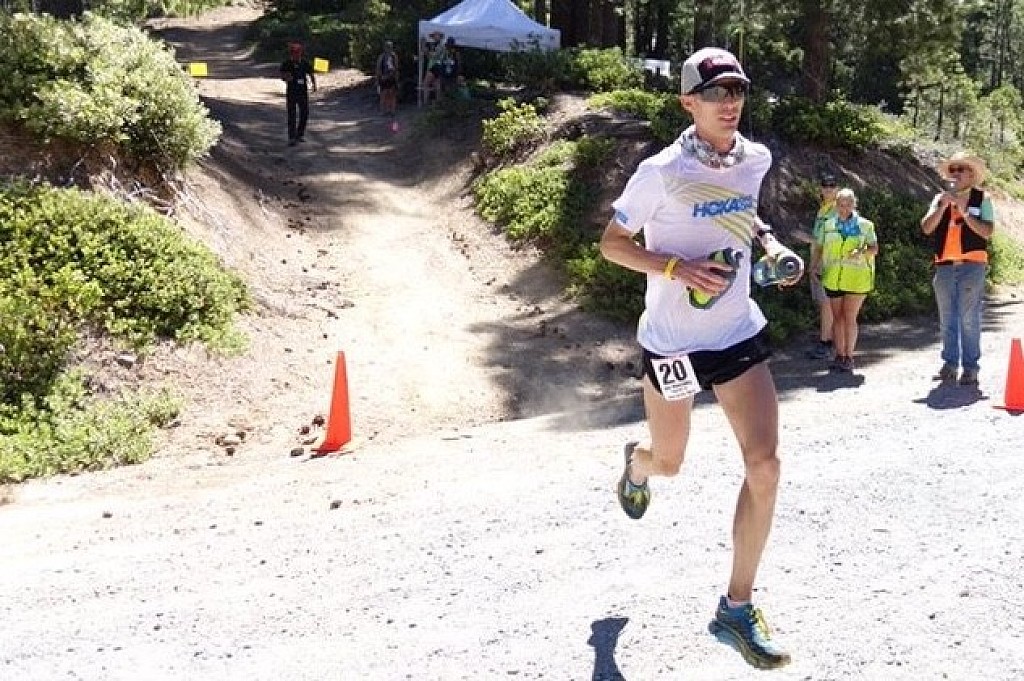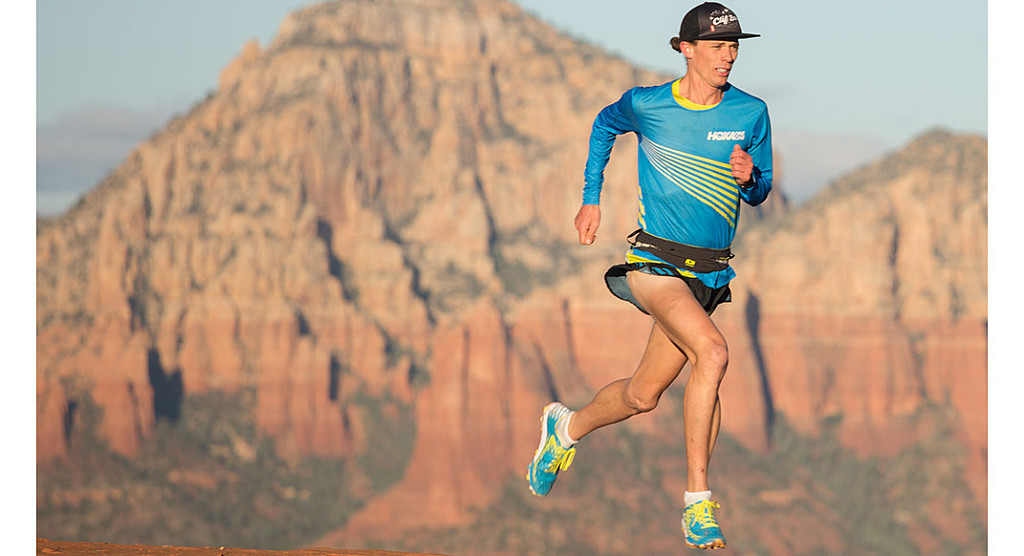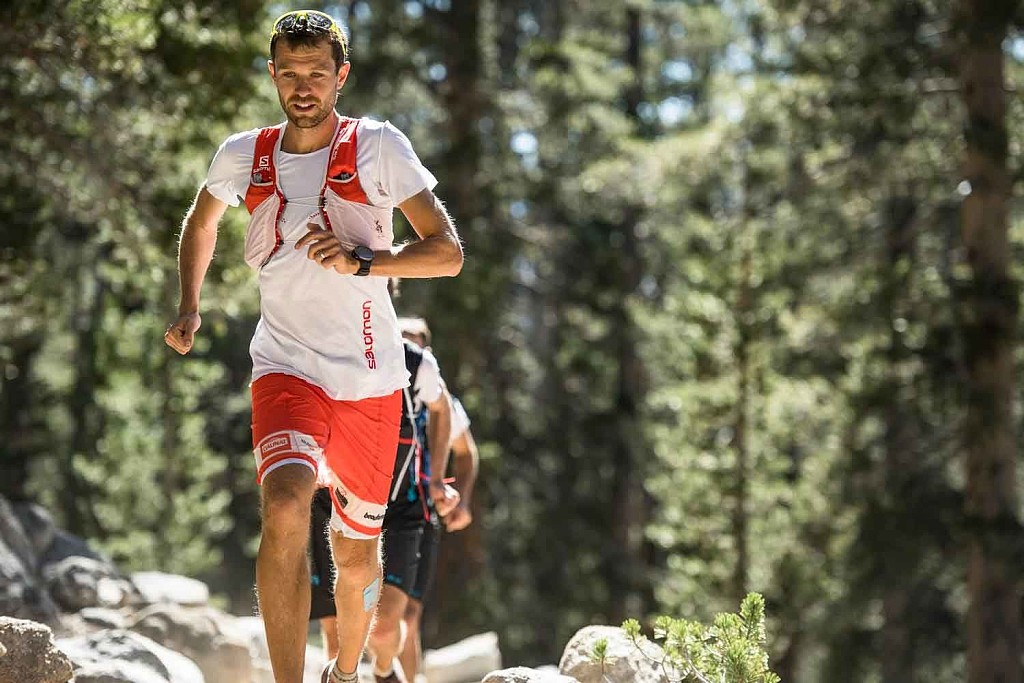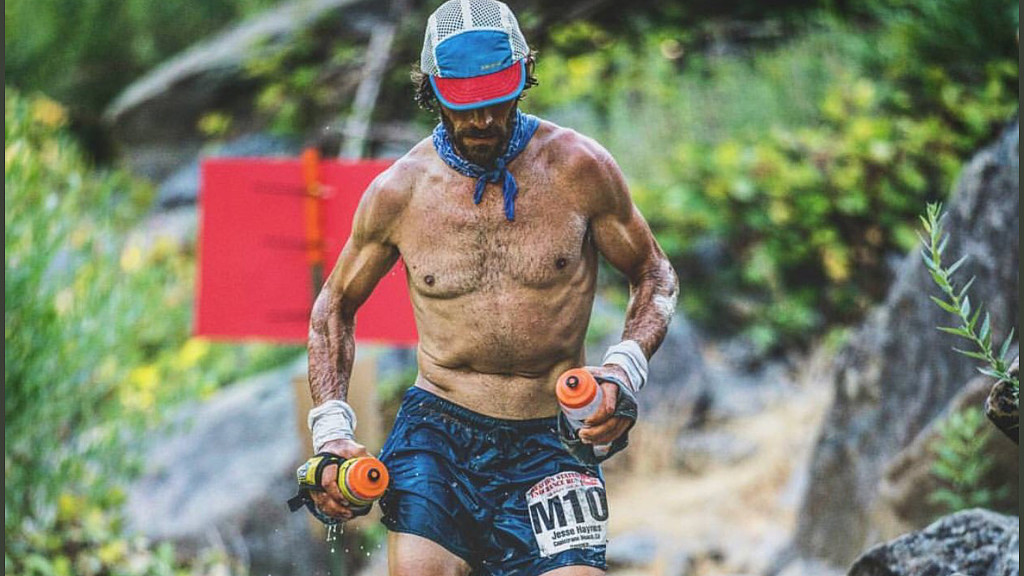Running News Daily
Running News Daily is edited by Bob Anderson in Mountain View, California USA and team in Thika Kenya, La Piedad Mexico, Bend Oregon, Chandler Arizona and Monforte da Beira Portugal. Send your news items to bob@mybestruns.com Advertising opportunities available. Over one million readers and growing. Train the Kenyan Way at KATA Running Retreat Kenya. (Kenyan Athletics Training Academy) in Thika Kenya. Opening in june 2024 KATA Running retreat Portugal. Learn more about Bob Anderson, MBR publisher and KATA director/owner, take a look at A Long Run the movie covering Bob's 50 race challenge.
Index to Daily Posts · Sign Up For Updates · Run The World Feed
Western States unveils new anti-doping policy
The legendary 100-mile race has partnered with the U.S. Anti-Doping Agency as part of an "ongoing commitment to clean sport".
On Tuesday, Western States Endurance Run (WSER) revealed a new partnership with the U.S. Anti-Doping Agency (USADA), unrolling new regulations around anti-doping and reaffirming the race’s “continuing commitment to clean sport,” as their website explains. Here’s what you need to know.
While WSER has for years had drug testing in place, the previous policies were not as stringent (and were not governed by USADA). For some runners eager to toe the line in Auburn, Calif., on June 29, the rules and expectations around testing are now more clearly laid out; others have more questions and are requesting further clarification.
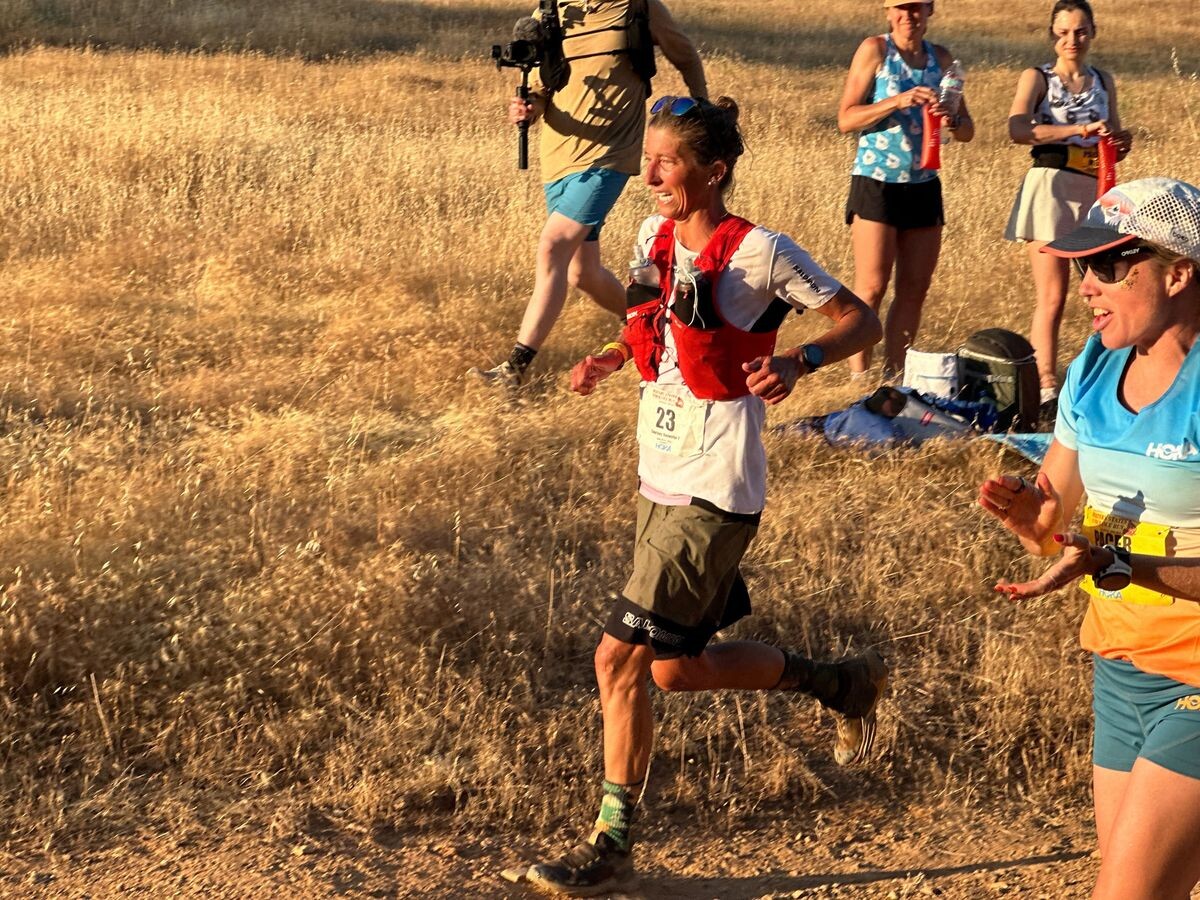
Entry rules
WSER’s entry rules explain that athletes found guilty of doping offenses by governing bodies like WADA or USADA are barred from participating in WSER during their period of ineligibility. Additionally, any athlete subjected to a ban of three months or more is ineligible unless otherwise approved by WSER. Previously, athletes who had any infractions against the WADA code were banned for life from participating in WSER—but, as ultrarunning world champ Camille Herron explains on X, the new policy allows for “more leniency of entry for those who were given a warning/1-2 month ban.”
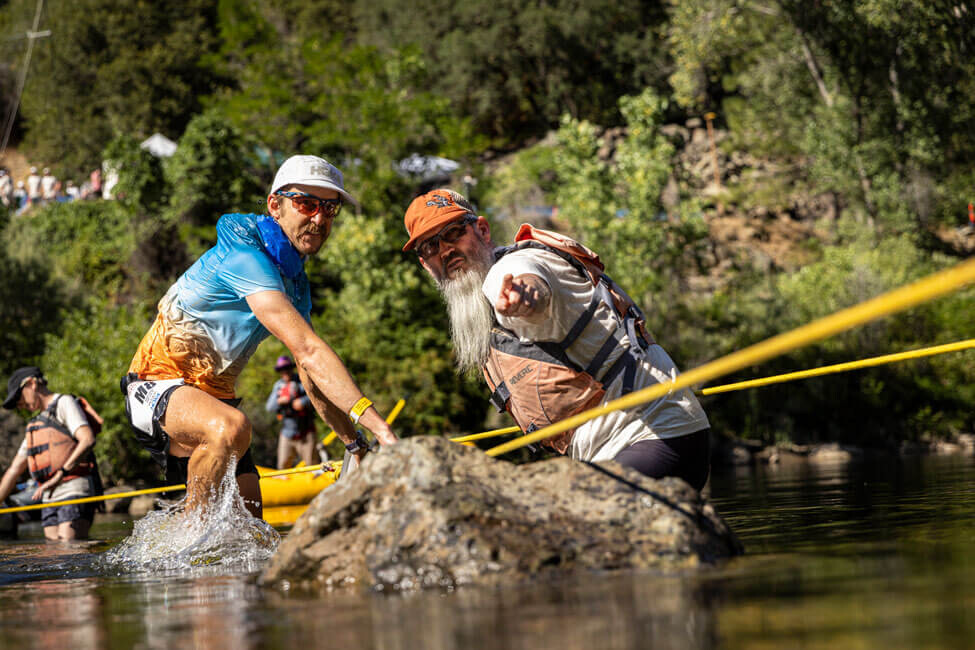
Levelling the playing field
WSER will be taking testing seriously and targeting elite athletes and top age-group competitors for post-race urine and/or blood testing. Sample collection and analysis will be handled by USADA, ensuring a thorough and transparent process. USADA will also be responsible for results management, including communicating with athletes regarding test results, investigating violations and imposing sanctions as necessary. WSER also reserves the right to impose its own sanctions.
Prohibited substances
WSER strictly adheres to the WADA (World Anti Doping Agency) Code, prohibiting the use of substances on the WADA Prohibited List. Athletes are responsible for knowing and complying with these rules. The WSER website provides resources to help athletes check their medications and suggests that runners be extremely cautious when using supplements.
Athlete response
The updated drug policies have garnered some positive responses on social media, while some athletes, such as Canadian pro mountaineer and ultrarunner Adam Campbell, are asking for further explanation.
WSER has a partnership with trail running giant UTMB, and while NSAIDs (nonsteroidal anti-inflammatory drugs, including aspirin and ibuprofen) are, notably, banned at all UTMB races, runners at WSER would not be tested for them under these new guidelines.
“The issue is the terms are not clearly defined,” Campbell posted on X. “Strong stances usually demand greater clarity. If UTMB sanctioned someone for a doping violation how would WSER handle it? Their possible violations do not necessarily sync with WADA—seems like a reasonable question to clarify.” At the time of publication, the race had not yet responded.
The 2024 edition of WSER will take place on June 29-30.
(04/04/2024) Views: 157 ⚡AMPby Keeley Milne
Western States 100
The Western States ® 100-Mile Endurance Run is the world’s oldest and most prestigious 100-mile trail race. Starting in Squaw Valley, California near the site of the 1960 Winter Olympics and ending 100.2 miles later in Auburn, California, Western States, in the decades since its inception in 1974, has come to represent one of the ultimate endurance tests in the...
more...Courtney Dauwalter breaks record at Western States 100 by almost 80 minutes
Ultramarathon runner Courtney Dauwalter crushed the women’s course record at the Western States 100-mile race in California, taking more than an hour off the previous best time.
Dauwalter finished the Western States 100 – the world’s oldest 100-mile race – in 15 hours, 29 minutes and 34 seconds, almost 80 minutes faster than Ellie Greenwood’s record set in 2012. The race was first run in 1974.
“I just kept asking [my legs] to do one more mile for me and they kept responding, so I was very thankful for that,” Dauwalter told iRunFar about the last 20 miles of the race.

“I was definitely, though, deep in the pain cave and really focused on every single step, every single second.”
Cooler weather contributed to faster times at this year’s Western States 100, which started in the early hours of Saturday morning in Olympic Valley, California.
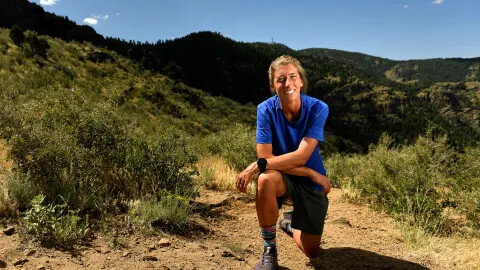
Snow covered much of the initial stages of the course before runners descended into a recently unshaded section scorched by last year’s Mosquito Fire.
After running with fellow American Katie Schide, Dauwalter started pulling away around the 30-mile mark, steadily eating away at Greenwood’s course record.
Covering 18,000 feet of climbing and almost 23,000 feet of descent across Californian trails, the race finishes on a high school running track in the city of Auburn in Placer County.
“I couldn’t believe when the track suddenly showed up and you make that turn, I was like: We did it! We’re here!” Dauwalter told iRunFar.
“Because that was the moment where I let myself actually believe that we had finished and we were about to be able to stop moving.”
Dauwalter, who is set to defend her title at the Hardrock 100 in Colorado in three weeks’ time, also won the Western States 100 in 2018, though her time this year was nearly two hours faster.
Most people’s idea of fun wouldn’t involve running for hours on end through brutal, undulating terrain – but ultra-marathon sensation Courtney Dauwalter is no ordinary person.
While an ultra-marathon is technically defined as any race longer than 26.2 miles, Dauwalter’s exploits tend to take place at distances far greater than that, usually between 100 to 250 miles.
The 38-year-old’s list of achievements is almost interminable. Dauwalter, a four-time ‘Ultra Running Magazine Ultrarunner of the year,’ holds multiple course records for the obscenely long races around the US and abroad.
Dauwalter’s breakout moment came at the Moab 240 – an annual 240-mile race in Utah. At the 2017 edition, shortly after making the decision to become a full-time ultra-runner, Dauwalter completed the course a scarcely believable 10 hours ahead of all other competitors – male and female.
The Transgrancanaria event on February 24 – Dauwalter’s most recent escapade - resulted in her 15th straight race win by gender dating back to March 2021, according to results database Ultrasignup.
The Minnesota native completed the grueling 128km course (79.5 miles) – including over 7000 meters of elevation gain - around the Canary Island in a course record 14 hours 40 minutes: over 90 minutes ahead of her closest competitor.
(06/26/2023) Views: 711 ⚡AMP2023 Western States 100 Women’s Race
None of the first four women from last year’s race — Ruth Croft, Ailsa MacDonald, Marianne Hogan, Luzia Buehler — returned. That made Zimbabwe’s Emily Hawgood (pre-race interview) the highest returning finisher from 2022. Hawgood’s pretty much a race local now too, living in nearby Roseville, California. But it was 38-year-old Courtney Dauwalter (pre-race interview) that came into the race as a favorite. She won here in 2018 in 17:27 and was looking to avenge a late drop at the 2019 race.
Dauwalter was first up the Escarpment. At 2,500 feet, it’s the race’s biggest climb and it happens right away in the first three miles. But 2022 UTMB winner Katie Schide (pre-race interview) was right there too. Schide, an American who’s lived in France for the past seven years, hit the top in 46 minutes with Dauwalter and the two dropped into the Granite Chief Wilderness together. Already Dauwalter and Schide, age 31, had a three-minute lead on third-place Ida Nilsson (pre-race interview) from Sweden.
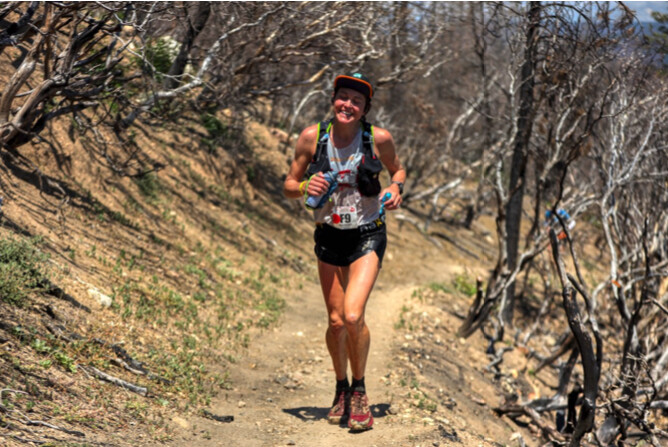
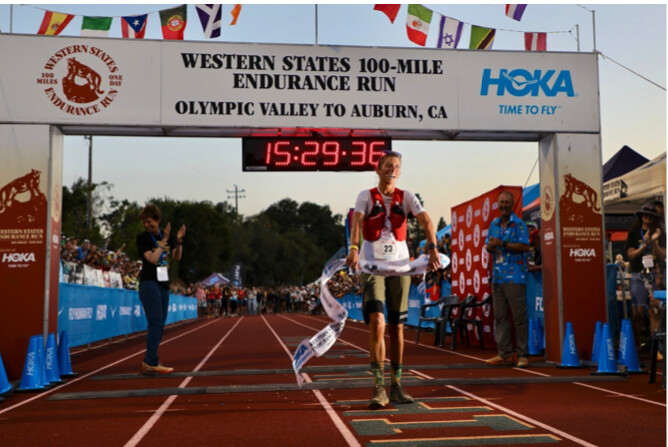
By mile 11, Lyon Ridge, Dauwalter and Schide’s lead on third-place Nilsson had ballooned to eight minutes. And then it got even bigger as the two completely broke away from everyone else. At mile 16, Red Star Ridge, no one was within 14 minutes of the front two. Nilsson, Hawgood, 2023 Black Canyon 100k winner Keely Henninger (pre-race interview), Taylor Nowlin, professional triathlete-turned-ultrarunner Heather Jackson, Canada’s Priscilla Forgie and Jenny Quilty, and 2022 sixth-place finisher Leah Yingling (pre-race interview) all ran inside the early top 10.
The Mosquito Fire limited crew access this year and everyone met their crews for the first time at mile 30, Robinson Flat. Dauwalter was in at 5:07 and out within a minute, and still on her 2019 splits. Schide took a longer break and changed shoes, exiting the aid station three minutes behind the leader. The two had completely broken open the women’s race. Nilsson, in her 100-mile debut, had been alone in third to this point, but was now joined by Henninger, Hawgood, and Nowlin.
At mile 34, Miller’s Defeat, the course record watch started. Dauwalter and Schide were under Dauwalter’s own 2019 splits and Ellie Greenwood’s 2012 course record pace. Dauwalter was five minutes up on Greenwood’s splits, and Schide was three minutes faster. Even more, the two were over 30 minutes in front of third-place Hawgood at mile 38. Dauwalter and Schide were out front for the win and the course record, and the other contenders grouped behind them.
Dauwalter was red hot up the Devil’s Thumb climb at mile 48, but Schide hadn’t given up much time. She took longer in aid and left six minutes after Dauwalter. Hawgood, Nowlin, and Henninger came in together next, now 40 minutes behind second-place Schide.
At Foresthill, Dauwalter was 25 minutes up on record pace. Schide conceded only another two minutes over the last stretch and was 11 minutes behind Dauwalter. While Dauwalter and Schide were still off the front, the race dynamic was heating up behind. The third- through eighth-place women were all in Foresthill together with only three minutes separation. Hawgood was there first among the chase group, but Hungarian living in Hong Kong Eszter Csillag quickly jumped from eighth at mile 52 to fourth at mile 62. Nilsson was fifth, and Henninger, Katie Asmuth, and Nowlin were all there too.
Dauwalter ran 2:10 from mile 62 Foresthill to mile 78 at the American River. Only the men’s winner would run a quicker split on this day, and only eight men have ever run a faster split in the race. Dauwalter was five levels better than everyone else, and she was boldly racing without a pacer too. Schide stayed comfortably in second, but fell further behind Dauwalter’s quickening pace and river conditions necessitated that everyone cross the American River in a boat this year.
From Foresthill to the river, Katie Asmuth vaulted into third, past Eszter Csillag and Ida Nilsson. Asmuth was seventh at Foresthill and picked up four spots on the downhill Cal Street stretch, outrunning common expectations in coming back from injury. All three women split faster from Foresthill to the river than Schide did and even if the front two were gone, the women in general were running really fast. There’s bound to be some bad luck in a 100 miler though, and Henninger fell just before the river and dislocated her shoulder. She would then drop from the race at mile 80, Green Gate, due to that injury.
Dauwalter’s incredible second half and incredible race brought her to the Placer High School track finish in 15:29. Dauwalter completely shattered the record books and set a new standard that is likely to last for a lifetime. Ellie Greenwood’s 16:47 course record had stood since 2012. Dauwalter will next race the high altitude 2023 Hardrock 100 in Silverton, Colorado, on July 14. Dauwalter is the Hardrock course record holder, too, but Western States plus Hardrock will certainly be a challenging double.
Schide challenged Dauwalter early, and outpaced the rest of the women’s field in doing so. Schide was in second for much of the day, ultimately finishing as runner up in 16:43. That was also under the old course record.
Csillag, who was fifth at the 2022 UTMB, had a remarkable second half to finish third in 17:09. It is the race’s fourth-fastest run ever. And she just edged out Asmuth, who moved up from last year’s ninth-place run to finish fourth in 17:21. Asmuth’s time was just inside of Ruth Croft’s winning time from last year, and is the race’s fifth-fastest ever.
Hawgood earned a second straight fifth-place finish. In 2022 she was able to finish fifth in 18:16 and in this year’s faster race Hawgood was fifth in 17:26. That time ranks eighth-best ever and is just faster than what Dauwalter ran to win in 2018.
Taylor Nowlin improved her finish place by one from prior year, but like Hawgood greatly improved her finish time. Nowlin was sixth in 17:40. One-hundred-mile debutante Ida Nilsson was seventh in 17:43, and Priscilla Forgie was just minutes back in eighth at 17:46. Leah Yingling was a repeat top-10 finisher in ninth at 17:49. For perspective, no year had seen more than three women finish under 18 hours before. But this year nine women finished under 18 hours. It is the new standard for women’s racing at Western States.
The 25-year-old Meghan Morgan took the prized 10th-place finish in 18:11, thereby guaranteeing a chance to automatically return next year.
(06/25/2023) Views: 647 ⚡AMPby Justin Mock I Run Far
Western States 100
The Western States ® 100-Mile Endurance Run is the world’s oldest and most prestigious 100-mile trail race. Starting in Squaw Valley, California near the site of the 1960 Winter Olympics and ending 100.2 miles later in Auburn, California, Western States, in the decades since its inception in 1974, has come to represent one of the ultimate endurance tests in the...
more...2023 Western States 100 Men’s Race
There’s nowhere to go but up at the start of the Western States 100, and Jia-Ju Zhao from China charged the opening climb. Despite snow, Zhao hit the top in 42 minutes. Slower to the top, Frenchman Mathieu Blanchard (pre-race interview) and Brit Tom Evans (pre-race interview) turned to greet the brilliant sunrise together.
Zhao won the Ultra-Trail Mt. Fuji 100 Mile in April 2023 and is a two-time winner of the Doi Inthanon by UTMB 100 Mile in Thailand. He pushed his early lead to five minutes at Lyon Ridge, mile 11, while 2022 fourth-placer Tyler Green led the early chase group. Green had finished as high as second here before, in 2021, but was running more aggressively toward the front earlier than ever before.From mile-15 Red Star Ridge to mile-25 Duncan Canyon, the chase group started to make up time on Zhao. Tom Evans, Chinese runner Jia-Sheng Shen, and Dakota Jones (pre-race interview) were among a group that cut four minutes from Zhao’s lead over just nine miles. Evans was third here in 2019 in 14:59, and Jones had just biked 680 miles from his home in Utah to the race start.
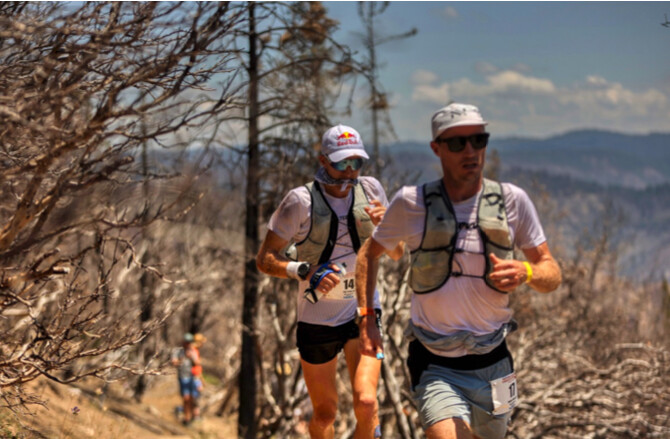
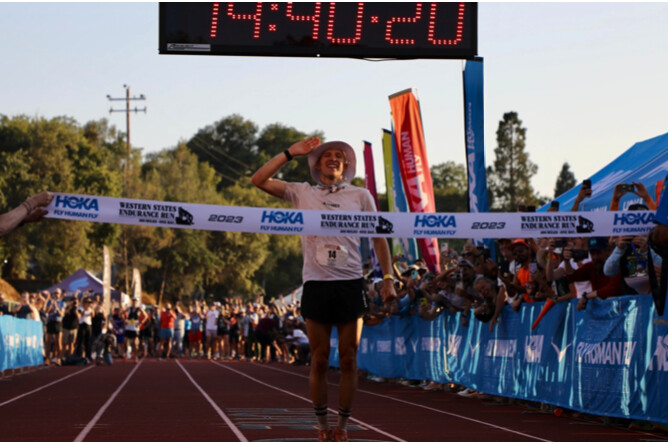
Zhao was quickly swallowed up in the next five miles to Robinson Flat, mile 30, and soon fell out of the top 10. A lead trio of Tom Evans, Dakota Jones, and Jia-Sheng Shen came into aid at 4:45, meeting their crews for the first time. At mile 30 and with Zhao falling backward, Anthony Costales (pre-race interview) was fourth, and then he was with Tyler Green at mile 38 in fourth and fifth. The two would barely separate the rest of the race.Evans and Jones dropped Shen on the climb to Devil’s Thumb, mile 48, and the two leaders came into aid together in 7:03. Four minutes back Costales had caught Shen on the big climb, and Tyler Green, Jeff Colt, New Zealand’s Daniel Jones, Ryan Montgomery, Mathieu Blanchard, and 47-year-old Ludovic Pommeret were inside the top 10. Those six were 14 minutes apart. 2022 third- and second-place finishers Arlen Glick (pre-race interview) and Hayden Hawks (pre-race interview) were back in 11th and 16th, respectively. After earlier moving up, Hawks had just lost several places and would later drop with injury at mile 55. Other top-10 finishers from 2022 Cody Lind, Scott Traer, and Alex Nichols were all noticeably outside the top 10 too.
As the race shifted to its mile-62 Foresthill hub, Evans gained some separation on Jones and entered the aid station first, but as Evans changed shoes and socks, Jones didn’t wait and exited first. Jones was now in the lead by himself for the first time and he was overheard voicing his intention to break Evans. Some 11 minutes back of those two leaders, Green and Costales were again together and in third and fourth. Shen and Jeff Colt were just minutes back of those two, and Colt was remarkably almost an hour faster than a year ago when he finished 11th.Jones and Evans separated leaving Foresthill and anticipation ran high for their next steps. The two had been together for nearly the entirety of the race to this point. Jones wanted to make a move and Evans wanted to keep up with (the) Jones. The duel ended quickly and dramatically though. Tom Evans dropped a 5:54 downhill mile and hit Cal 2, mile 71, in 10:12. That surge pushed Jones eight minutes back at mile 71. It was just nine miles from Foresthill to that split on Cal Street, but the front two had shattered and moved in opposite directions the rest of the race.
Evans ran alone to the river crossing at mile 78, and ultimately to the finish. Tyler Green, Anthony Costales, Jeff Colt, and Jia-Sheng Shen all overtook Dakota Jones on the way to the river too. Forget about Elm Street, Jones was having a bit of a nightmare on Cal Street.
Evans, the 2022 UTMB third placer, continued to put time on the field the rest of the way. He finished in 14:40 and that’s the race’s fourth fastest finish ever. The mark trails only Jim Walmsley and Jared Hazen in 2019, and Walmsley’s 2018 mark too. Evans was a runaway winner, but the rest of the top 10 was much more closely packed.Tyler Green pushed on in second, and held off an Anthony Costales chase over the last 15 miles. Green finished in 15:04. It was his second runner-up finish and a big personal best for the course. He was able to finish with his baby boy on his shoulders. Green’s 15:04 was the race’s 11th-fastest finish ever. Costales was third in 15:09, the race’s 13th-fastest finish ever.
Jia-Sheng Shen and Daniel Jones both finished fast. Shen clocked 15:19 and Jones was fifth in 15:22. Mathieu Blanchard and Ryan Montgomery both overtook Jeff Colt late. Those three — Blanchard, Montgomery, and Colt — finished in 15:37, 15:38, and 15:42, respectively. Local runner Cole Watson bettered his 2022 14th-place finish with a ninth-place 15:54.
In 2019 the top 10 all went under 16 hours. This year’s 10th-place man Janosch Kowalcyzk from Germany just missed matching that feat. He finished in 16:09.
Seven of last year’s top 10 returned, but only Tyler Green was able to again make the top 10. The 2022 top 10 finishers Ludovic Pommeret, Arlen Glick, Scott Traer, Cody Lind, and Alex Nichols finished 12th, 13th, 15th, 16th, and 28th this year, respectively. As earlier mentioned, 2022 runner-up Hayden Hawks dropped.
After running near or in the lead through Foresthill, Dakota Jones finished 17th in 17:00.
Early leader Zhao’s high risk, high reward start ended with a drop at Michigan Bluff, mile 55.
(06/25/2023) Views: 561 ⚡AMPby Justin Mock I Run Far
Western States 100
The Western States ® 100-Mile Endurance Run is the world’s oldest and most prestigious 100-mile trail race. Starting in Squaw Valley, California near the site of the 1960 Winter Olympics and ending 100.2 miles later in Auburn, California, Western States, in the decades since its inception in 1974, has come to represent one of the ultimate endurance tests in the...
more...2023 Western States 100 Women’s Preview
The 2023 Western States 100 is just around the corner and we’re here to take a look at the pointy end of this year’s women’s field. Before we get started, in case anyone needs a reminder of this unique, point-to-point, net downhill course, here are the stats for the standard course: 100.2 miles, 18,000 feet of climbing, and 22,000 feet of descending.
At the time of writing this, we don’t know if the huge snows of this winter or last year’s wildfire on the course will necessitate any significant course modifications for this year’s running. However, we know the race organization is doing everything they can to host the race on the normal course. We also know that those conditions will likely play into the competition, with snow present on the first 25 miles of the course for a spicy warm-up, as well as miles of wildfire-exposed course that’s likely to make the middle miles feel more severe than normal. And, also, we are expecting the normal race-day heat.
Last year’s race further showed how much faster the Western States women’s field has gotten in recent years. While Ellie Greenwood’s 2012 course record of 16:47 has remained untouched, 15 of the 24 fastest women’s times at the race have been logged in just its three recent races — 2019, 2021, and 2022 — with those 15 times logged by 13 different women. Ruth Croft’s 2022 winning time of 17:21 was the third-fastest women’s time ever while fifth-place Emily Hawgood’s 18:16 would have won the women’s race in all but 10 other years.
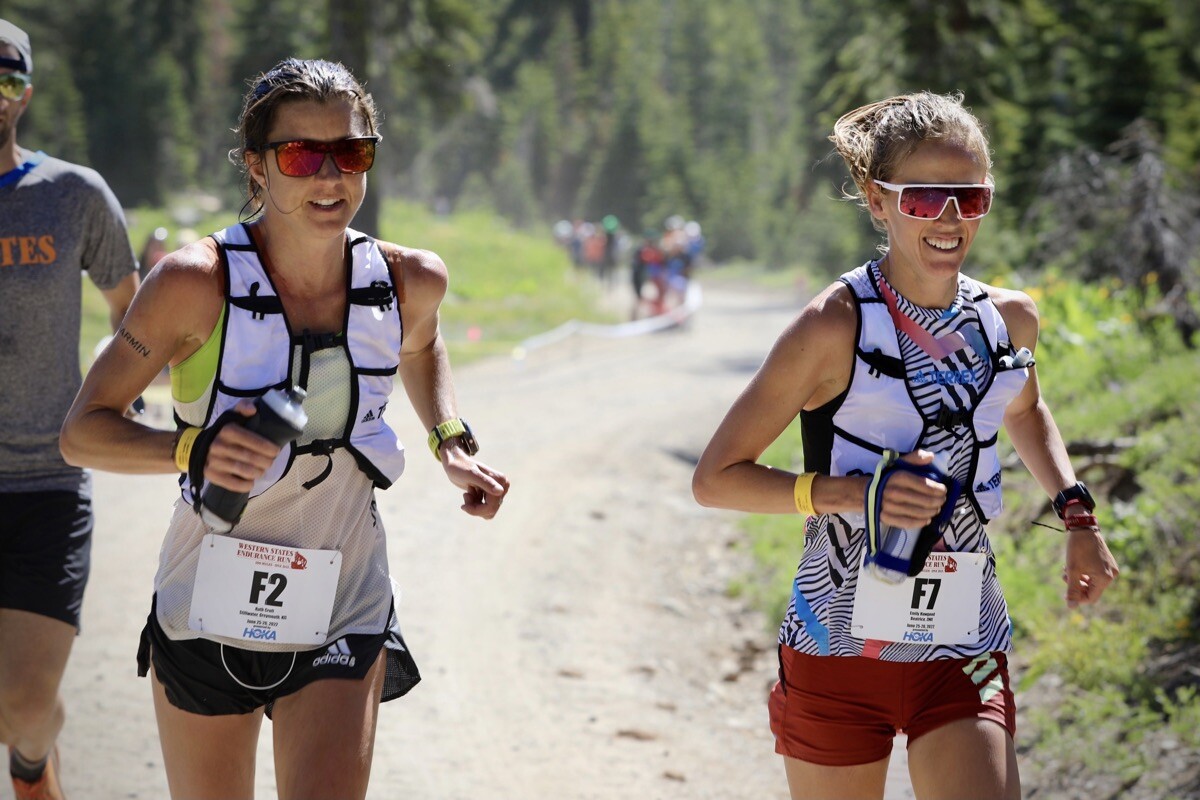
We’re in for one heck of an exciting women’s race at this year’s Western States 100. None of last year’s top-four women are returning while everyone who finished between fifth and ninth will be returning. Lining up aside those five will be another half dozen women, each of whom could make a push for the podium, including a couple of the world’s best 100-mile racers at the moment. Another dozen strong women will add to the excitement in running for the top 10.
As you’d guess, iRunFar will be there to report firsthand on all the action as it unfolds starting at 5 a.m. U.S. PDT on Saturday, June 24. Stay tuned!
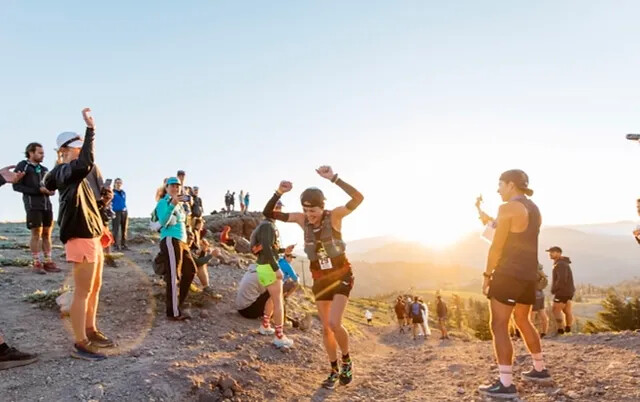
A special thanks to HOKA for making our coverage of the Western States 100 possible!
Emily Hawgood – 5th, 18:16:02
Well, look at that, Zimbabwe’s Emily Hawgood comes into the 2023 Western States 100 as the top returning women’s runner after her fifth-place finish last year. That fifth place is no fluke as over the past two years, Hawgood has been seventh at the 2021 Western States 100 as well as taking 10th and sixth at the past two UTMBs. Living over here in the U.S., she ran and won the same local 50k both last year and this February.
Leah Yingling – 6th, 18:32:31
After many years of quieter success, Leah Yingling made herself known with a great 2022 season. In addition to taking sixth at Western States in 2022, she was third at the Bandera 100k, third at the Transgrancanaria Advanced 60k, second at the Canyons 100k, and 19th at the Trail World Championships 80k. She’s started her 2023 just as strong with a second place at the Way Too Cool 50k in March and a win at the Bull Run Run 50 Mile in April.
Taylor Nowlin – 7th, 18:46:42
Although she’s run ultras since at least 2016, I’d have to say that 2022 was Taylor Nowlin’s best season to date. Not only did she take seventh in her 100-mile debut at Western States, she also took fourth at the Black Canyon 100k and ninth at CCC. We can’t find any race results for Taylor so far this year, so we’ll have to wait until race day to find out what kind shape she’s in.
Camille Herron – 8th, 18:51:54 (2022 post-race interview)
What a journey it’s been for Camille Herron at Western States! She DNFed in both 2017 and 2019 before finishing in 27:28 in 2021. She kept at it last year, finishing eighth in 18:51. I’d hypothesize that what’s sure to be a snowy course in 2023 could challenge that inspiring progression, but she’ll surely come into the race fit if her recent racing is any indication. In December she clocked 13:02 for 100 miles at the Desert Solstice races before setting the 48-hour world record of 270.5 miles this March.
(06/15/2023) Views: 619 ⚡AMPby Bryon Powell
Western States 100
The Western States ® 100-Mile Endurance Run is the world’s oldest and most prestigious 100-mile trail race. Starting in Squaw Valley, California near the site of the 1960 Winter Olympics and ending 100.2 miles later in Auburn, California, Western States, in the decades since its inception in 1974, has come to represent one of the ultimate endurance tests in the...
more...2023 Western States 100 Men’s Preview
The Western States 100 is set for 2023. The iconic point-to-point, net-downhill course takes in 100.2 miles, 18,000 feet of climbing, and 22,000 feet of descending, as it starts at the Palisades Tahoe ski resort in Olympic Valley, California, and finishes at Placer High School in Auburn.
Environmental conditions will play into the race’s competitive story this year. With record snowfall throughout the upper elevations of the Sierra Nevada, the mountain range through which the race travels, runners will encounter plenty of snow over the course’s first quarter, along with numerous high water crossings lower down as all that snow melts.
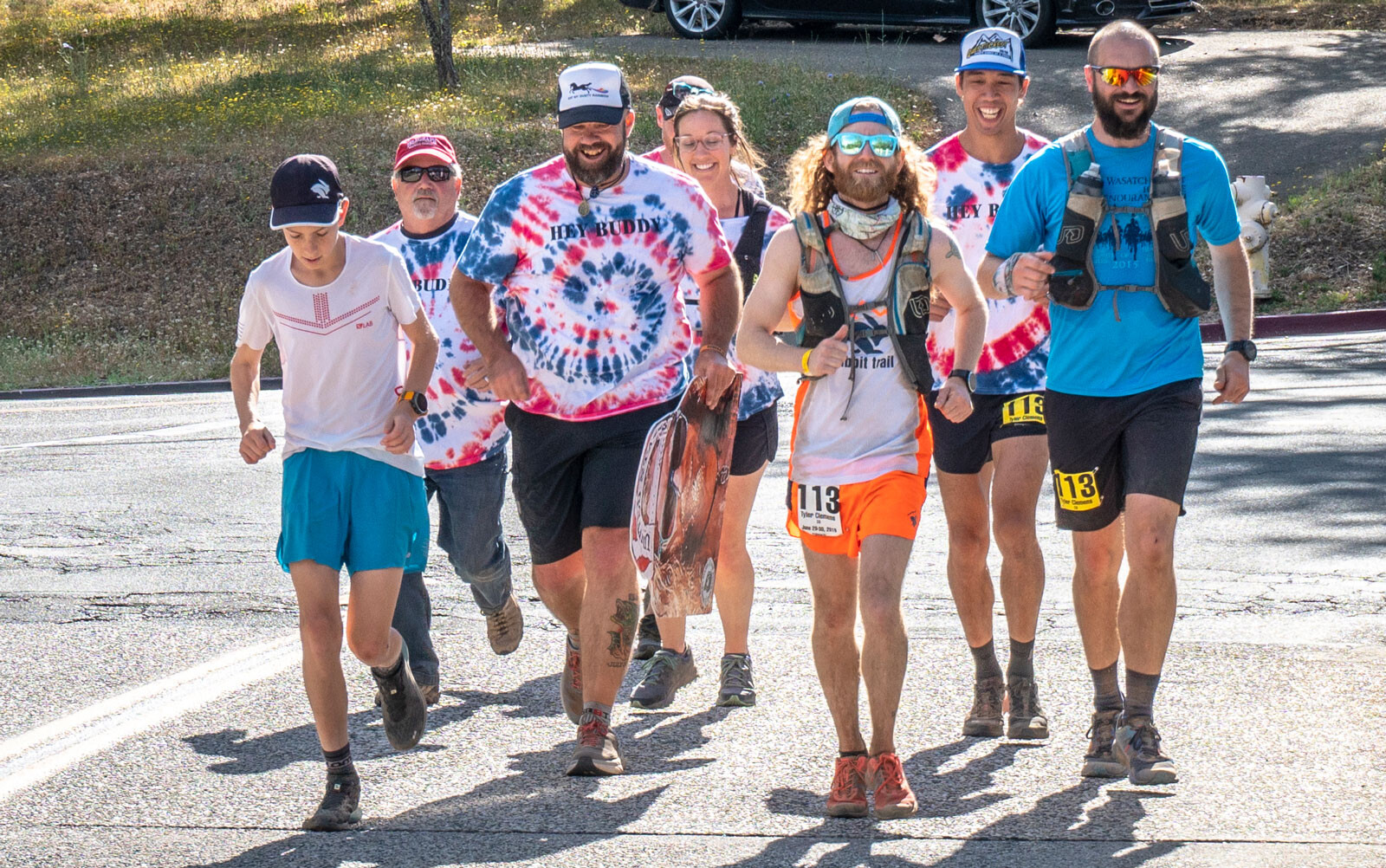
Some 16 miles of the course were burned over by last fall’s Mosquito Fire, leaving miles of shade-less terrain. And of course, there will probably be weather at play, with the event’s notorious heat likely to encompass the middle and lower elevations of the course.
The men’s race at last year’s Western States 100 was sharp, with just 50 minutes separating the first and 10th finishers. Seven of that stellar line-up are back this year, as well as some serious additions like the U.K.’s Tom Evans, French-Canadian Mathieu Blanchard, and Dakota Jones.
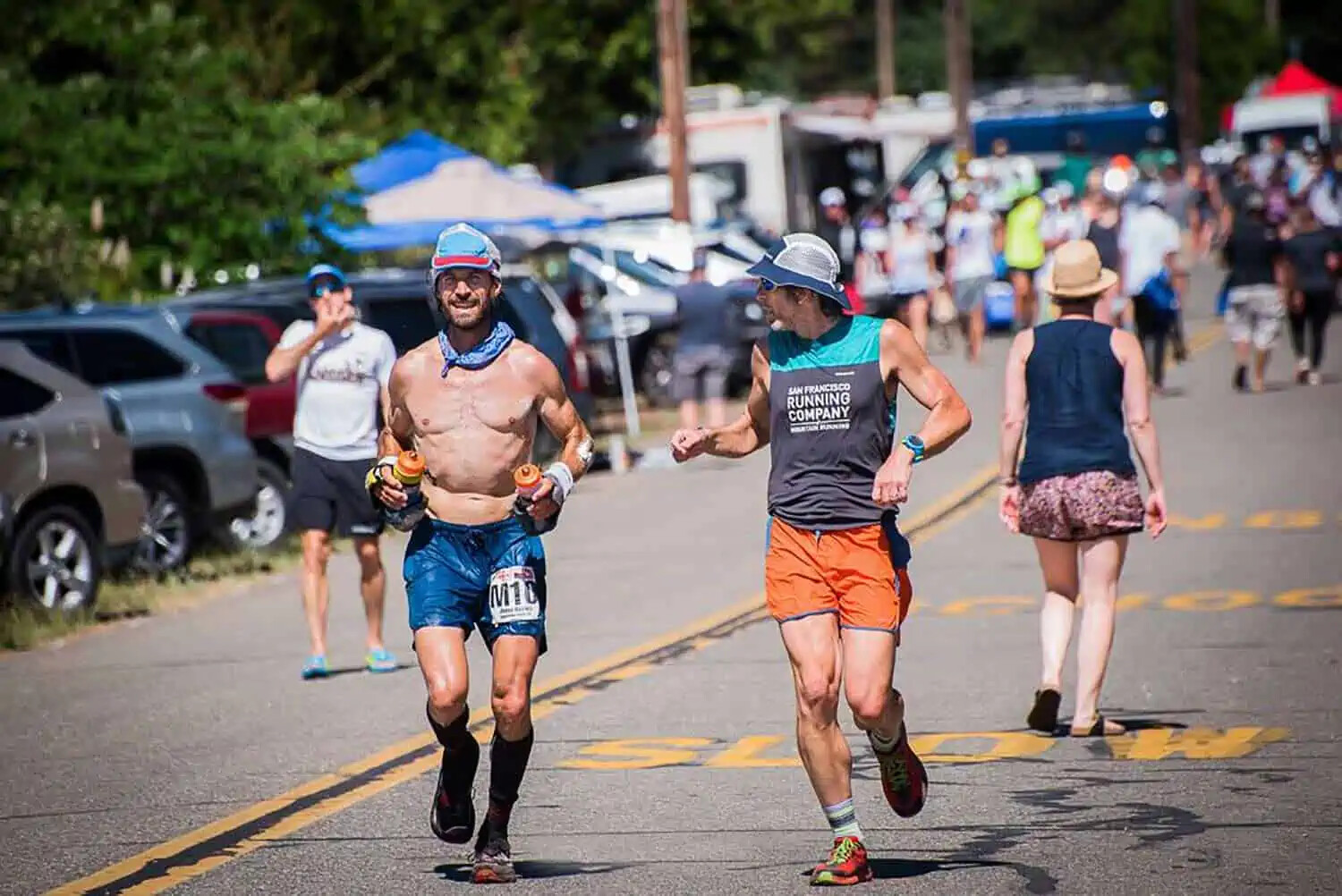
Although there are notable absentees including reigning champion Adam Peterman and course-record holder Jim Walmsley, the depth of this men’s field suggests it could be an even tighter race this year.
As you’d guess, iRunFar will be there to report firsthand on all the action as it unfolds starting at 5 a.m. U.S. PDT on Saturday, June 24. Stay tuned!
A special thanks to HOKA for making our coverage of the Western States 100 possible!
Be sure to check out our in-depth women’s preview to learn about the women’s race and, then, follow our live coverage on race day!
The top 10 runners in the 2022 race were invited to return for 2023. Unfortunately, reigning champion Adam Peterman is out with injury, and seventh-place Vincent Viet of France has opted not to return. It also looks like fifth-place Drew Holmen has withdrawn, as he just finished fifth at the Trail World Championships 80k, held in Austria 15 days before Western States.
Hayden Hawks – 2nd, 15:47:27
Last year’s second-place man, Hayden Hawks, was pretty jovial in his post-race interview about not being able to best race winner Adam Peterman. But without the reigning champion present on the start line, this could be Hawks’s year. Despite struggling with the heat last year, his finish time knocked two hours off his eighth-place finish from 2021, and there are lots of indicators that he could have more to offer on this course.
Some of his previous top performances include a 5:18 win at the 2020 JFK 50 Mile and a win at the 2018 Lavaredo Ultra Trail. So far this year, he’s warmed up by winning the Canyons 50k and taking second at the Tarawera Ultramarathon 100k.
Arlen Glick – 3rd, 15:56:17
Arlen Glick surpassed a lot of people’s expectations when he took third at Western States last year. Although he went into the race with bag of form in the 100-mile distance — having won the Javelina 100 Mile, the Mohican 100 Mile and the Burning River 100 Mile all in 2021 — this was his initiation into mountainous ultrarunning. He took to it very well, running a stormer to place third, and has since logged more mountain miles, taking second in the Run Rabbit Run 100 Mile later in 2022, before returning to the 2022 Javelina 100 Mile to place third.
Tyler Green – 4th, 15:57:10
Tyler Green took fourth at Western States last year, and forced third-place Arlen Glick into an uncomfortable sprint finish as he closed on him in the race’s final moments. In terms of placing, he was back from his second-place finish in 2021, but improved his finish time by about 14 minutes in his third go at the race. In 2019, he placed 14th in a time of 16:51, in what was a very fast year.
Following on from Western States last summer, he had a below par run at the 2022 UTMB, making it just inside the top 50, but showed he is back on form with a third-place finish at the 2023 Transgrancanaria. Last year in his pre-race interview he spoke about stepping back from his day job of teaching to focus more on track coaching and his own running, so that may have allowed him to come into this year’s race with better preparation than previous years.
Ludovic Pommeret (France)
Ludovic Pommeret, sixth at last year’s Western States, went on to inspire veteran racers everywhere with a commanding win at the 2022 TDS at age 47 — almost an hour clear of second place on the demanding route. Some of his other top performances include a win at the 2016 UTMB, where he also took fourth in 2021, and a win at the 2021 Diagonale des Fous.
He’s probably at the other end of the spectrum of Arlen Glick, in that his best performances have been on courses more mountainous than this one, but he’s still not to be underestimated.
Not many ultra-trail runners have made Kilian Jornet sweat to the degree that French-Canadian Mathieu Blanchard did at last year’s UTMB. The two battled it out all day for a close finish, in which Blanchard took second place — under the existing course record — thus earning his Golden Ticket into Western States. He’s been mixing it up a lot this year, taking second in the 146-mile Coastal Challenge Expedition Run stage race in Costa Rica, third in the Marathon des Sables, and running 2:22 in what looked like a fairly casual effort at the Paris Marathon.
(06/14/2023) Views: 574 ⚡AMPby Sarah Brady
Western States 100
The Western States ® 100-Mile Endurance Run is the world’s oldest and most prestigious 100-mile trail race. Starting in Squaw Valley, California near the site of the 1960 Winter Olympics and ending 100.2 miles later in Auburn, California, Western States, in the decades since its inception in 1974, has come to represent one of the ultimate endurance tests in the...
more...World-record holder Camille Herron lands a bird feeder after ruling the roost in her final long-distance race before Western States
U.S. ultrarunner Camille Herron broke the men’s course record at a trail marathon in Texas over the weekend, confidently capping off her last long-distance race ahead of the 100-mile Western States Endurance Run at the end of the month.
Herron finished Saturday’s 42.2-km race at the Texas Trail Running Festival in 3:49:47, beating the men’s course record by 1:41 and the women’s course record by almost 29 minutes. She completed the four-loop course at the Grelle Recreation Area trail system in Spicewood, Texas, more than 40 minutes before this year’s top men’s finisher and more than an hour before the marathon’s second-place women’s finisher. There were 10 runners in the women’s category of this year’s race and 57 competitors overall.
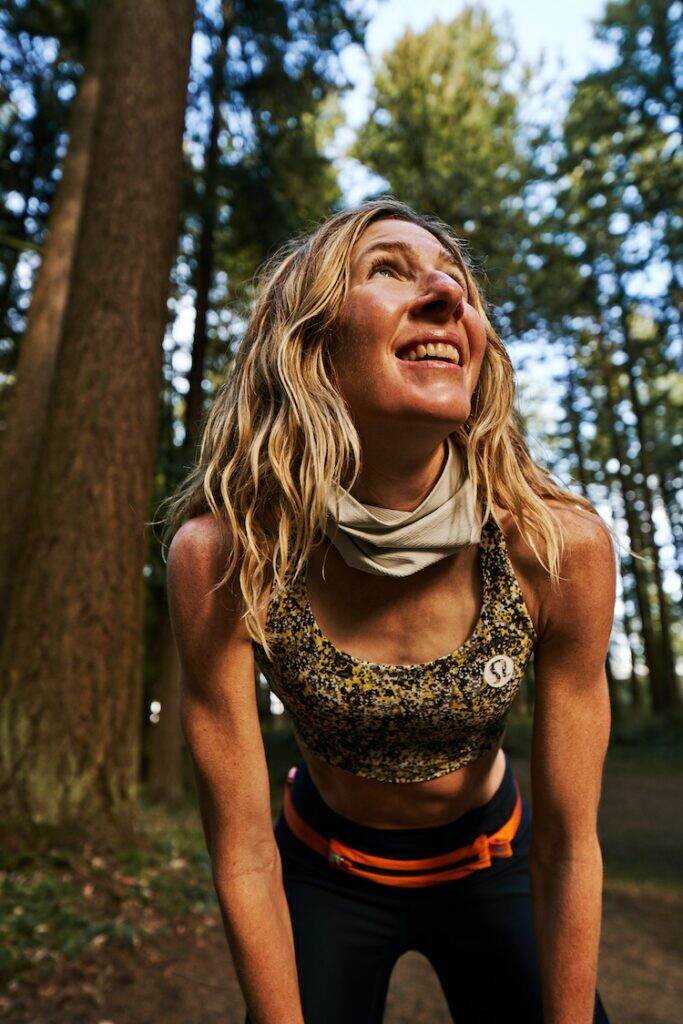
Herron proudly displayed her first-place prize—a bird feeder in the shape of a Texas Longhorn—in social media posts over the weekend. “It was a great course and good prep for Western States,” Herron wrote. “I won a really sweet bird house. Thank you @trejatrails for putting on a fun event.”
Herron, who lives in Oklahoma, wrote that it had been a few years since she’d run in Texas and that it was good to be back: “They have a great trail community—I’ll have to come back for more.”
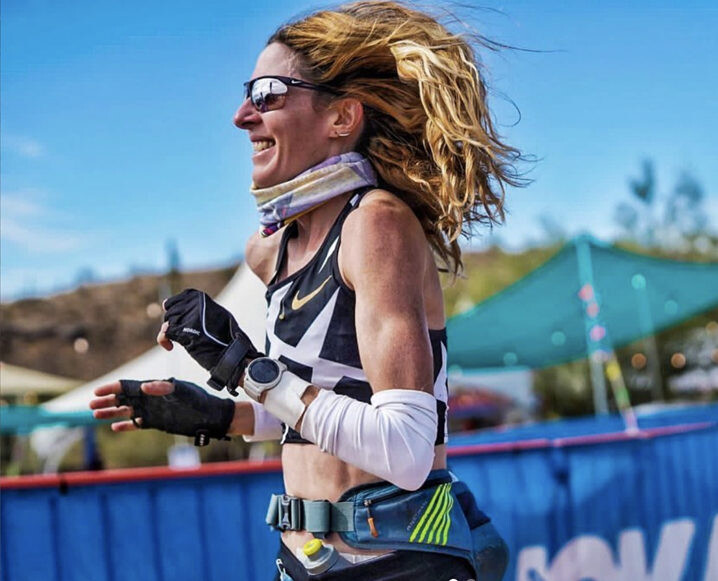
Amid the many congratulations posted in her Instagram feed, Herron was asked if Saturday’s race will be her final long run before Western States, which kicks off in California’s Olympic Valley on June 24. “Yep,” she replied, “ready to roll.”
A “roll” is exactly what Herron has been on at events large and small in 2023. The runner, who has set world records in 50-mile, 100-mile, 100-kilometer, 12-hour and 24-hour events, set the 48-hour women’s world record in Canberra, Australia in March by running 435.336km. If she’s to add to her impressive string of ultrarunning records at this year’s Western States, Herron will have to best the 16:47:19 run by Vancouver’s Ellie Greenwood in 2012. Herron cracked the top 10 in the women’s field at last year’s Western States, running 18:51:54 to place eighth.
Looking beyond Western States, Herron will be among 10 women athletes to compete in Lululemon’s recently announced Further six-day ultramarathon next March.
She noted she’ll also need to fit hanging a birdfeeder into her busy schedule, and that she’s curious to see who flocks to her newest racing trophy. “Can’t wait to see who becomes our new neighbor.”
(06/06/2023) Views: 486 ⚡AMPby Paul Baswick
Western States 100
The Western States ® 100-Mile Endurance Run is the world’s oldest and most prestigious 100-mile trail race. Starting in Squaw Valley, California near the site of the 1960 Winter Olympics and ending 100.2 miles later in Auburn, California, Western States, in the decades since its inception in 1974, has come to represent one of the ultimate endurance tests in the...
more...Gene Dykes, 75, sets seven U.S. masters records
Accomplished ultrarunner Gene Dykes, 75, looks to have set no fewer than seven U.S. masters records at a 12-hour race in his home state of Pennsylvania over the weekend, surprising himself as he pushed past health issues to pass the 100-km mark with 400 metres to spare.
The records, which have yet to be ratified by USA Track and Field, include the fastest outdoor track times in the U.S. men’s 75-79 category for 25K (2:48:33), 30K (3:24:08), 50K (5:40:39), 20 miles (3:41:28), 50 miles (9:25:10) and 100K (11:56:26), and the longest distance run in that category for a 12-hour period (100,481 metres). Dykes set the records during his 12-hour overnight effort at the Dawn to Dusk to Dawn Track Ultras in Sharon Hill, Pa., on May 13-14.
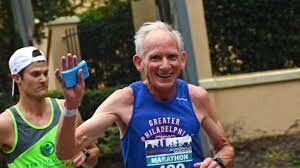
The 100K record was the most surprising to Dykes, who has broken multiple records since he took up competitive racing in his 60s. “I didn’t think I had a prayer,” he says. “It’s hard running 100K at my age. I only made it by four minutes.”
Making his latest effort even more remarkable was the fact he was battling a host of health issues on race night.
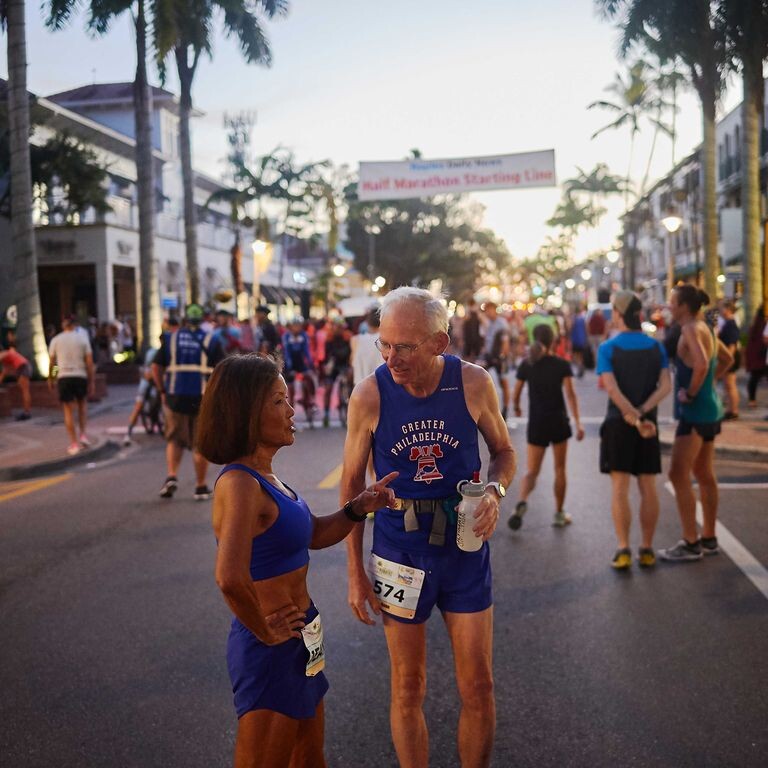
“I told people I’m battling the three C’s out here,” says Dykes. “Two weeks ago I contracted COVID, and I also had cold symptoms going into the race. Six months before I had been diagnosed with blood cancer, and that’s been really hurting my fast pace, but I have this theory that it doesn’t affect ultra paces and that seems to have really been borne out here. The only symptom I have is that I can’t breathe hard enough when I run fast, but when you’re running 12 hours, you’re never running hard. I was really happy to be able to get through 12 hours with all those health problems.”
Dykes says although he has been sitting out races recently due to health challanges, it was important for him to step up to the starting line over the weekend, as he prepares to make history next month as the oldest finisher of the 100-mile Western States Endurance Run.
“I kind of had to take a chance, because the really big race is next month,” says Dykes. “That’s a big deal. I’ve got a sponsor, and everybody’s expecting me to become the oldest-ever finisher there. So I thought, If I can’t run for 12 hours, how am I going to run for 30 hours?”
The self-described “ultra geezer” says his race on the weekend—his longest since receiving his cancer diagnosis—is a good confidence booster ahead of Western States.
“When you haven’t done something that like in a while, doubts creep in. A lot of things could have gone wrong. I could have got nauseated, I could have bonked, running out of glycogen, in which case you’re going to slow down no matter how much you want to run faster. None of those things happened. You get in this strange mindset where you just kind of dial out misery and keep on going.”
Reflecting on his latest effort with humility, Dykes says many of the U.S. masters records he set on the weekend were “low-hanging fruit,” saying he could “think of a half a dozen 75-year-olds out there” who could have set records in the 25- and 30-km distances “if they had the mind to.”
He adds, however, that he was proud to have hit the 100-km distance under the wire. “At 50 km I asked my crew to find out the new pace I would have to run over the next 50 km for the 100 km. I had to pick up from my comfortable pace. I thought I don’t care if I have no chance—I’m going to run the pace I need and keep doing it until I can’t do it anymore.’ Somehow, for seven hours I managed to keep pushing myself right up to the ending bell.”
Dykes is now looking forward to bringing that same determination to Western States on June 24-25. “It’ll be fun trying,” he says. “There are just so many ways to enjoy running. I’m really fortunate.”
(05/17/2023) Views: 569 ⚡AMPby Paul Baswick
Western States 100
The Western States ® 100-Mile Endurance Run is the world’s oldest and most prestigious 100-mile trail race. Starting in Squaw Valley, California near the site of the 1960 Winter Olympics and ending 100.2 miles later in Auburn, California, Western States, in the decades since its inception in 1974, has come to represent one of the ultimate endurance tests in the...
more...Gene Dykes hopes to become oldest Western States finisher
Gene Dykes, the record-setting 75-year-old ultrarunner from Philadelphia, will hit the trail this summer in a bid to become the oldest finisher in the history of the 100-mile Western States Endurance Run.
This year’s event, which takes place June 24-25 in Auburn, Calif., will mark the race’s 49th year.
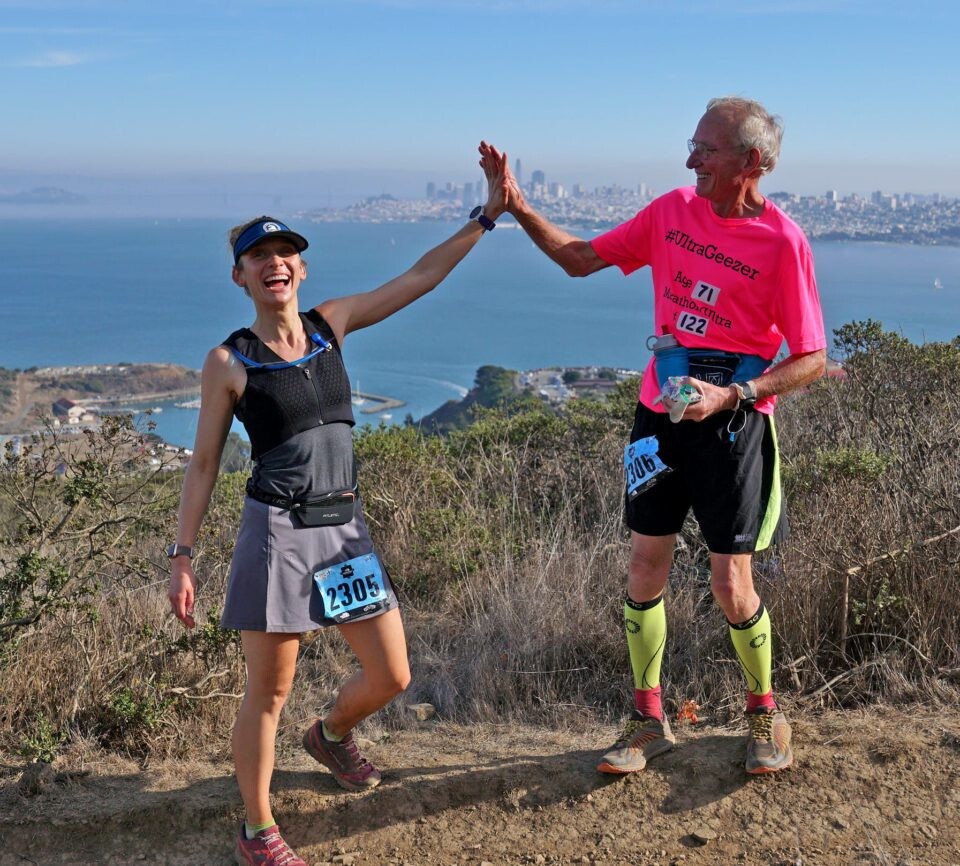
The current oldest finisher is Nick Bassett of Cheyenne, Wy., who finished the 2018 race in 29:09. (The cutoff for all finishers is 30 hours.) Bassett was 73.
A self-proclaimed “ultra geezer,” Dykes started competing in races when he was in his 60s and has since broken multiple records for his age group. In 2021, he broke the M70 50K world record at the USATF national 50K road championships in East Islip, N.Y., crossing the finish line in 3:56:43 and beating the previous record of 4:15:55, set by Germany’s Wilhelm Hofmann in 1997, by nearly 19 minutes. Dykes broke the M70 100-mile and 24-hour track records at the Dawn 2 Dusk 2 Dawn 24-hour ultramarathon in Sharon Hill, Penn., in 2019.
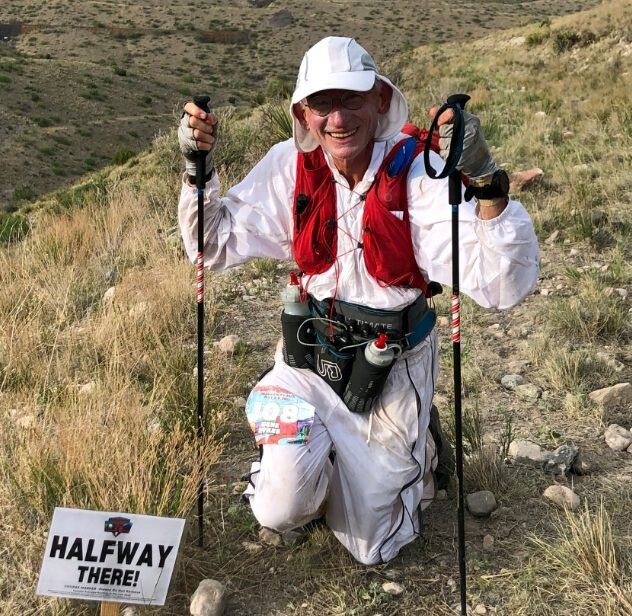
In 2018, Dykes ran his fastest marathon time—2:54:23—at age 70 at the Jacksonville Marathon in Florida. The result would have seen him take the world M70 marathon title from former record holder Ed Whitlock, but Dykes’s final time was not ratified due to the race not being a USATF-sanctioned event.
In total, Dykes has run 157 marathons and ultras since 2006. His daughter Hilary will pace him at this year’s WSER.
Dykes is being sponsored in his latest effort by Calgary-based Stoked Oats. As part of their support, the company has kicked off its Breakfast with Gene series on Instragram and YouTube. The series will feature guests including Vancouver-based WSER female record holder Ellie Greenwood, three-time WSER racer Michael Wardian and race director Craig Thornley.
In 2016, 72-year-old Wally Hesseltine made a valiant and heartbreaking attempt to break the “oldest finisher” record, but missed the 30-hour cutoff by two minutes.
“We are thrilled to be supporting Gene on his journey to WSER,” says series host and Stoked Oats founder Simon Donato. “Running 100 miles is a tall order for professional runners, let alone someone in their 70s. What Gene is trying to accomplish is truly remarkable and we’re looking forward to supporting him every record-setting step of the way.”
Western States, first run in 1974, is the world’s oldest 100-mile trail race and one of the most prestigious. Each June, 369 runners from across the United States and around the world embark from the start line in Olympic Valley, Calif., to tackle a challenging course to the coveted finish line at Placer High School in Auburn.
(04/26/2023) Views: 487 ⚡AMPby Paul Baswick
Western States 100
The Western States ® 100-Mile Endurance Run is the world’s oldest and most prestigious 100-mile trail race. Starting in Squaw Valley, California near the site of the 1960 Winter Olympics and ending 100.2 miles later in Auburn, California, Western States, in the decades since its inception in 1974, has come to represent one of the ultimate endurance tests in the...
more...Western States 100 aims for inclusivity in updated policies for transgender, non-binary, and pregnant athletes
One of the oldest and most respected ultratrail races in the world has taken a further step at making their race more inclusive. On Wednesday morning, the board of Western States Endurance Run (WSER) released policy updates around transgender and non-binary entrants, as well as an updated pregnancy deferral policy.
WSER says that these new rules align with their “goal of ensuring fair and inclusive practices that respect the personal rights and dignity of transgender and nonbinary entrants while preserving the integrity of competition for awards and records.”
In October, Riley Brady became the first ever non-binary athlete to secure a golden ticket to WSER, finishing second at Javelina Jundred 100-mile race. While Ultrasigup allows runners to choose from three gender categories, it was the first time that Javelina Jundred organizers had included a non-binary division. An already urgent and important conversation about the need to expand inclusivity in ultrarunning–and inclusivity in general in the sport–became heightened after Brady’s remarkable performance.
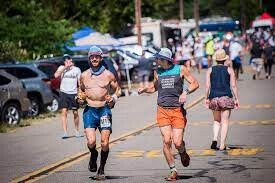
In an article Brady coauthored with coach David Roche in trailrunnermag, Brady explains: “Leading up to Javelina, I had emailed the race directors to inform them that I was seeking a Golden Ticket, which the race organization asks you to do. On my Ultrasignup page, I have indicated my gender as ‘nonbinary’ and my division as ‘female.’
As this was the first year Javelina had a non-binary division, the live results updates defaulted to the gender category. “As I understand it now, that misunderstanding may have contributed to some confusion online after the race, even as I emailed them in advance and followed the rules at every step,” shared Brady.
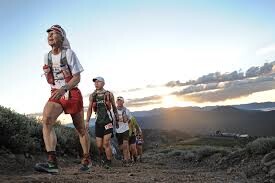
While WSER already had policies in place for transgender athletes, they have now clarified and updated those regulations, as well as added clear rules for non-binary entrants and an updated and more inclusive pregnancy deferral policy.
Updates for transgender athletes
Transgender women can register to compete in the female category, provided they have been undergoing continuous, medically supervised hormone treatment for gender transition for at least one year prior to the race, or in the male category with no restrictions.
Transgender men can register to compete in the male or female category, unless they are undergoing hormone treatment related to gender transition that includes testosterone or any other banned substance in which case they must register in the male category.
Policy for non-binary athletes
During registration all entrants will have the opportunity to select their gender category–male, female, or non-binary. Entrants who select nonbinary will also need to choose a category (male or female) for results and awards.
Non-binary entrants who are male-assigned at birth must select male as their category for results and awards, unless they meet the requirements for transgender women to compete in the female category under this policy.
Non-binary entrants who are female-assigned at birth can choose the female or male category for results and awards, unless they are undergoing hormone treatment related to gender transition that includes testosterone or any other banned substance, in which case they must select the male category.
Pregnancy deferral policy update
In order to defer a race entry due to pregnancy, entrants must submit a pregnancy entry deferral request in writing to the race director no later than one pm on the Friday before the race, as well as provide written confirmation of the pregnancy signed by a physician or medical professional.
The pregnancy deferral policy applies to anyone with a race entry who is pregnant at the time they enter the lottery and gets selected, becomes pregnant after the lottery and prior to race day regardless of how they obtained their race entry (lottery, sponsor etc.), or is an automatic entrant (top ten, golden ticket, etc.) and becomes pregnant or gives birth after obtaining their race entry and prior to race day.
(12/01/2022) Views: 685 ⚡AMPby Keeley Milne
Western States 100
The Western States ® 100-Mile Endurance Run is the world’s oldest and most prestigious 100-mile trail race. Starting in Squaw Valley, California near the site of the 1960 Winter Olympics and ending 100.2 miles later in Auburn, California, Western States, in the decades since its inception in 1974, has come to represent one of the ultimate endurance tests in the...
more...Wildfire in California causes thousands to evacuate, impacts Western States course
The Mosquito wildfire, which began west of Lake Tahoe amid extreme heat on Sept. 6, is the largest fire currently burning in California. The blaze has already burned through 58,544 acres in El Dorado and Placer counties.
Western States Endurance Run (WSER), one of the most famous ultra trail races in the world, sits right in Mosquito’s path. Runners begin the annual, much-revered 100-mile race in Auburn, and finish on the track at Placer High School.
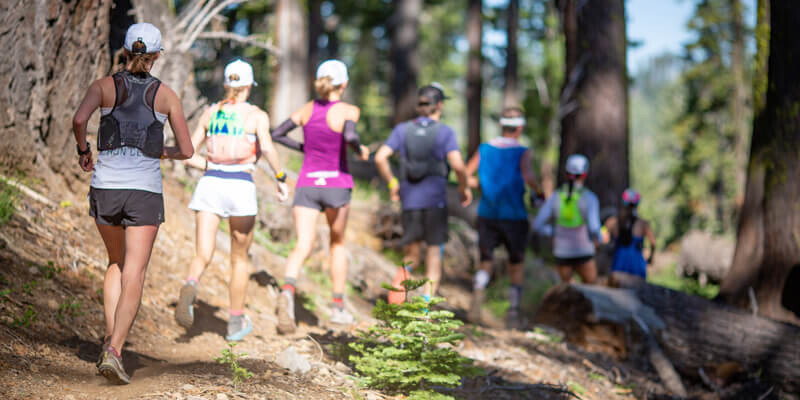
On Tuesday afternoon the fire flared up, pushing toward the community of Foresthill and arriving at the edge of Foresthill High School, blazing through structures across the street. Firefighters appear to have kept the fires away from the high school, but it’s not clear how many cars and structures were consumed in the flare-up.
We connected with Craig Thornley, race director of WSER, on Tuesday. “Lives and homes are the highest priority right now. The WSER trail and our race is a lower priority,” Thornley said.
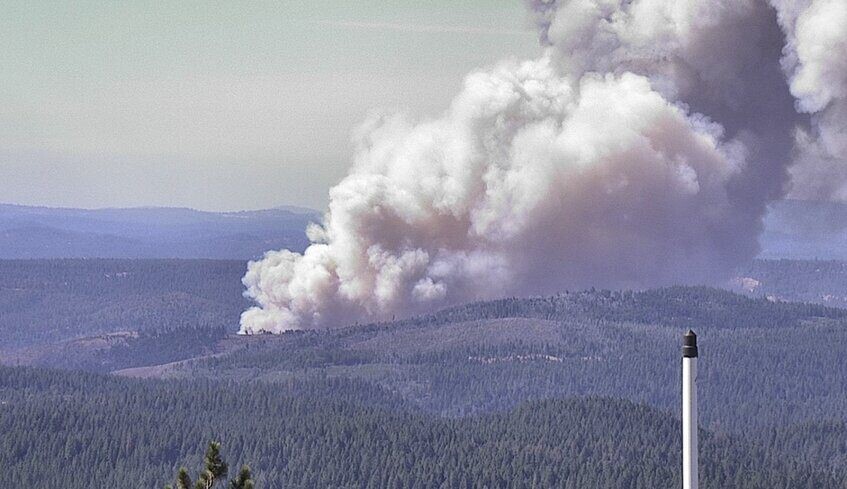
“That said, eventually the fire will be contained and the US Forest Service will be able to go in and assess the damage to the WS trail and the bridges. Currently, the fire has affected the trail as far up as Devil’s Thumb [aid station] through El Dorado Canyon and Michigan Bluff, to the turnoff onto the single track from Chicken Hawk. That’s about 10 miles of trail. It still could burn up towards Last Chance and Dusty Corners, but it is unclear what effect the burn scar will have on fire growth,” added Thornley.
The flames have forced more than 11,200 people to flee as they encroach on homes and buildings, burning 64 structures by Wednesday including at least 25 homes, according to Cal Fire. The fire grew more than 8,000 acres overnight and is spreading through the Sierra Nevada mountains.
“It continues to push steadily to the east in heavily forested areas with extremely dry vegetation,” officials said Wednesday morning. There is some optimism, however, as firefighters have the fire now 20 per cent contained.
(09/15/2022) Views: 459 ⚡AMPby Keeley Milne
Stay cool on your next run with these three tricks, use these tips to keep your core temperature down
If you’re training for a summer race this year, you’ll want to prepare for that event by exercising in the heat, as unpleasant as it sometimes may be. Heat training will pay off, especially if race day is warmer than expected. There are ways to keep the heat from getting to you, especially during longer runs. Your goal is to keep your core body temperature down while staying aware of the signs of heat-related illnesses. Use these three tips to keep your body temperature down on your next hot-weather training session.
Choose your clothing wisely

Make sure you’re wearing light-colored clothing, in a sweat-wicking material, polyester, or polypropylene. Cotton attire may feel cool at first, but will get heavy and uncomfortable once you add sweat. Wearing a hat you can dip in water will keep your head (and core, as a result!) cool, and feels nice as well. Chris Kostman, race director of the Badwater 135 ultramarathon in Death Valley, Cali., has more than a little experience with hot-weather events. In an interview with GearHub Kostman suggested spritzing your clothes with water before setting out: you’ll cool as the water evaporates.
Have a cold drink before you start, and keep drinking
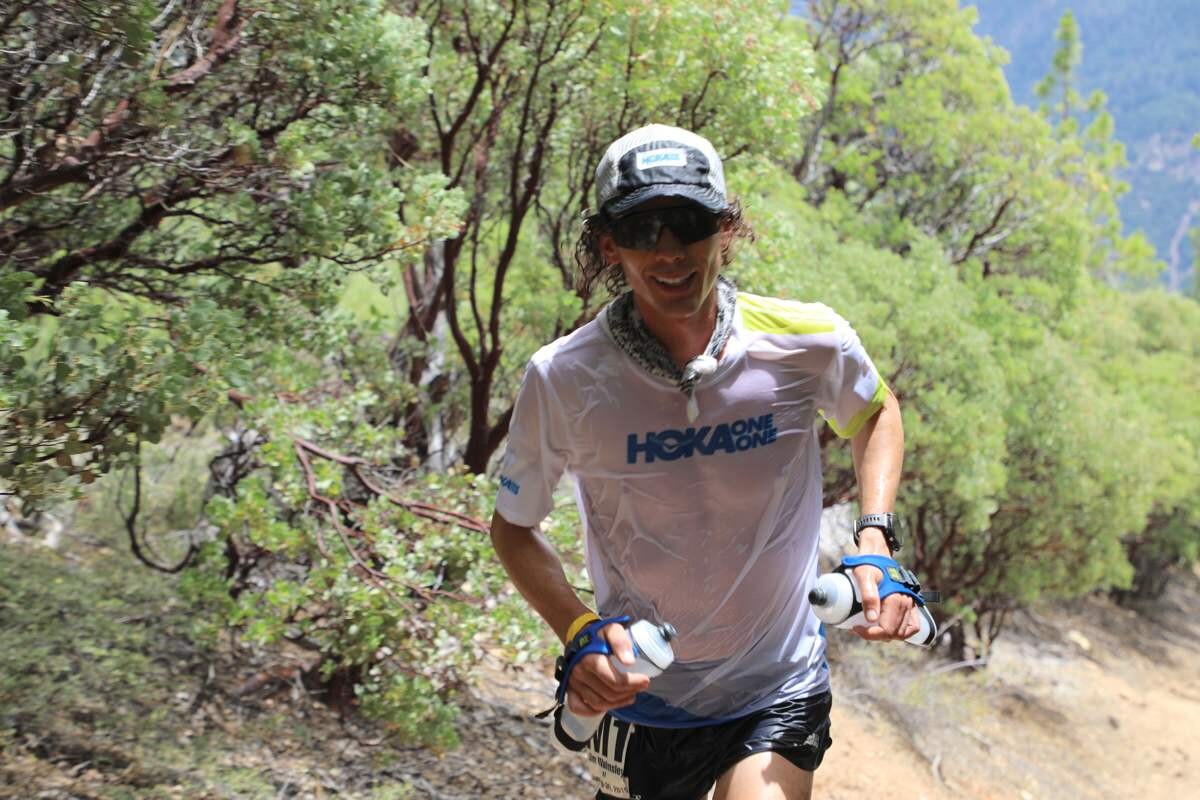
Staying hydrated is essential during the hot months. Not only will it help prevent potentially life-threatening ailments like heat exhaustion and heat stroke, but it will also keep you feeling better and running faster. When we get dehydrated, our blood thickens, increasing our heart rate through a process called cardiac drift. Being mindful of how much you are drinking before, during, and after your outdoor workout is important. Studies show that drinking something partially frozen before exercising can keep your body temperature down for even longer than simply imbibing a cold drink, so stick that sports drink in the freezer before your run so that it’s icy. If you find you’re taking in a lot of water, or you’re participating in a long, hot endurance event, make sure that you’re also taking in electrolytes and sodium so that you replenish what you’re sweating out and avoid conditions like hyponatrema.
Learn from the pros: ice, ice, everywhere
The recent Western States 100-mile race reportedly had 5 pounds of ice, per athlete, per aid station. Ultrarunners at these warm races have devised techniques to wear the ice all over their bodies, and no matter the distance of your next hot training run or race, you may want to try some of their efficient ways to beat the heat. Fill a bandanna or tube sock with ice and tie it around your neck. The icy water it releases as you continue will keep you cool as you move. Sticking a baggie of ice into your hat can work as well, or wearing sleeves that you stuff with ice cubes and allow to melt.
The most important thing during hot-weather runs: take the signs of heat exhaustion seriously. If you’re very hot but aren’t sweating, you have a throbbing headache that doesn’t abate or you start to feel unwell, get inside, cool your body down, and monitor your symptoms.
(07/04/2022) Views: 903 ⚡AMPby Keeley Milne
Western States 100
The Western States ® 100-Mile Endurance Run is the world’s oldest and most prestigious 100-mile trail race. Starting in Squaw Valley, California near the site of the 1960 Winter Olympics and ending 100.2 miles later in Auburn, California, Western States, in the decades since its inception in 1974, has come to represent one of the ultimate endurance tests in the...
more...2022 Western States 100 Men’s Race
This year’s men’s race had the notable absence of course record holder Jim Walmsley, who has dominated the race in recent years, leaving it wide open for a good number of runners with potential to win. Among them were seven of last year’s top 10, including second-place finisher Tyler Green, and Tim Tollefson, who was fifth last year but hotly fancied to be capable of winning this race on a good day. Last year’s eighth place man, Hayden Hawks, who ran Western States as his debut 100 miler, was also believed to have more to offer in this race.
Notably, joining them as a Golden Ticket entrant was Jared Hazen, the second fastest Western States finisher of all time.
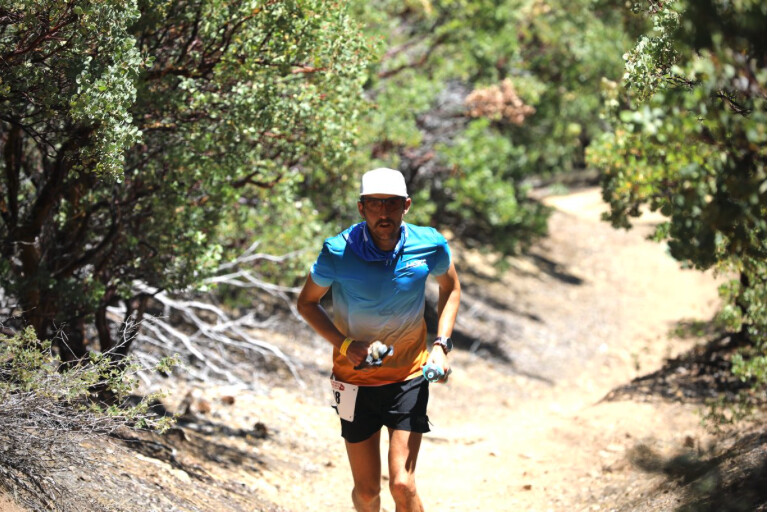
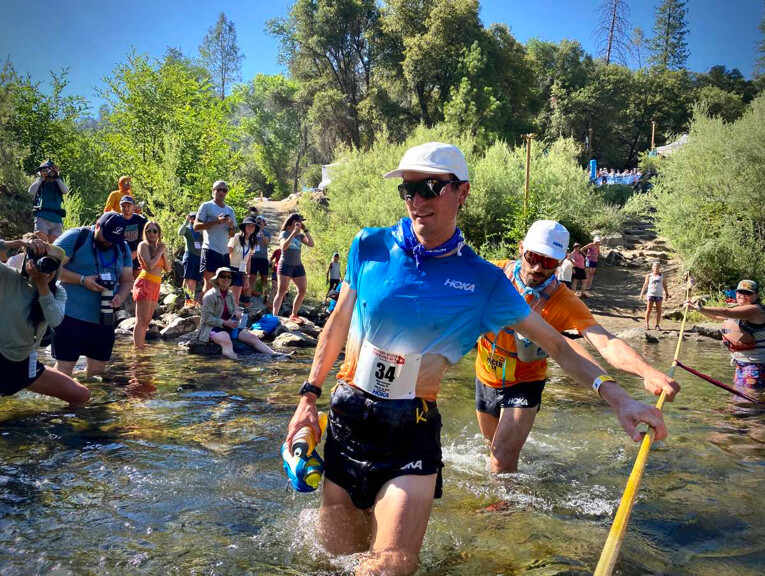
And last but certainly not least, the relative new kid on the block, who has quickly shot up through the distances and dominated every ultra he’s ever started — Adam Peterman.
Peterman won his way into Western States at the Canyons by UTMB 100k, where he toppled the course record in his first ever 100-kilometer race. He took a gamble by taking on his first 100 miler a little over two months later, and defended the decision to iRunFar in his pre-race interview saying: “I don’t feel like I always need to just make logical steps because we’re running 100 miles, that’s an illogical game.”
The first 3.5 miles of Western States features 2,550 feet of climbing, to the first landmark at the Escarpment. First to the top was Adam Kimble, closely followed by France’s Ludovic Pommeret — with Hawks, France’s Seb Spehler, and Hazen coming through in quick succession.
Tollefson, Tom Owens (U.K.), Peterman, Jonathan Rea, and Alex Nichols completed the front 10, all within a couple of minutes of each other.
By Lyon Ridge at mile 10, Ludovic had taken the lead and he came through Red Star Ridge at mile 15, four minutes clear of Spehler in second, with Kimble in third, and Hawks and Tollefson a few minutes back, followed by Hazen, Peterman, and Arlen Glick. Nine minutes separated the first eight runners to this point.
The two Frenchmen held the top positions into mile 24, just before Duncan Canyon, with Pommeret coming through six minutes off course record pace. At this point Tollefson had moved up to third and Hawks and Peterman sat comfortably in fourth and fifth, 8:10 back from the lead, with Glick following 10 seconds behind.
Pommeret held the lead into Robinson Flat, mile 30, with the pressure starting to show. Hawks had moved up to second by now and was looking a lot more comfortable, just two minutes back from the leader. Peterman had then moved up the field also to third position, just in front of Spehler, who’d dropped back to fourth, with Tollefson seconds behind. This chasing pack were just four-and-a-half minutes off the leader.By Millers Defeat at mile 34, Hawks had closed the gap to a minute, and by Dusty Corners, mile 38, he’d taken the lead from Pommeret.
Through Deadwood Cemetery, mile 49.5, Hawks maintained the lead and looked like he was having a super day. There had been some reshuffling in the other top positions, with Peterman, Hazen, and Glick all still in the mix.
By Foresthill, mile 62, Hawks was still in the lead but Peterman had separated himself from the other chasers in second. He arrived just three minutes back from Hawks and almost eight minutes clear of Hazen in third. Spehler, who had a promising first half, had dropped back the field suffering stomach issues, and Tollefson had also fallen back from the front runners.
Hawks was still in the lead after Foresthill, but by Cal 2, mile 70, Peterman had joined him at the front and the race was on! Hazen held third place, 14 minutes back from the leaders, with Glick in fourth another 15 minutes back from Hazen.
When the race reached the Rucky Chucky river crossing at mile 78, Hawks still looked comfortable but Peterman had stretched four minutes ahead, putting 30 seconds per mile on his opponent since Cal 2, showing unbelievable strength and determination for a 100-mile debut.
Hazen maintained third position, now 24 minutes off the lead, with Glick and France’s Vincent Vietmaking up the front five.
Hazen had started to struggle and dropped out at mile 85, with Glick moving up to third. Peterman had by now extended his lead to 10 minutes.
The top three positions remained unchanged for the remainder of the race, but Peterman utterly dominated in the closing miles, finishing in 15:13:48, almost 34 minutes clear of Hawks in 15:47:27. Glick rounded out the top three in 15:56:17.
t’s clear from this 100-mile debut that we will be seeing a lot more of Adam Peterman. He executed this win in a similarly patient manner to his win at the Canyons 100k, and he races like a runner with a lot more ultrarunning experience than he has.
Moving up all race again, Green ended the day in fourth position in 15:57:10, what was two places back but some 13 minutes faster than his debut at this race last year. Drew Holmen (pre-race interview) finished fifth after a strong, all-day performance. His 16:09 finish this year is also two places back but 14 minutes faster than last year. These two gentlemen have much in common.
Frenchman Pommeret stayed strong to finish in sixth place and first masters, and he was closely chased by fellow Frenchman Viet. Nichols moved up two spots this year to take eighth. Cody Lind moved back from fourth last year to ninth this year. And Scott Traer meted out his race effort perfectly to run his way into the men’s top 10 for 10th place.
Men’s DNFs included Spehler and Hazen, both due to various physical issues.
(06/26/2022) Views: 900 ⚡AMPWestern States 100
The Western States ® 100-Mile Endurance Run is the world’s oldest and most prestigious 100-mile trail race. Starting in Squaw Valley, California near the site of the 1960 Winter Olympics and ending 100.2 miles later in Auburn, California, Western States, in the decades since its inception in 1974, has come to represent one of the ultimate endurance tests in the...
more...2022 Western States 100 Women’s Race
Last year’s winner Beth Pascall was absent from the start list for 2022, but there was still plenty of talent toeing the line. Six of last year’s top 10 made the final starting list, including hot favorite and previous second-place finisher, New Zealand’s Ruth Croft and last year’s seventh-place woman Emily Hawgood, who was believed to be capable of ruffling some feathers on her second attempt.
Outside of the returning top runners, this year’s start list also featured 100-mile world record holder Camille Herron, former podium finisher Lucy Bartholomew (Australia), and second-place woman at last year’s UTMB, France’s Camille Bruyas.
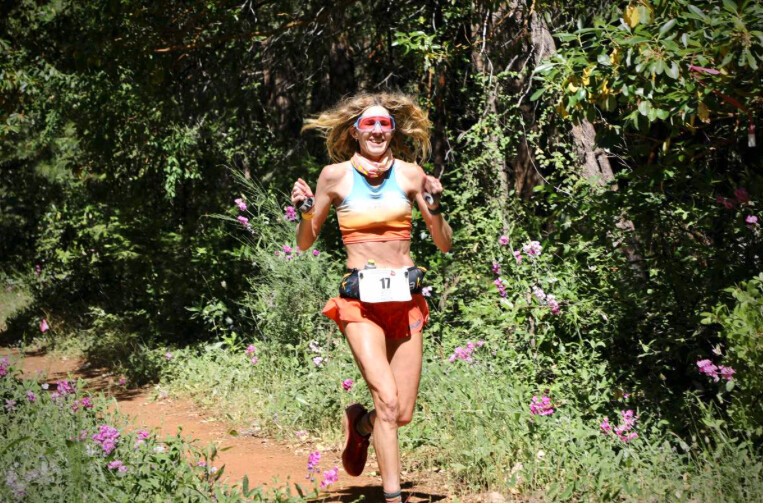
Herron was first to the top of the Escarpment, the race’s high point at mile 3.5, with Ellie Pell hot on her heels. They were followed by Keely Henninger, Poland’s Dominika Stelmach, Katie Asmuth, Canada’s Marianne Hogan, Lindsey Hagen, and Camille Bruyas, all within a couple of seconds of each other. Hawgood followed along in ninth position, followed by Switzerland’s Luzia Buehler in 10th.
The race had yet to space out at Lyon Ridge at mile 10, with Stelmach, Herron, and Hogan coming in together, closely followed by Henninger, Hawgood, Asmuth, and Pell.
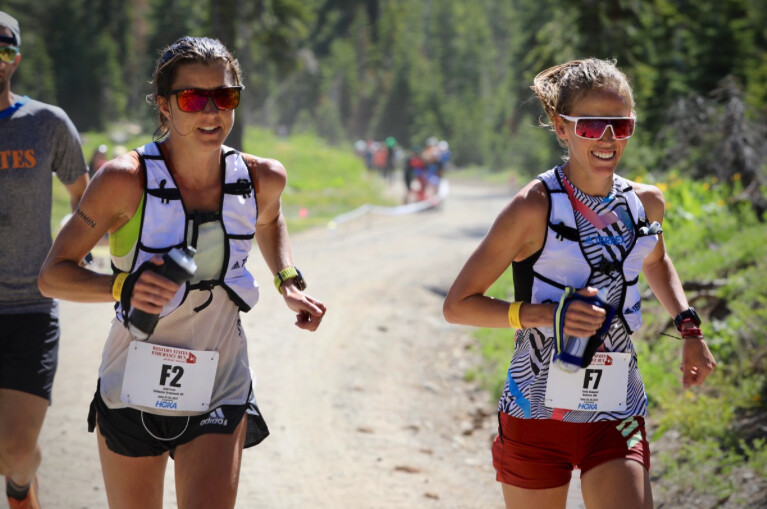
By Red Star Ridge at mile 15, Croft had begun to make her presence felt and climbed up the field to fourth position. Hogan led the field into Duncan Canyon, mile 24, just 20 seconds clear of Stelmach in second, then Hawgood, Henninger, and Croft.
By Robinson Flat, mile 30, Hawgood and Croft had moved up to share the lead and they continued to run together through mile 38, which they passed just under course record pace. Stelmach followed about 90 seconds back in third, a minute clear of Henninger in fourth. Herron had moved back to seventh position but still looked good.
The two leaders were still together at Devil’s Thumb, mile 47, but shortly after Croft managed to break away and ran through Deadwood Cemetery, mile 49.5, seven minutes back of course record pace. Hawgood came through just 30 seconds later, still looking happy and fresh and Henninger looked strong in third, 1:15 back from Croft.
The top two remained the same through mile 62, Foresthill, but Herron had begun to fight back and moved up to third position, about 18 minutes back from the leader and four minutes clear of Ailsa Macdonald in fourth. By the Rucky Chucky river crossing, mile 78, Croft had further extended her lead, but the real action was taking place behind her, with Macdonald making moves and climbing up to second place, 24 minutes back from Croft and three clear of Hawgood. Then with 10 miles to go at Quarry Road, Marianne Hogan, who had never been too far out of the frame, made a push and climbed up to third position.
Croft sealed the deal with a 17:21:30 finish to take the win, the third fastest women’s time on record. Macdonald finished impressively close, just 25 minutes back in 17:46:46. Marianne Hogan took the final podium spot in 18:08:32, less than three minutes clear of Buehler in fourth, in a race that really wasn’t over ‘til it was over.
Hawgood, who ran a brave race, finished fifth in 18:16:02, almost an hour better than her previous time. We expect there will be more to come from her if she takes her place on the 2023 start line.
Leah Yingling was sixth in 18:32:31, and Taylor Nowlin, who had a strong second half, took seventh in 18:46:42. Herron, who’s had bad luck in this race before, had a strong eighth place finish in 18:51:54 and Asmuth and Bruyas rounded out the top 10 in 19:30:26 and 19:34:24 respectively. Overall, 11 women broke 20 hours this year, with Anne-Marie Madden finishing just outside the top 10 in 19:38:44.
Women’s DNFs included Bartholomew and Henninger, both due to injury.
(06/26/2022) Views: 820 ⚡AMPWestern States 100
The Western States ® 100-Mile Endurance Run is the world’s oldest and most prestigious 100-mile trail race. Starting in Squaw Valley, California near the site of the 1960 Winter Olympics and ending 100.2 miles later in Auburn, California, Western States, in the decades since its inception in 1974, has come to represent one of the ultimate endurance tests in the...
more...Canadian Reid Coolsaet set to run the 2022 Western States 100
The lotteries for the 2022 Western States 100 and Hardrock 100 took place this weekend, and Canadian Olympian Reid Coolsaet got his name on the Western States list. With over 8,000 applicants vying for only 340 lottery spots (221 for Western States and 119 for Hardrock), runners without automatic entry have a slim chance of having their names pulled, but 34 lucky Canadians got a spot on the start lines.
Western States
Of the top 10 male finishers at last year’s race, eight will be making their return to Olympic Valley, Calif., including second- and third-place finishers Tyler Green and Drew Holmen. Jim Walmsley, who won the race in 2018, 2019 and 2021 (the race was canceled in 2020 due to COVID-19), has not elected to return for the 2022 race. The top three podium finishers from last year’s race, Beth Pascall of the UK, Ruth Croft of New Zealand and Ragna Debats of the Netherlands, will all be returning, as will six more of the top 10 women from 2021.

Canada’s Ailsa MacDonald received automatic entry, thanks to her 13th-place finish at the 2019 Western States and first-place finish at the 2020 Tarawera 100 Mile. Other fast runners who have received automatic entry include Sébastien Spehler (second at Ultra Trail Cape Town this year), Tom Owens (fourth at UTMB in 2019), Cole Watson (third at the Javelina Jundred), Stephanie Auston (third at the 2020 Black Canyon 100K and second at the 2019 Tarawera 100K) and Zoë Rom (third at the 2021 Rio del Lago 100 Mile and third at the 2021 Tillamook Burn 50 Mile), among others.
Coolsaet will be one of the top Canadians in the race, despite being relatively new to the ultramarathon scene. In August, he won his first-ever ultra, the Quebec Ultra Trail 110K, despite missing a turn and having to run an extra 10 kilometres. He will be joined by several other Canadians, including:
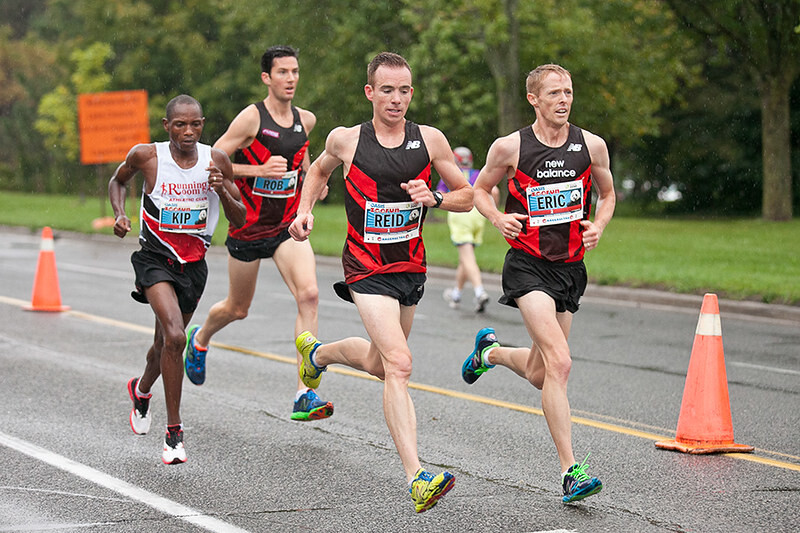
Leo Fung, Calgary
Jesse Hulley, Calgary
Mike Jollie, Calgary
Kevin Jansen, Calgary
Rohan Aurora, Vancouver
Steve Day, North Vancouver
Adam Harris, Squamish, B.C.
Patrick Humenny, Kimberly, B.C.
Ricardo Tortini, Port Moody, B.C.
Dawson Mossman, New Maryland, NB
Aytug Celikbas, Oakville, Ont.
Matt Lowe, Hamilton
Derek Mulhall, Tecumseh, Ont.
Norman Nadan, Orangeville, Ont.
James Swartz, Toronto
Vincent Gauthier, St-Zotique, Que.
Fanny Barrette, Calgary
Tara Chahl, Edmonton
Chelsey Topping, Lethbridge, Alta.
Kelly Haston, Toronto
Karen Holland, Kimberly, Ont.
Hardrock 100
Hardrock is particularly difficult to get into, because the only way to gain automatic entry into the race is by winning it the previous year. A unique addition to this year’s lottery: entrants who were chosen for last year’s race but were unable to travel because of COVID-19 were given automatic entry for 2022, which included 16 men and two women.
There are some big names on the 2022 start list, including Courtney Dauwalter, Sabrina Stanley, Magie Guterl, François D’Haene, Kilian Jornet, John Kelly, Luke Nelson and Jeff Browning. Canada’s Stephanie Case, who was the first woman (and third overall) at the 450km Tor des Glaciers race in Italy, will also be on the start line.
Other Canadians who received entry into Hardrock include:
Suzanne Johnson, North Vancouver
Dana Samis, North Vancouver
Joanna Ford, Calgary
Larry Kundrik, Lethbridge, Alta.
Ken Legg, Powell River, BC
Randy Duncan, Victoria, BC
Christopher Aubrey, Sherwood Park, Alta.
Nathaniel Couture, Fredericton, NB
Matthew Fortuna, Oyama, BC
Leo Fung, Calgary
(12/06/2021) Views: 1,214 ⚡AMPby Brittany Hambleton
Western States 100
The Western States ® 100-Mile Endurance Run is the world’s oldest and most prestigious 100-mile trail race. Starting in Squaw Valley, California near the site of the 1960 Winter Olympics and ending 100.2 miles later in Auburn, California, Western States, in the decades since its inception in 1974, has come to represent one of the ultimate endurance tests in the...
more...Jim Walmsley wins his third consecutive Western States 100
On an exceptionally hot day in California, Jim Walmsley won his third consecutive Western States 100 title Saturday in 14 hours, 46 minutes. Walmsley came through the Pointed Rocks aid station at mile 95 with a comfortable lead of about 81 minutes, and the live webcam followed his final mile by bike.
Walmsley, who lives in Flagstaff, Ariz., had admitted earlier in the week that he hadn’t been entirely healthy throughout his build up and had been nursing an IT band injury, leading to speculation that he might not even make it to the start line, but apparently he had nothing to worry about, as his remarkable result proved.
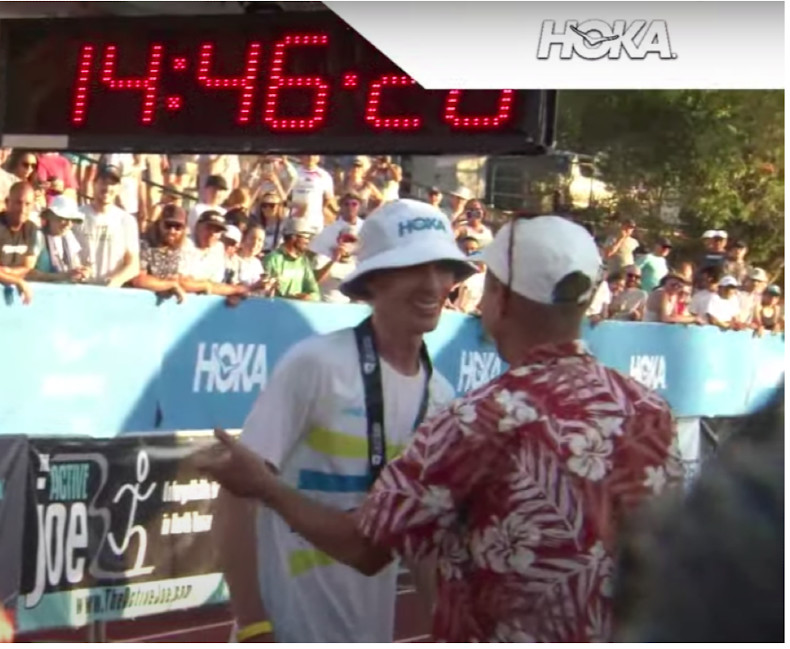
Walmsley ran 14:09:28 in 2019, the last time the race was run (it was cancelled in 2020 due to the pandemic), smashing the course record of 14:30:04 that he set in 2018, in his third appearance at the race. Today, he had put considerable distance between himself and Hayden Hawks by around mile 35, but it was clear another record was not going to be possible. (Hawks was in second position for most of the race, but shortly before Walmsley’s arrival at the finish line, announcers Dylan Bowman and Corrine Malcolm mentioned he was in danger of being passed by Tyler Green and Drew Holmen.)
Walmsley is only the third man with three consecutive victories; the other two are Scott Jurek, who had seven straight victories from 1999-2005, and Tim Twietmeyer, who won five times, three of them consecutively in 1994-1996.
Beth Pascall of the U.K. led the women’s race all day and is a good bet to win, but the top five were very close together throughout, making it too risky to call. Pascall won the Canyons 100K race in California in April, and shattered the record on the Bob Graham fell round in the U.K. last year. At the time of Walmsley’s finish, she was sitting at 7th or 8th overall, with Ragna Debats of the Netherlands (who is 42) and Ruth Croft of New Zealand (in her 100-mile debut) just outside the top 10 overall.
For the first time, there were live broadcasts on YouTube and by iRunFar, so fans could follow every minute of the race, with constant well-informed and passionate commentary from Bowman and Malcolm about the oldest and best-loved 100-miler in North America.
(06/27/2021) Views: 1,149 ⚡AMPWestern States 100
The Western States ® 100-Mile Endurance Run is the world’s oldest and most prestigious 100-mile trail race. Starting in Squaw Valley, California near the site of the 1960 Winter Olympics and ending 100.2 miles later in Auburn, California, Western States, in the decades since its inception in 1974, has come to represent one of the ultimate endurance tests in the...
more...The Western States 100 Is Back and It’s Going to be HOT!
Western States is famously competitive - and this year is shaping up to be one of the toughest competitions yet with hot temps, and a stacked field.
Jim Walmsley and Magda Boulet will be back at the Western States Endurance Run this week.
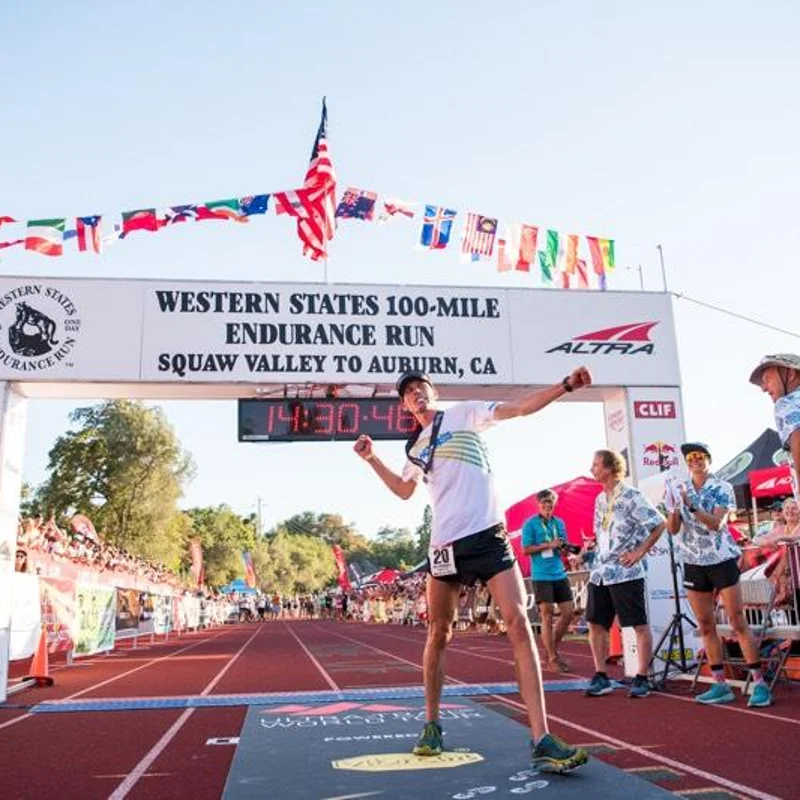
And so will Clare Gallagher, Patrick Reagan, Max King and Brittany Peterson. And, so too is race pioneer Gordy Ainsleigh and 312 other inspired runners who have been training for more than a year and a half to get to the starting line. In fact, we’re all heading back to the Sierra Nevada range this weekend — even if vicariously — to what feels like a bit of normalcy returning.
After a year mostly away from the trail racing running scene, things are starting to feel like old times. With stacked men’s and women’s fields, scorching heat in the forecast and last year’s Covid-19 hiatus hopefully mostly behind us, it’s definitely the event the ultrarunning community has been looking forward to. The race begins at 5 a.m. PST on June 26 and it looks like it’s going to be an epic one. (Follow via live tracking or the live race-day broadcast.)
“Yeah, it will be good to be there and see people and actually be in the race,” says Walmsley, who won the race in 2018 and 2019 in course-record times. “It’s been an odd year.”
Odd for sure, but with deep men’s and women’s fields, hot weather, dusty trail conditions and the late June gathering of a few hundred runners on this hallowed ground feels somewhat normal. The mountains and canyons in and around Olympic Valley northwest of Lake Tahoe have been a sacred place for the native Washoe people for thousands of years before Gordon Ainsleigh’s first romp over the Western States Trail in 1974.
It’s been an especially odd year for Walmsley, who, for the second straight year, had planned to use the first half of his year training for the 90K Comrades Marathon in South Africa. But that was canceled last year (with just about every other big race, including the Western States 100) and this year, too.
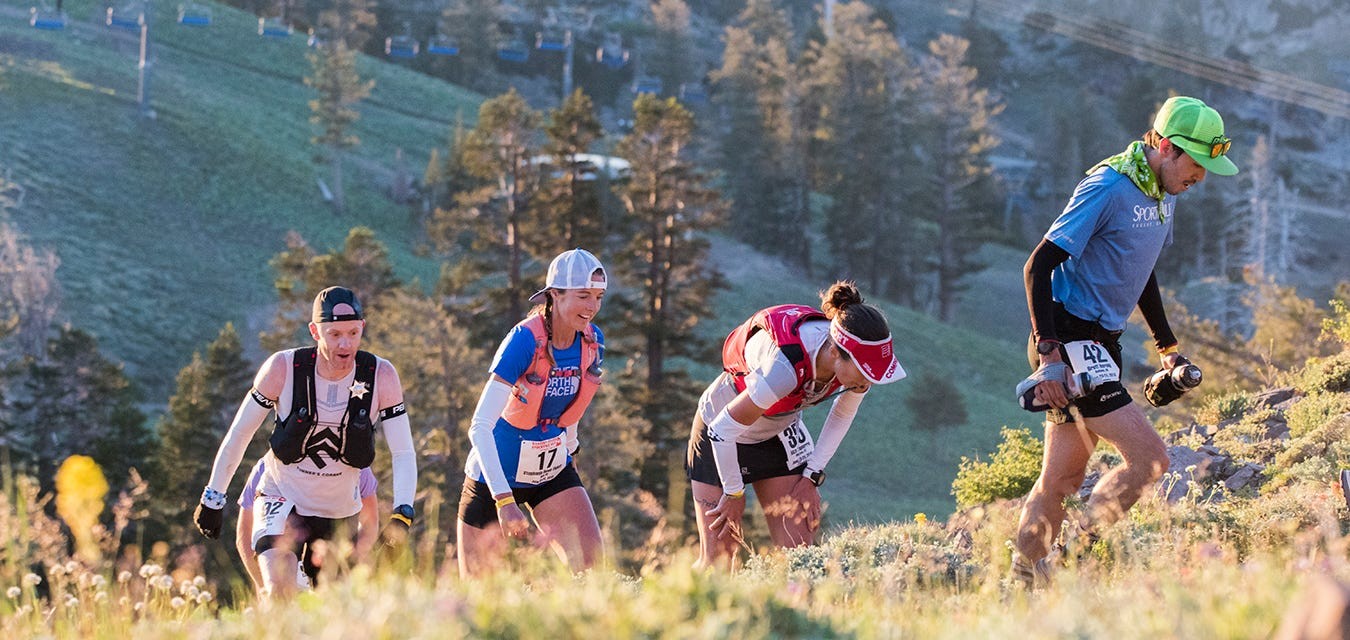
So instead, after setting a new U.S. 100K road record in January, he took a sponsor’s entry into the Western States 100 from HOKA One One and will be once again lining up in America’s most celebrated trail running race. With notable first-timers Tim Tollefson and Hayden Hawks in the mix along with Walmsley, Reagan, King, Matt Daniels, Alex Nichols, Kyle Pietari, Mark Hammond, Stephen Kersh, Jeff Browning and Jared Hazen all returning with previous top-10 finishes, on paper anyway, the men’s race is shaping up to be one of the most competitive in recent memory or maybe ever, even though it’s comprised entirely of domestic runners.
The women’s race might be even more competitive with former champions Boulet, Gallagher (2019) and Kaci Lickteig (2016) leading the way, plus elite American runners Camille Herron, Addie Bracy, Camelia Mayfield and Keely Henninger and international stalwarts Ruth Croft (New Zealand), Audrey Tanguy (France), Beth Pascall (UK), Emily Hawgood (Zimbabwe), Kathryn Drew (Canada) and Ragna Debats (Spain) joining the fray.
Who are the favorites? It’s hard to tell. Most of those runners, including Walmsley and Boulet, have admitted to having dealt with some minor injuries, inconsistent training, a lack of motivation and other setbacks over the crazy year that was. Based on what runners have been reporting, it seems like most are just eager to get back and immerse in a competitive 100-miler and see what they can do.
However, one of the keys will certainly be who can survive the heat the best. The forecast is calling for high temperatures in the upper 80s to the high 90s on Saturday after and the canyons between Robinson Flat and Michigan Bluff could even reach over 100 degrees.
Walmsley has said he’s dealt with some IT band issues and has focused mostly on running with a lot of vert, focusing on getting optimal recovery, strength sessions and body work, as well as spending as much time running in extreme heat as possible. That includes running and hiking countless laps to the summit of 9,298-foot Mt. Elden in Flagstaff, averaging 20 to 25 hours per week on the trails and also spending a lot of time on a bike trainer.
But he’s also spent a lot of time in the infrared sauna in his home and spent time with family in the Phoenix area, where he ran in the afternoons amid 115- to 120-degree heat.
“The heat training is kind of lucky for me, because growing up in the heat in Arizona, I didn’t know any different,” Walmsley says. “I just thought everyone was roasting in the heat. It’s what I grew up with and I try to lean into those memories and embrace the heat.”
Boulet, who lives in Berkeley, Calif., has also gone out of her way to train in the heat. While she says her build-up has been inconsistent compared to previous years, she’s been doing a lot of climbing and descending in the heat, and also working on box jumps to strengthen her legs for the long descent into Auburn. She says a recent 40-mile run up 3,849-foot Mt. Diablo east of Berkeley, is a good indicator that she’s ready to roll.
“I’ve definitely been spending more time in the heat lately, which is something I personally don’t enjoy running in,” says Boulet, who won the race in 2015, DNF’ed in 2016 and placed second in 2017. “But I know the importance of preparing in the heat and falling in love with running in the heat by race day. You can be as physically as ready as possible in terms of your fitness, but if you don’t have the heat training and you’re trying to tackle some of the parts of the canyons that are in the middle of the race, It’s really tough.”
Given the extreme heat, it’s not likely that anyone will challenge Walmsley’s 14:09 course record set two years ago, when it was in the low-80s and cloudy on race day. But there’s also no snow on the course this year, so the early sections that have previously forced runners to hike and walk early on will likely be faster, and that will likely result in fatigue that will slow them down in later stages of the race.
“You’ve got to take what the course gives you,” Walmsley says. “I’ve learned that you don’t fight the course where you shouldn’t. I have some splits in mind that would get me there under 15 hours and maybe close to 14:30, but it’s going to be all about feeling out what the course is giving me, following those guidelines and not forcing it. Because anyone who forces it in that heat will be doomed.”
(06/25/2021) Views: 1,032 ⚡AMPby Outside Online (Brian Metzler)
Western States 100
The Western States ® 100-Mile Endurance Run is the world’s oldest and most prestigious 100-mile trail race. Starting in Squaw Valley, California near the site of the 1960 Winter Olympics and ending 100.2 miles later in Auburn, California, Western States, in the decades since its inception in 1974, has come to represent one of the ultimate endurance tests in the...
more...Jim Walmsley opens up about injury ahead of Western States 100
The defending WSER champion has been dealing with knee issues over the past few months, but he says he's ready to race this weekend
If you follow American ultrarunner Jim Walmsley on Strava and wondered why he’s been so quiet lately, he posted on Instagram on Tuesday to talk about an injury that has been nagging him for the past few months. Walmsley wrote that he has been dealing with knee and IT band issues, but he added that he has been pain-free for the past couple of weeks. His recovery couldn’t have come at a better time, as he is set to race the Western States 100 (WSER) in California on Saturday. Walmsley is the two-time defending WSER champion and course record holder, and he will be looking to make it three wins in a row this weekend.
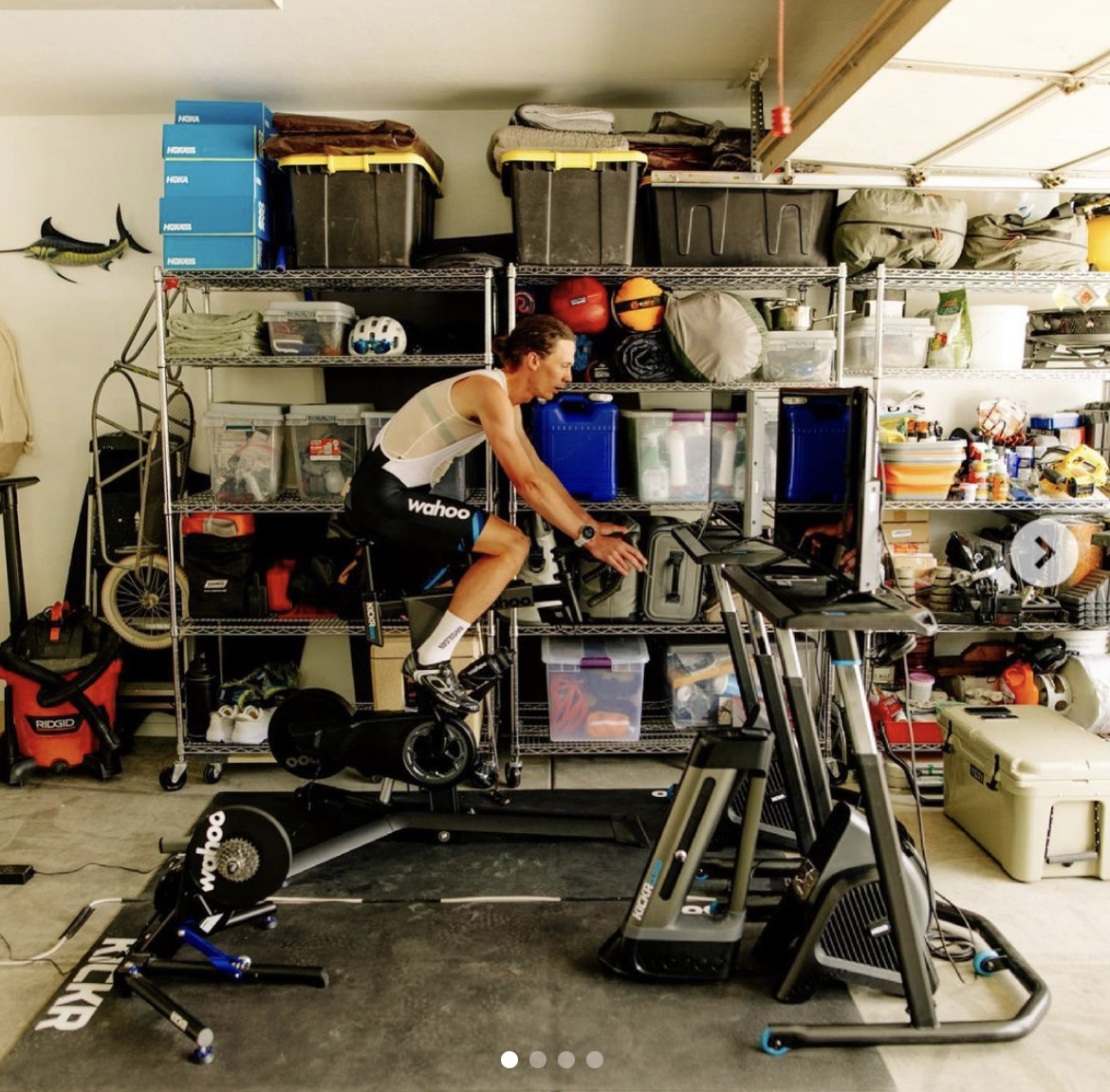
As Walmsley wrote on Instagram, his knee and IT band issues began about three months ago. “It was at a point I saw as a crucial time to take it seriously and take some time to address it,” he said. He made big changes to his training schedule, taking five days off of running each week for the better part of a month. Walmsley said the injury came as a surprise, noting that his training load had been steady and his workouts had been going well for the previous month.
After his “reset with running,” Walmsley said he had eight weeks to go until WSER. While he might have felt better, he didn’t push himself too much, and he spent the next while taking care in his workouts and visiting his physiotherapist regularly. He added that he spent a lot of time riding his bike to make up for his lack of run training in this period.
Walmsley races at Hoka One One’s Project Carbon X 2, where he ran 6:14:26, just 12 seconds off the 100K world record. Photo: Hoka One One
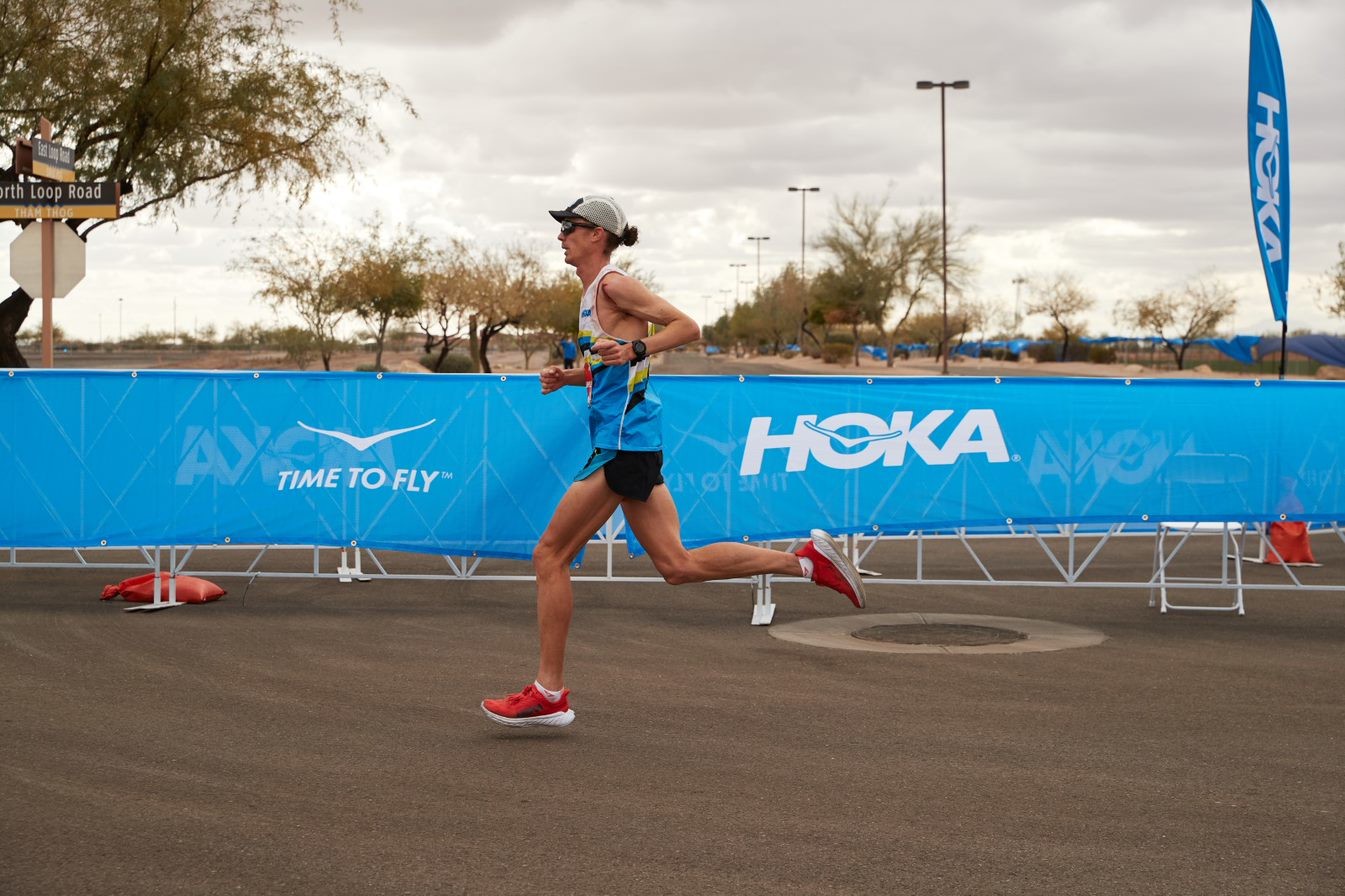
“This block has been so much more work than usual,” he wrote. “I went through ups and downs with emotions, not knowing if I’d be able to line up healthy.” With just a few days to go until WSER, Walmsley’s careful training and build to race day worked out, and he said he feels better and healthier than he has at any point in the past three months.
“I feel like I’m gaining momentum at the right time,” he wrote, “and I couldn’t be more excited to be back at Western States ready to rock.”
(06/23/2021) Views: 1,094 ⚡AMPby Running Magazine
Western States 100
The Western States ® 100-Mile Endurance Run is the world’s oldest and most prestigious 100-mile trail race. Starting in Squaw Valley, California near the site of the 1960 Winter Olympics and ending 100.2 miles later in Auburn, California, Western States, in the decades since its inception in 1974, has come to represent one of the ultimate endurance tests in the...
more...Western States site name to be changed
After researching the etymology of the racist and sexist term "squaw," officials of the California ski resort have decided to change its name.
The famed Western States 100 ultramarathon starts in Squaw Valley, Calif., near a river, some roads and several ski lodges of the same name, which many have found troubling for its racist and sexist roots. The area is also known as Olympic Valley, as it was the site of the 1960 Olympics, but for years, locals and tourists have all called it by its other name. It was recently announced that this will soon change, as owners of the Squaw Valley Alpine Meadows ski resort have finally decided to drop that title.
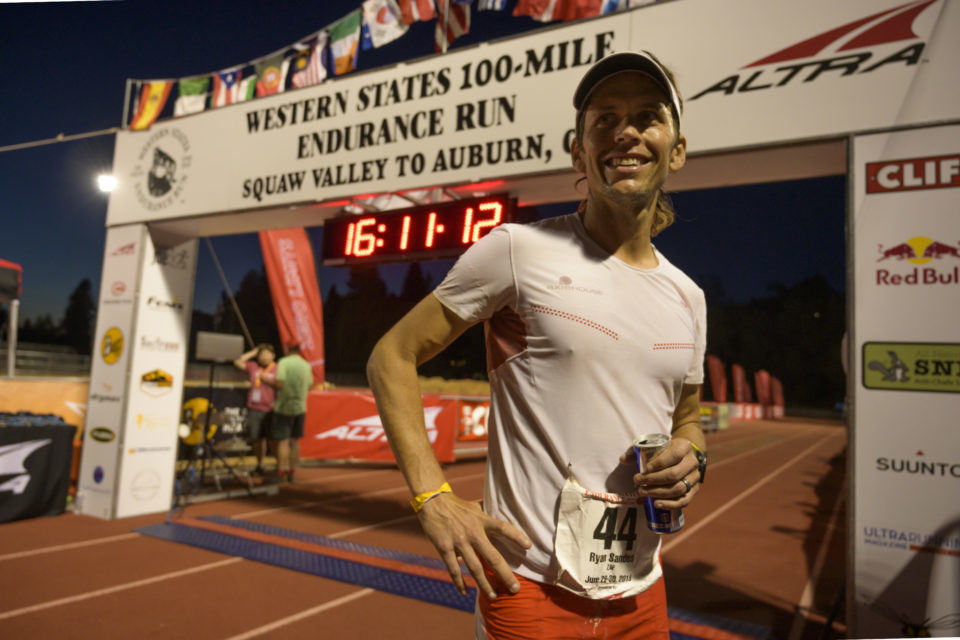
“With the momentum of recognition and accountability we are seeing around the country, we have reached the conclusion that now is the right time to acknowledge a change needs to happen,” said Ron Cohen, the president and COO of Squaw Valley Alpine Meadows. “We have to accept that as much as we cherish the memories we associate with our resort name, that love does not justify continuing to use a term that is widely accepted to be a racist and sexist slur.” Cohen went on to say the resort will find a new name to “reflect our core values, storied past and respect for all those who have enjoyed this land.”
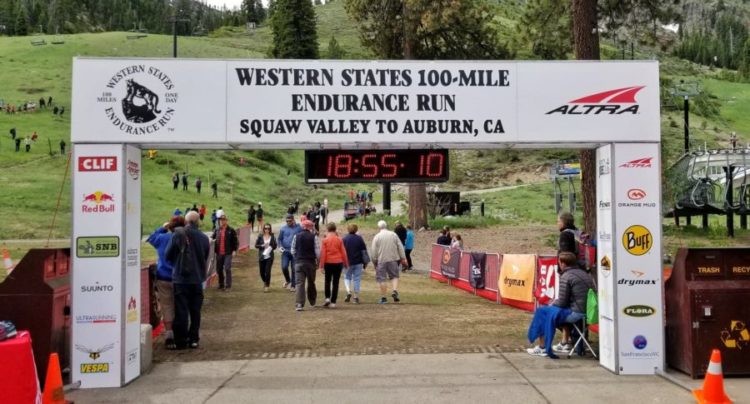
The Western States 100 starts right at the ski resort and travels 100 miles southwest to Auburn, Calif. Race director Craig Thornley tweeted the statement from Cohen and his team, adding, “It’s really gonna happen.” Thornley’s tweet received mixed reviews from his followers, with some people saying the name should have been changed long ago, while others seem to think it’s fine the way it is.
As a member of the Washoe Tribe (a Native American tribe with origins near Lake Tahoe), Helen Fillmore, told a local radio station in July, when she is around people discussing the local resort, all she hears are racial slurs.
“All of a sudden people are asking if you ski and telling you about how they’re going to go ski, racial slur. ‘Let’s go ski, racial slur,’” Fillmore said. “People don’t even think twice about how that word is impacting the person they’re talking to.” The dropping of the resort name will be welcome news to Fillmore and other members of the Washoe Tribe, although they have had to wait a long time for this change.
The resort’s new name will be released in early 2021, and officials say it will begin to be implemented after the 2020/2021 ski season, meaning that by June, when the Western States 100 is set to be held, the race’s start should be at a newly-named location.
(08/31/2020) Views: 1,421 ⚡AMPby Ben Snider-McGrath
Western States 100
The Western States ® 100-Mile Endurance Run is the world’s oldest and most prestigious 100-mile trail race. Starting in Squaw Valley, California near the site of the 1960 Winter Olympics and ending 100.2 miles later in Auburn, California, Western States, in the decades since its inception in 1974, has come to represent one of the ultimate endurance tests in the...
more...With his race event cancelled, 72-year-old Eric Spector inspires other seniors to remain active
The key is to commit to staying fit, whether during a pandemic or not, says Eric Spector.
If these were normal times, Eric Spector would be in the final phase of training for the race of his dreams — the annual Western States Endurance Run, a 100-mile trail run from Squaw Valley to Auburn. It's an event he calls the Superbowl of ultramarathons.
But with the June event canceled, along with most other activities, due to the coronavirus crisis, the 72-year-old fitness enthusiast has been forced to adapt his fitness routine.
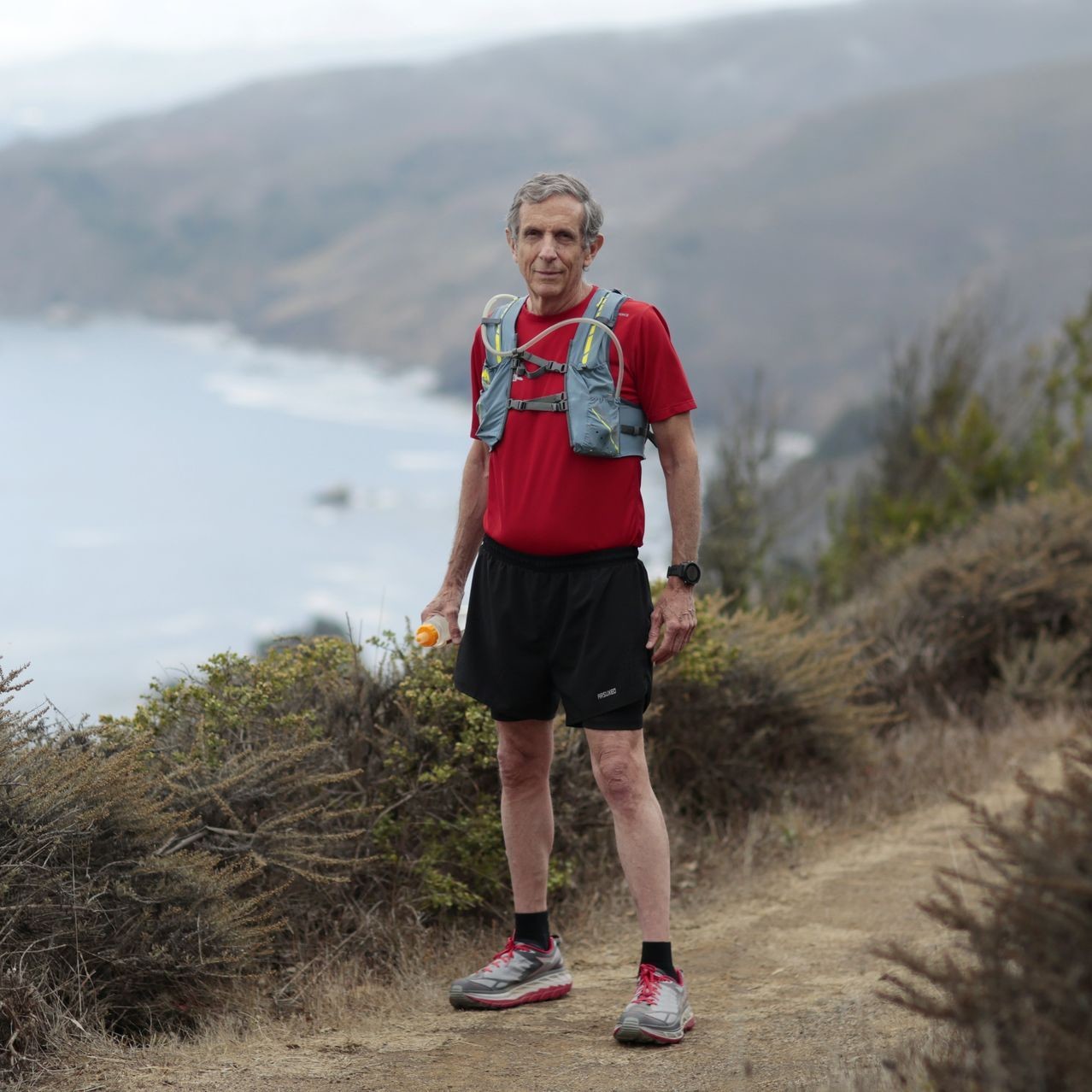
Rather than rigorously training in the hills above Palo Alto, Spector has turned to power walking. And rather than swimming and exercising at the Oshman Family Jewish Community Center, he has set up a gym in his garage where he can lift weights, ride a stationary bicycle and generally keep moving.
"The key is working up a sweat and getting the benefit of a cardiovascular workout," said the Palo Alto resident, who has participated in more than 20 marathons in the United States and abroad and was the oldest person to complete the 2018 Rio del Lago 100-Mile Endurance Run in the Sierra Nevada foothills.
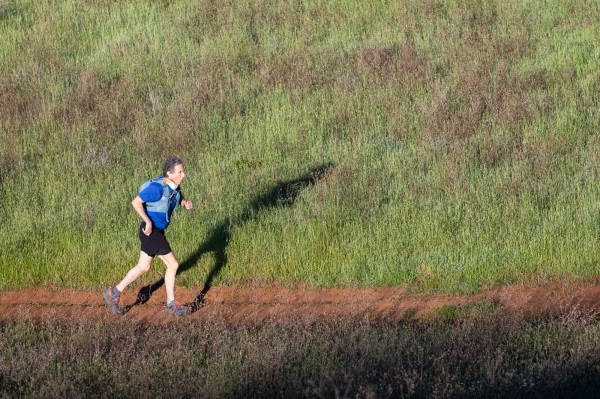
Though a committed runner, Spector, who turns 73 on May 5, is no exercise snob. In fact, he's a promoter of exercise for anybody and everybody through his Twitter page, [ @fitatallages.
"It doesn't really matter what activity somebody chooses — the benefits of being fit are extraordinarily clear," he said."It prevents so many diseases and, if you get sick, your recovery time is usually much shorter because of your fitness.
"Whether you speed walk, bicycle, play racquetball, hike — the most important thing is that you do it regularly and that you sweat. With those two ingredients, it provides a longer, healthier, more vigorous life."
On his Twitter feed, Spector often shares links to inspirational stories of older athletes as well as small exercise tips like:"Well, you don't want to run? Then dance."
During the stay-at-home order, he has been sharing the many ways athletes, from Olympians to coaches, have adapted their fitness routines. One marathoner who qualified for this year's Olympics in Tokyo, shared this philosophy with the New York Times: The only thing athletes can control at this point, since competitions and events are canceled, is their training routines. Another story that Spector shared from Sports Illustrated features a running coach who provided some creative inspiration to those looking to compete or exercise: He organized a virtual ultramarathon where participants mapped out their own running loop in their backyards, neighborhoods or treadmills and livestreamed their runs on Zoom.
Spector said the key is to commit to staying fit, whether during a pandemic or not. He recommends picking an exercise and following through with a routine. This can be anything from walking around the block once a week to walking around the backyard everyday. Tracking when, where and for how long you do a particular activity will help you maintain a routine and stay motivated.
Exercise wasn't always a priority for Spector.
As a young man he was overweight and working long hours at a New York City startup.
"I wasn't at all plugged in to athletics of any kind — I'd really done nothing more than work and eat and put on some weight," he said.
But he became intrigued when some of his business school classmates flew in from California to run the 1978 New York City Marathon.
"I thought, 'If these guys can do it, I should be able to do it,' so I bought some sneakers, went out for a run to the west side of the Hudson River and barely made it," he said.
Spector kept at it, and a little more than a year later, he entered the 1979 New York City Marathon.
"It was my first running event ever but I did quite well and loved it," he said."I really loved the fitness, the clarity of mind, the stream of consciousness as you're running."
He grew to love the "runner's high," which he describes as"a kind of a euphoria, where you're not even conscious of the effort. It's just the rhythm and the joy of physical activity.
"For me, that kind of activity has been a mainstay of mental health and sanity, with the benefit of staying fit," he said.
(05/01/2020) Views: 1,318 ⚡AMPby Chris Kenrick
Western States 100
The Western States ® 100-Mile Endurance Run is the world’s oldest and most prestigious 100-mile trail race. Starting in Squaw Valley, California near the site of the 1960 Winter Olympics and ending 100.2 miles later in Auburn, California, Western States, in the decades since its inception in 1974, has come to represent one of the ultimate endurance tests in the...
more...Western States 100 has been cancelled due to the war the world is in gaged in with the Cornavirus
The decision to cancel the 2020 Western States Endurance Run was a tough one. In accordance with this decision, we are offering an entry spot for the 2021 race to all runners entered in this year’s race and a wait list spot on the 2021 wait list to all people on this year’s wait list.
The 2020 Memorial Day training runs are cancelled and all registrations for those events will roll over to the 2021 Memorial Day training runs. More details on entry and registration for 2021 events will be provided later.
We have made the decision to cancel after careful deliberation, knowing that our foremost responsibility is to ensure the health, safety, and well-being of our 2020 entrants, our volunteers, our broader running community, and society at large.
The current situation in the United States and throughout the world is one of disruption and uncertainty. We feel that moving forward with plans for a race in June is not aligned with what our government, medical experts, and society is asking us to do. While painful to do knowing the hopes and dreams that surround this event, we feel it is the responsible action to take in light of what is going on in the world around us.
(03/27/2020) Views: 1,124 ⚡AMPWestern States 100
The Western States ® 100-Mile Endurance Run is the world’s oldest and most prestigious 100-mile trail race. Starting in Squaw Valley, California near the site of the 1960 Winter Olympics and ending 100.2 miles later in Auburn, California, Western States, in the decades since its inception in 1974, has come to represent one of the ultimate endurance tests in the...
more...HOKA ONE ONE have been named as presenting sponsors of the Western States 100-Mile Endurance Run.
The deal also includes a rebranding of a series of races which allow entry to WSER as the “HOKA ONE ONE Golden Ticket Races”.
The series for 2020 will consist of the Bandera 100km in January, Black Canyon 100km in February, Georgia Death Race in March, Lake Sonoma 50-miler in April and the Canyons 100km in April.
The USA’s most prestigious trail ultra takes place in Olympic Valley, California, and will next be staged on June 27 2020.
Race director Craig Thornley: “We are extremely excited that HOKA has made such a strong commitment to our mission as an organisation, which is to serve the ultra community as one of the thoughtful leaders in our sport and culminates each June with putting on the highest-quality, yet intimate 100-mile experience we can possibly present for all of our runners.”
Mike McManus, director of global sports marketing for HOKA ONE ONE, said: “HOKA was born in the mountains and gained an early foothold in the trail ultrarunning community, so it is only natural that we would help put on the original trail 100-mile race. The Western States Endurance Run is an iconic event with an incredible community behind it, and one where some of the best-known legends of ultrarunning are born. We are beyond thrilled and proud to be the presenting sponsor.”
Registrations for the ballot for the 2020 WSER will open on November 9.
(11/05/2019) Views: 1,692 ⚡AMPWestern States 100
The Western States ® 100-Mile Endurance Run is the world’s oldest and most prestigious 100-mile trail race. Starting in Squaw Valley, California near the site of the 1960 Winter Olympics and ending 100.2 miles later in Auburn, California, Western States, in the decades since its inception in 1974, has come to represent one of the ultimate endurance tests in the...
more...How high-tempo training with elite Ethiopians helped Briton Tom Evans to place third at the Western States 100 this year
Tom Evans spent two months in Ethiopia training with elite marathon runners to prepare for this year’s Western States 100 mile ultra marathon. The training paid dividends as he finished third with the fastest ever time by a non-American runner of 14 hours, 59 minutes and 44 seconds.
“The slowest runner [in the Ethiopian running group], except for me, was a 2:08 marathoner,” the Briton said. “That made it very interesting. Their tempo runs were on dirt tracks with rolling hills, so were perfect for Western States.”
“They would run until they dropped and we were being followed by a car so they’d be picked up,” Evans said. “At first, because of the altitude, I was the first to drop out but I began to get used to the elevation.”
WSER100 is one of the most prestigious 100 mile races in the world. It takes place in California, starting at altitude before descending into deep, hot canyons. Jim Walmsley won this year’s race in a record 14:09:28.
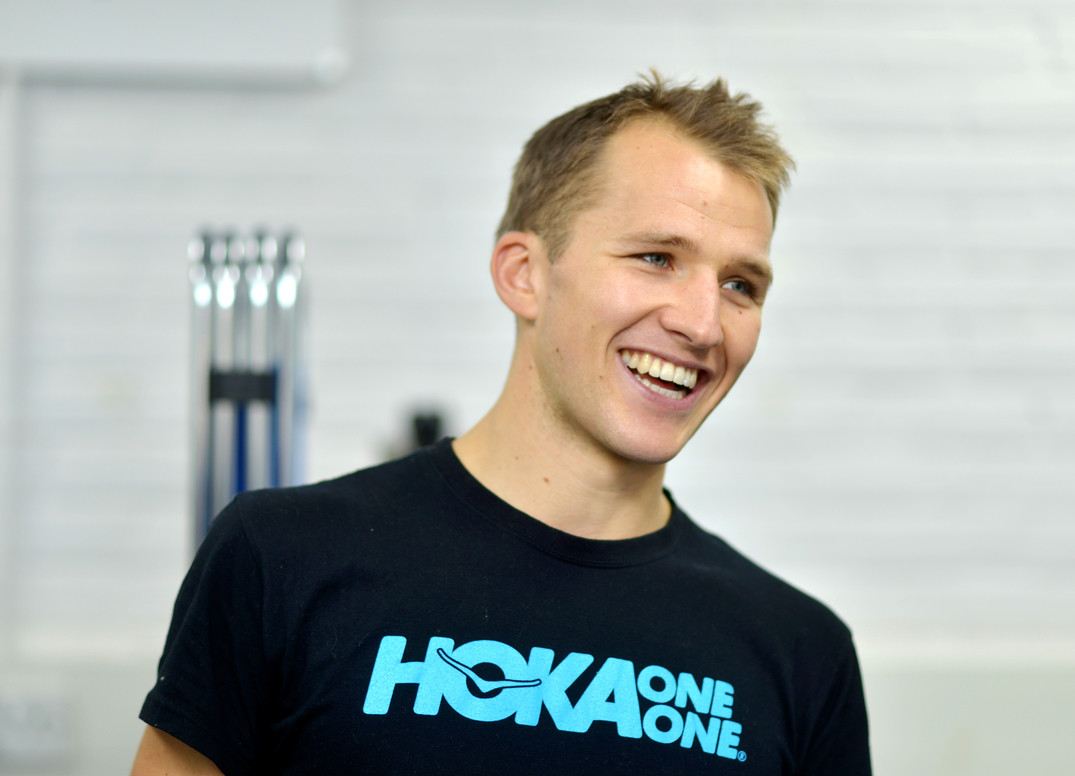
The brutal tempo sessions in Ethiopia were fuelled by fierce rivalries, with runners motivated by the hope of being picked up by foreign agents and given the opportunity to race and earn money abroad.
“It’s almost becomes survival of the fittest,” Evans said.
The “sag wagon” that accompanied the runners was always a tempting respite from the sessions.
“You can drop out when ever you want,” he said. “So, it’s about how much you want it. It was really good mental strength training as they were always going fast and furious.”
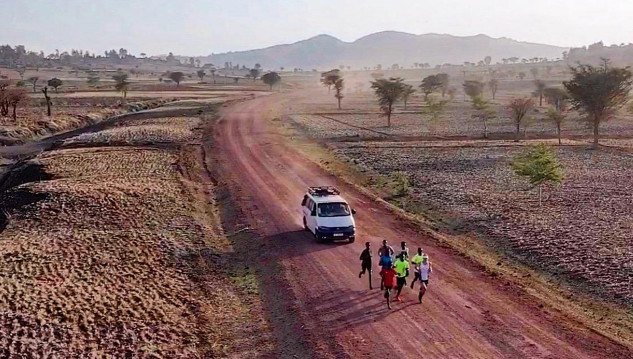
Being in a new environment forced the former soldier to be more flexible in his attitude to training.
“You had no idea what was going to happen. I had kids throw rocks at me one day,” he said. “It was such a culture shock. I just had to deal with what was ahead of me day by day.”
Evans said he had learned from them the importance of strong contrasts between hard and easy sessions.
He felt not all of the training was relevant to his competition goals. The other athletes in the group were all preparing for marathons or half marathons, so their longest run was just two hours. Evans would sometimes head out for eight hours at a time.
“They thought I was absolutely mental,” he said. “They couldn’t get over how much volume I was doing. But they were fascinated. They really respected what I was doing.”
There were no coaches on hand to force runners on to the track or trail, but the total immersion experience meant they were not necessary.
“I became so attuned to my body. I was making decisions to drop out of sessions all based on feel,” he said.
Evans, who has won the CCC event at the Ultra Marathon du Mont Blanc (UTMB) week, could feel the effects of his training when he ran WSER100.
“I just felt so much more efficient,” he said. “So, at the end, I was still able to run hard.”
“For me, coming third in my first 100 miler was a best-case scenario,” Evans said. “I knew it was possible, I just didn’t know if it was probable.”
For now, Evans is going back to shorter races of about 50km to 100km, but he said the experience had “lit a fire” in him.
“I definitely want to come back and see if I can improve my place, if not my time.”
(07/21/2019) Views: 1,755 ⚡AMPby Mark Agnew
Western States 100
The Western States ® 100-Mile Endurance Run is the world’s oldest and most prestigious 100-mile trail race. Starting in Squaw Valley, California near the site of the 1960 Winter Olympics and ending 100.2 miles later in Auburn, California, Western States, in the decades since its inception in 1974, has come to represent one of the ultimate endurance tests in the...
more...Jim Walmsley wins Western States 100 smashing his own course record
Jim Walmsley wins the 2019 Western States 100 in a course record 14:09:28, breaking his own course record of 14:30:04 set last year.
“I made up a lot of time pushing pretty good up Robinson, Devil’s Thumb as well, then things began to relax,” he said on the finish line, adding there were a few aid stations when he was not so fresh. “Things started rolling again when I crossed the river.”
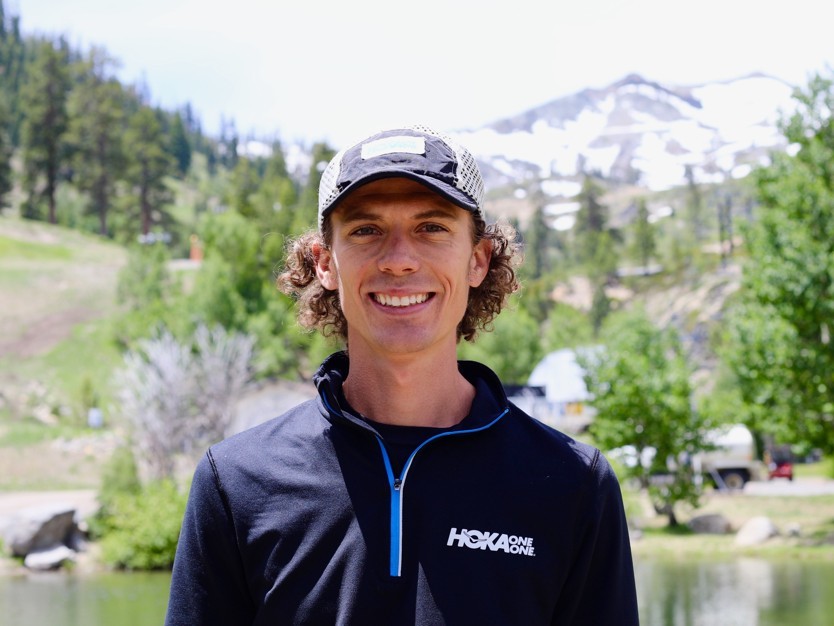
“It was a big goal just to come here and try and win. It’s one thing to win at Western States, it’s a once in a lifetime thing, but to do it twice, puts you a bit more ‘two time guy right here.”
Jared Hazen took second at the 2019 Western States 100 in 14:26:46, also under Jim Walmsley’s previous course record.
Before this year’s race Walmsley said his mindset and approach to the race have changed little, and with favorable weather and decent course conditions, a push to again break the record could be in play.
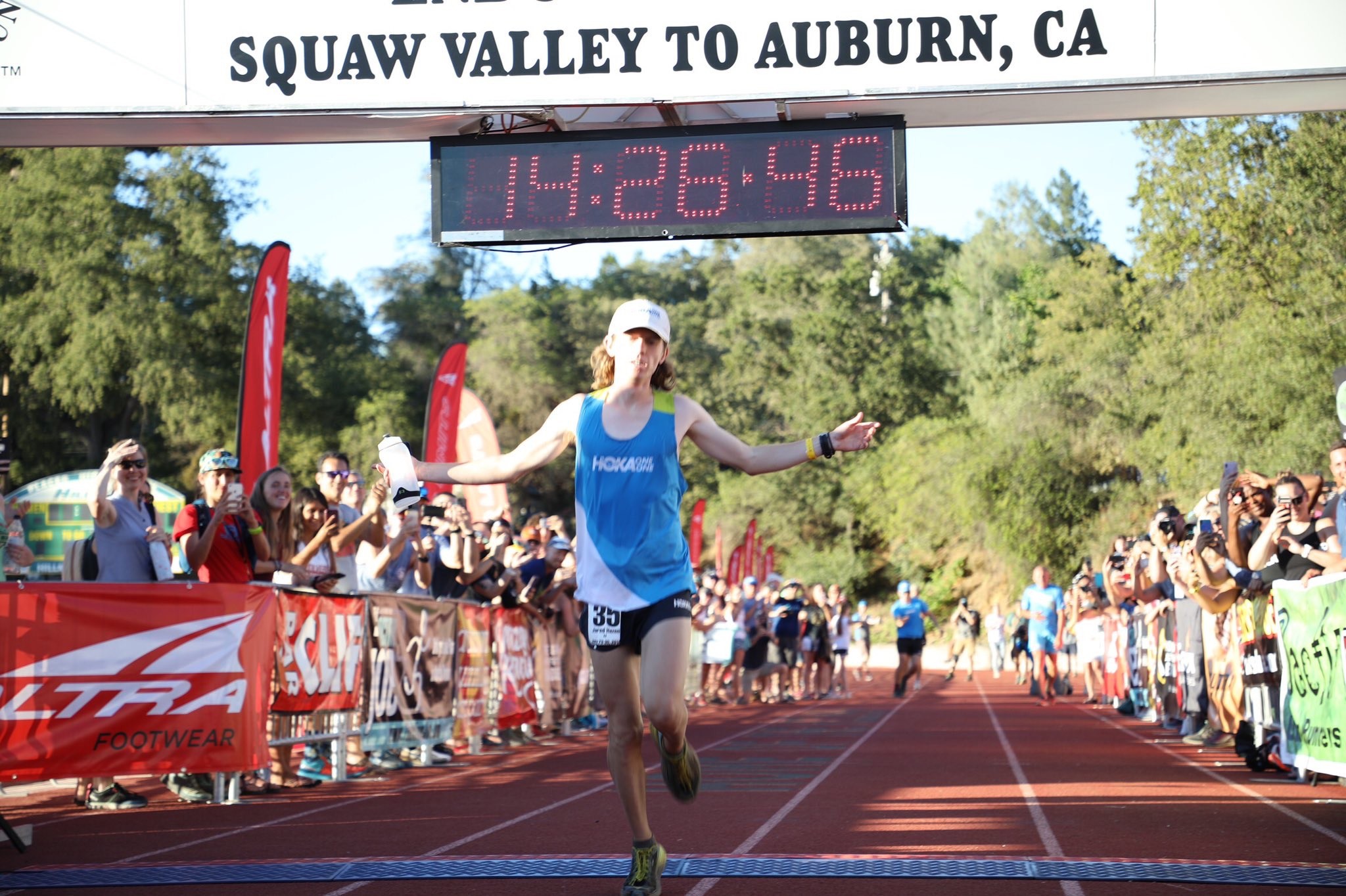
“I might kind of pull things back (from) maybe not running as risky, but at the same time, counter to that, there’s pretty good weather predictions right now,” said Walmsley. “This will be my fourth time racing, fourth year in a row, and it’s by far the coolest year. There’s also that tempting side of it of like, ‘I always want to see what I can run here.”
Walmsley was on a record-breaking pace in 2016, but strayed off course with less than 10 miles to go. He fought through exhaustion to finish 20th with a time of 18:45:36. In 2017, which had a similar amount of snow on the course as this year, Walmsley was several minutes ahead of his 2018 record time during the early portions of the course, but as the day wore on, temperatures climbed past 90 degrees and exhaustion knocked him out of the race with a little more than 20 miles to go.
“Ultimately, it’s about listening to my own pace and just putting everything out there regardless,” he said. “As long as I end up giving my best effort and going to the well to get there, I’m always happy with it. Whether it’s the DNF in 2017 or the course record last year. I’m pretty proud of both days and the fact that I know I gave everything at both races. You can always live with that.”
Coming into this year’s race, Walmsley said he feels he’s matured as a runner, which has given him the confidence to overcome the mental and physical hurdles that arise during a 100-mile race.
(06/29/2019) Views: 2,045 ⚡AMPWestern States 100
The Western States ® 100-Mile Endurance Run is the world’s oldest and most prestigious 100-mile trail race. Starting in Squaw Valley, California near the site of the 1960 Winter Olympics and ending 100.2 miles later in Auburn, California, Western States, in the decades since its inception in 1974, has come to represent one of the ultimate endurance tests in the...
more...Strong, talented and deepest field at Western States Endurance Run at this year race
More than 350 of the world’s best endurance athletes will emerge from the cold and dark Saturday morning to stand at the start line at Squaw Valley, eager to begin the Western States 100-Mile Endurance Run from the resort to Auburn.
This year’s field of runners is one of the deepest in the history of the race, featuring the return of both the men and women’s champions along with several top-10 finishers from last year.
After coming up short in two previous bids to set the course record at Western States, Jim Walmsley, of Flagstaff, Arizona, broke through last year, finishing with a record time of 14 hours, 30 minutes, 4 seconds. Walmsley, 29, is set to defend his title this year against a deep field in the men’s division, which features eight of last year’s top-10 finishers.
Walmsley will make his fourth appearance in the race on Saturday. His attempt to break the course record in 2017 ended due to exhaustion at around mile 78. He rebounded the following year by setting the course record, and said breaking that mark could be in play on Saturday.
Walmsley said he’s also been told the early stages of the course are in better shape than they were in 2017, which had a similarly large snowpack. During 2017’s race he was also several minutes ahead of the record-breaking time he set in 2018.
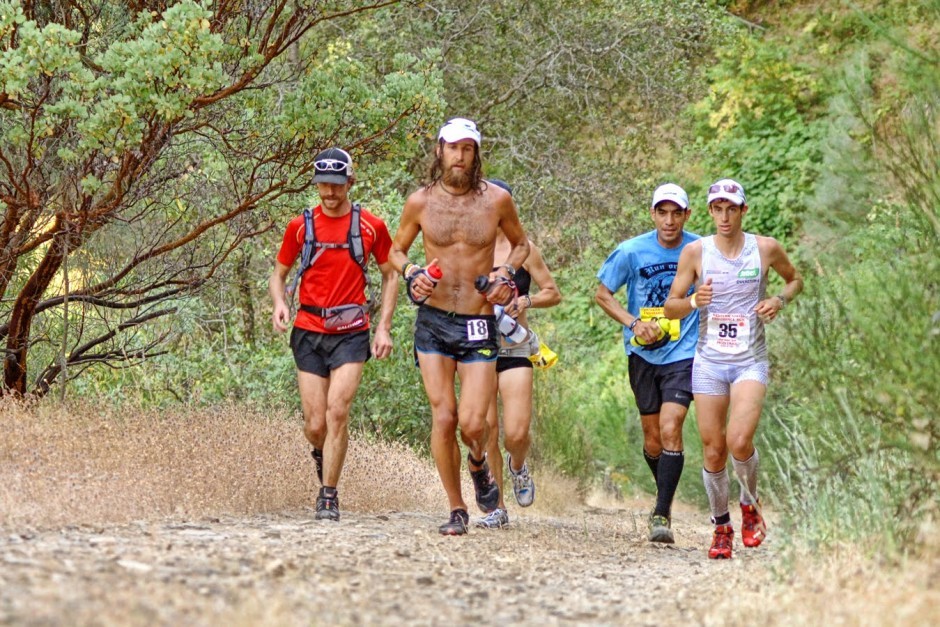
“Ultimately, it’s about listening to my own pace and just putting everything out there regardless,” he said. “As long as I end up giving my best effort and going to the well to get there, I’m always happy with it. Whether it’s the DNF in 2017 or the course record last year. I’m pretty proud of both days and the fact that I know I gave everything at both races. You can always live with that.”
Among those who could challenge Walmsley will be 2017 Western States winner Ryan Sandes. The 37-year-old South African broke through in his third attempt to win at Western States, and then ran as a pacer during last year’s event.
“I feel like it was a big thing for me to win Western States and a big achievement, so I feel pretty relaxed going into Western States from that point of view, but Western States is still one of the biggest 100 milers in the world, if not the biggest,” said Sandes. “I’ve still got that drive and hunger and I think that’s why I came back here. That’s a big motivating factor and I’m definitely hungry.”
Other top competitors on the men’s side include: Mark Hammond, Ian Sharman, Jeff Browning, Charlie Ware, Kyle Pietari, Paul Giblin and Kris Brown.
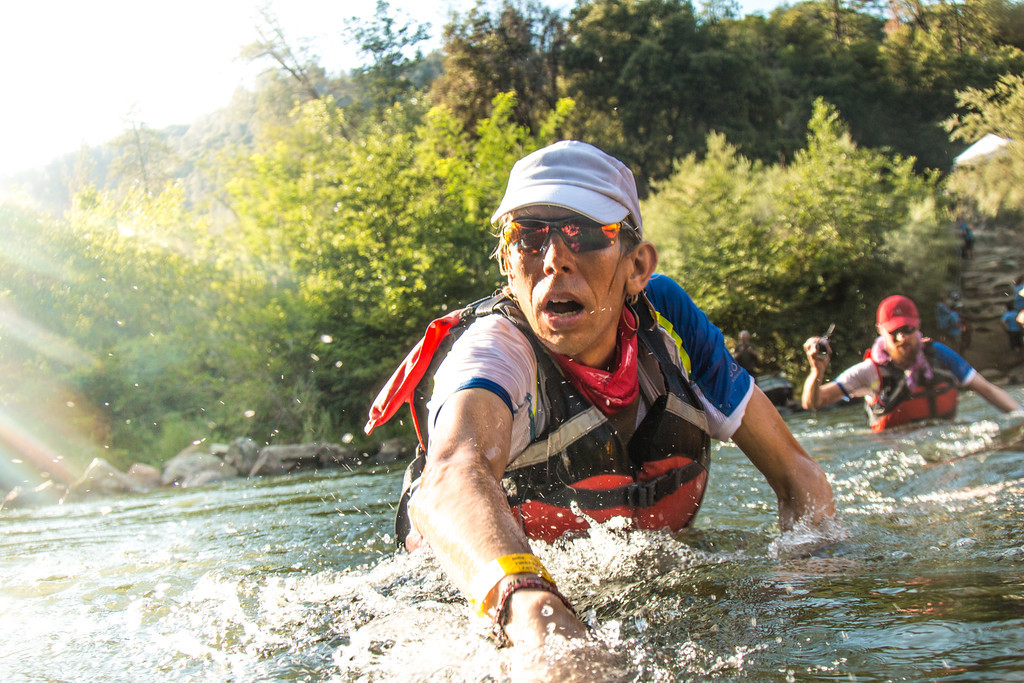
On the women’s side, defending champion Courtney Dauwalter, of Golden, Colorado, returns after winning in her first time out.
Dauwalter, 34, finished with the second fastest time ever for a woman last year, reaching Auburn with a time of 17:27:00.
Second-place finisher Katlyn Gerbin, 30, of Issaquah, Washington will also be in the field. Lucy Bartholomew, 23, of Melbourne, Australia, finished third last year and will be in this year’s field as well. Bartholomew has spent the past few weeks training in the area, and running with Truckee-Tahoe athletes at local races.
Kaci Lickteig, 32, of Omaha, Nebraska, who won in 2016, will race as well.
Other returning top-10 finishers from a year ago include: Amanda Basham, Cecilia Flori, Camelia Mayfield, Aliza Lapierre and Corrine Malcolm.
(06/28/2019) Views: 1,796 ⚡AMPWestern States 100
The Western States ® 100-Mile Endurance Run is the world’s oldest and most prestigious 100-mile trail race. Starting in Squaw Valley, California near the site of the 1960 Winter Olympics and ending 100.2 miles later in Auburn, California, Western States, in the decades since its inception in 1974, has come to represent one of the ultimate endurance tests in the...
more...Kyle Robidoux is legally blind and will be making history as he takes on the Western States 100 this weekend
When 43-year-old Roxbury, Massachusetts resident Kyle Robidoux sets foot on the starting line at Squaw Valley Saturday morning, he will be making Western States history.
According to Race Director Craig Thornley, Robidoux will be the first known runner in the 45-year existence of the Western States 100-Mile Endurance Run who is legally blind.
With the help of a team of sighted guides, Robidoux will attempt the 100.2-mile trek from Squaw Valley to Auburn. But he is no stranger to ultra running. Since being declared legally blind at age 19, Robidoux has completed a number of premier running events, including five Boston Marathons.
"I've run in three 100-mile races, all with varied terrain, but Western States by far will be the most challenging," said Robidoux, who is being sponsored by Clif Bar. "There are a variety of conditions, so it'll be important for me to run really hard when terrain is runnable, knowing on climbs I'll have to walk. I'll have to make up my time during the runnable stuff."
Robidoux was diagnosed with Retinitis Pigmentosa, a degenerative eye disease that affects night vision and typically leads to complete blindness, when he was 11. Though he still has an estimated 3 percent field of vision, his eyesight has gradually declined over time.
"I have very extreme tunnel vision, like looking through a paper towel roll," Robidoux said. "I have no peripheral vision, no up or down, no night vision at all. I'm not colorblind but I can't see contrast very well. When I'm running, I can't tell the difference between dirt, rocks or roots. I can't see elevation change and I can't see if I need to step up or down."
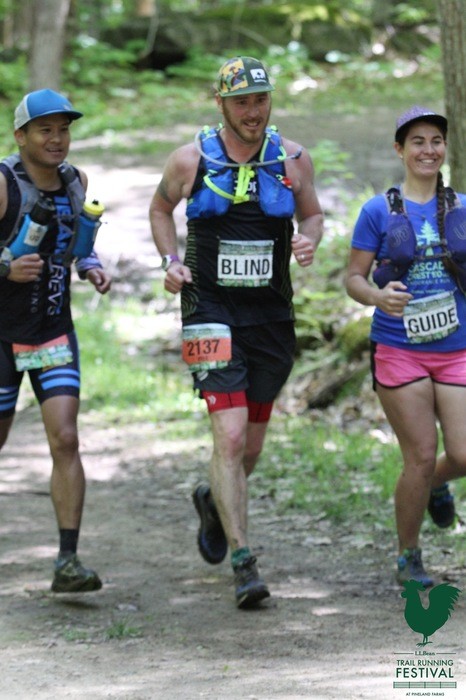
That's where his guides come in. Connected through an organization called United in Stride, which helps recruit sighted guides for visually impaired runners and vice versa, Robidoux's guides run side by side with him, bound together by a tether. The guides act as a sight coach throughout the race, giving various verbal cues to the visually impaired runner.
"Their goal is to keep me safe and keep other runners safe during races," Robidoux said. "They keep me moving forward and upright. That puts me in a position where all I have to focus on is running; not if I trip on something or run into someone else."
Among Robidoux's guides is seven-time WSER champion Scott Jurek.
"It will be fun seeing this course in a different light," said Jurek. "It's so cool to have an opportunity to be someone else's eyes."
After getting to know each other over the past several years, Jurek feels Robidoux is up for the challenge.
"Kyle's got a tenacity to him," Jurek said. "He might not be the fastest, but he's got an intense desire, something you have to have for Western States, whether you can see or not."
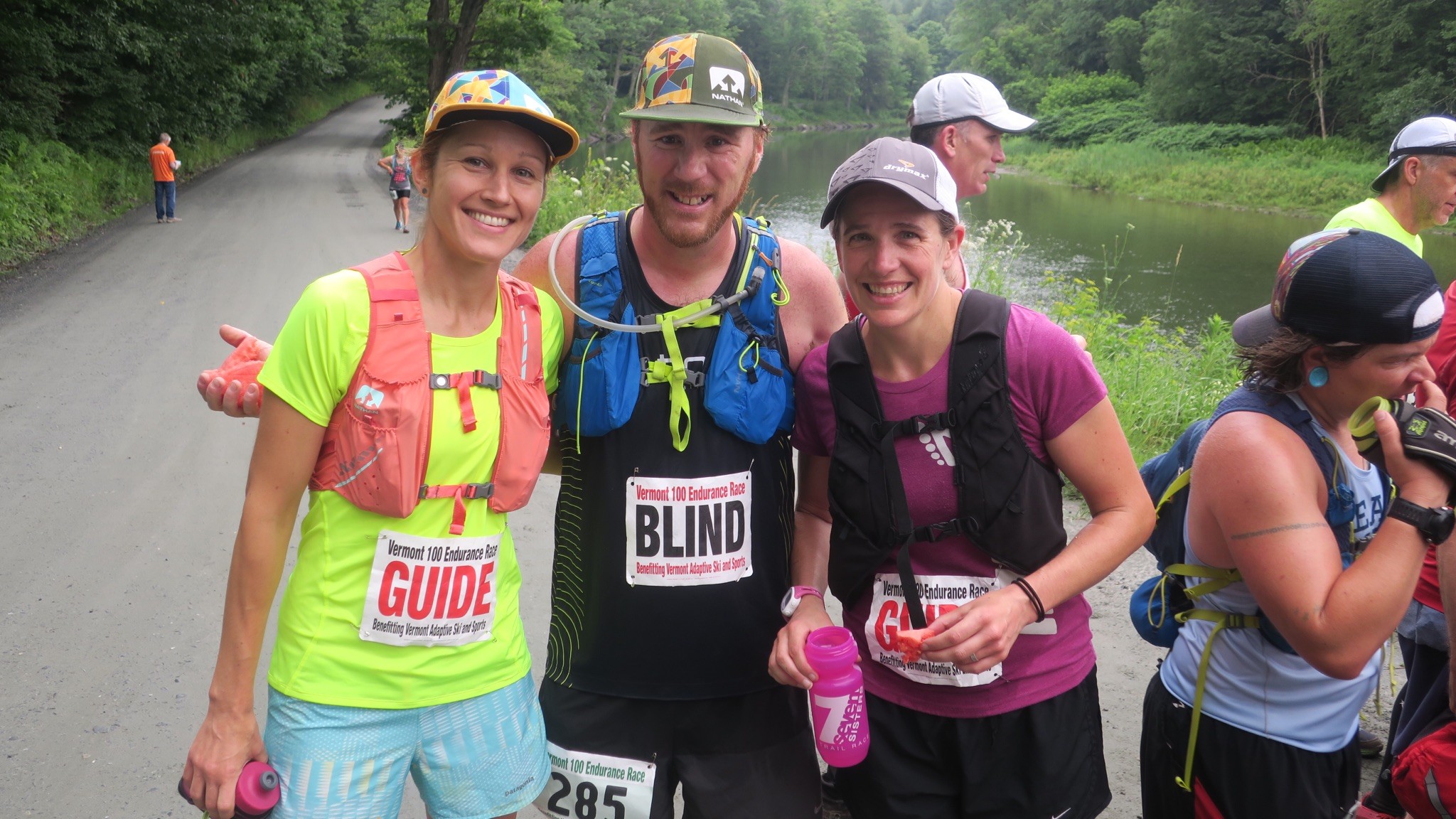
That desire sprouted from depression. Robidoux's initial resentment toward his diagnosis made him inactive, overweight and on a path toward Type 2 diabetes.
"I essentially dealt with it by not dealing with it," said Robidoux. "I was bitter and angry about my eyesight. I was convinced things were being taken away from me that I loved doing."
With the support of his family, Robidoux began seeing a therapist to help deal more effectively. Soon after, he started running again to improve his health and be able to play with his daughter, Lucy. He dropped 70 pounds and completed his first event – the Maine Half Marathon – by age 34 in 2010.
“I started to realize that things weren’t being taken away from me, I was giving up on them,” Robidoux said. “I still have days when I get really angry and frustrated. It’s a continuing process. There’s a strong likelihood that I’ll lose all of my vision. It’s scary, but I’m learning how to adapt and emotionally prepare for that.”
Robidoux has finished over 25 marathons and ultra marathons and plans to continue for as long as he’s able.
(06/25/2019) Views: 1,931 ⚡AMPby Nick Pecoraro
Western States 100
The Western States ® 100-Mile Endurance Run is the world’s oldest and most prestigious 100-mile trail race. Starting in Squaw Valley, California near the site of the 1960 Winter Olympics and ending 100.2 miles later in Auburn, California, Western States, in the decades since its inception in 1974, has come to represent one of the ultimate endurance tests in the...
more...Cecilia Flori often smiles through pain, but now she’s hoping an injury doesn’t keep her from competing at the 2019 Western States 100-mile race
The gap between elites and amateurs can feel wide indeed, but one area of common ground is an injury that threatens the start line of an important race. That’s the relatable place elite ultrarunner Cecilia Flori finds herself as she struggles with a foot injury a few weeks out from the Western States Endurance Run, the 100-mile race on June 29, from Squaw Valley to Auburn, California.
Expected to be a favorite in this year’s event, Flori arrived in California more than a month before the race, hoping to train on the course. The 38-year-old Italian physicist, who currently calls New Zealand home, earned bib F5 and says she was feeling as fit as ever when her foot began to hurt.
“I’ve been working on my speed by running marathons this year,” she said. “I think the Western course suits my strengths and I was more than ready for it.”
Relatively new to the ultra scene—and running in general—Flori made a big entrance to the sport, nabbing a podium spot at the North Face Endurance 50-miler in Canada in 2015.
“I’ve always loved the outdoors and was a climber before a triathlete friend convinced me to run a half marathon with him,” she said. “I really enjoyed it and I was hooked.”
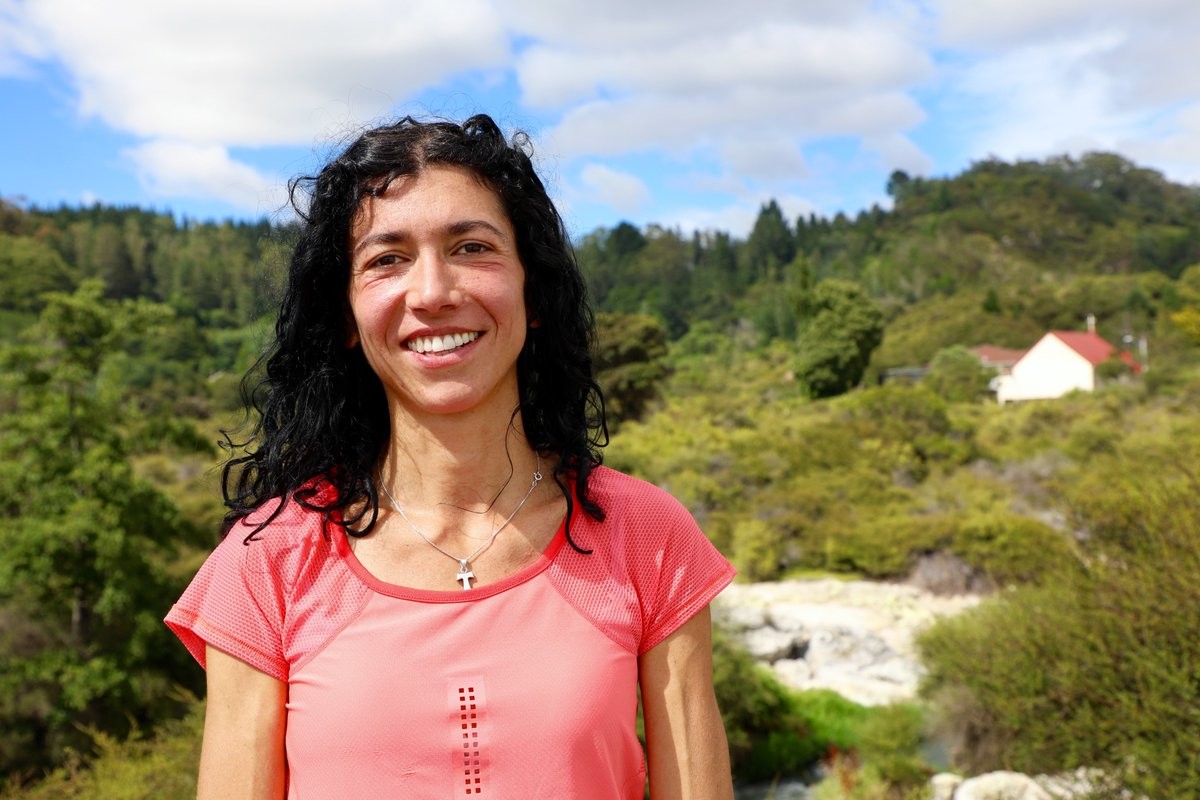
Flori says the flow of running is what drew her in. “The repetitive motion makes me feel alive,” she said. “It’s a primal feeling—I’m at one with nature when I’m on trails.”
Relocating for her research to scenic New Zealand in 2016, Flori migrated entirely from climbing to running, joining a running club for training. She took on some shorter distance trail races and then won the Taupo 100K. “I started thinking that maybe I was good at endurance,” she says. “In 2017, I entered the Tarawera 100 and took third behind [2008 U.S. Olympic marathoner] Magda Boulet and [2017 Comrades champion] Camille Herron. I was shocked but I realized I could compete on an international level.”
Herron has since become Flori’s coach, and it was that Tarawera race that made Herron take note.
“I watched her run neck-and-neck with Magda Boulet,” Herron said. “What I remember most as I looped around and saw her was the big smile on her face.”
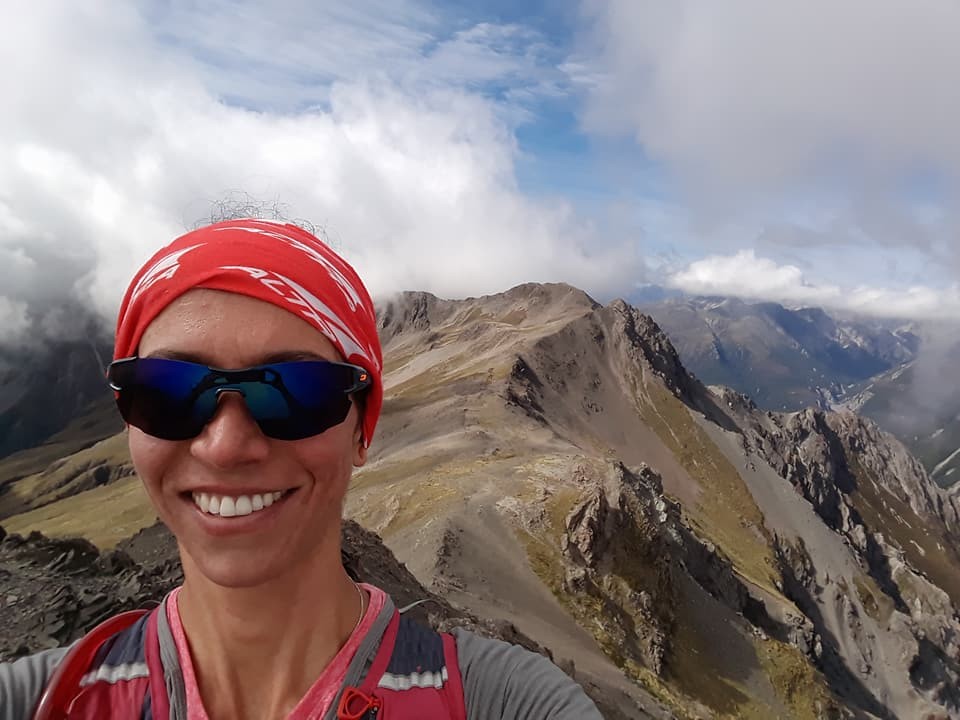
Since then there have been few hiccups in Flori’s ascent to the upper echelons of ultras. She pulled off fifth at last year’s Western States in 19:44 and followed it up with a 10th place finish at the 101K CCC in the French Alps last September, which she admits, tested her. “It was a learning experience,” she said. “I was sick and had to stop at aid stations quite a bit. But I still managed 10th and I’m proud of myself.”
Herron says Flori has a bright future ahead of her. “I saw that same smile on Cecilia’s face at 62 miles into Western last year. For someone to look that good in fifth place tells me she has lots more to give.
(06/24/2019) Views: 2,045 ⚡AMPby Amanda Loudin
Western States 100
The Western States ® 100-Mile Endurance Run is the world’s oldest and most prestigious 100-mile trail race. Starting in Squaw Valley, California near the site of the 1960 Winter Olympics and ending 100.2 miles later in Auburn, California, Western States, in the decades since its inception in 1974, has come to represent one of the ultimate endurance tests in the...
more...New Racing Rules Remove Some Barriers for Transgender Runners
As president of the board of the nonprofit that oversees one of the most prestigious ultradistance races in the country, John Medinger has had to deal with many concerns: sponsors, weather, permits, volunteers.
But it wasn’t until this year that he and his colleagues at the Western States 100-Mile Endurance Run were compelled to address an issue few would have envisioned when it was first held in 1974: transgender competitors.
“It’s not something we would have been thinking about back then, that’s for sure,” said Mr. Medinger, 68, who has run Western States five times and has been involved in race management since 1991. “But it’s the nature of society now.”
And it’s something that the world of competitive athletics, including the Olympics, USA Track & Field and the National Collegiate Athletic Association, has been grappling with: how transgender women, in particular, should be entered and scored in competition and whether they have an unfair biological advantage over cisgender women, whose identity reflects the sex they were assigned at birth.
Although the science is mixed on the biology, some people contend that transgender women have an advantage because of size and the presence of testosterone, even though hormone levels change during transition.
But others, most notably the researcher and transgender runner Dr. Joanna Harper, are skeptical that such an edge exists, particularly in endurance sports in which (as opposed to say, sprinting or shot-putting) transgender women appear to have similar cardiovascular measures as cisgender women and thus little or no advantage.
While Western States starts near the site of the 1960 Winter Olympics, there is no prize money, scholarships or endorsement deals are at stake.
There are no gold medals, but there is some precious metal involved: a handmade silver belt buckle for those who manage to complete the distance in less than 24 hours.
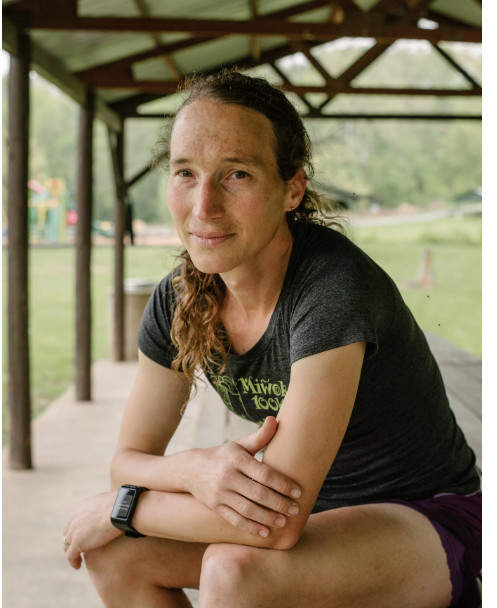
On June 29 and 30, 369 runners (chosen through a lottery entered by 5,862 runners) will take on the Western States challenge, as they attempt to navigate a mind-and-body-boggling 100 miles of trails and altitude changes from Squaw Valley to Auburn, Calif. The swiftest will be running to finish among the top 10 men or women. Recognition is also given to the top three males and females in five age groups from 30 to over 70.
The question of transgender fairness arose for Western States in December, when Grace Fisher — a transgender runner who is an outstanding ultradistance competitor — was selected through the race’s traditional lottery system.
The event’s management team decided it was time to come up with a policy. “We felt that this was not something we should ignore,” said Diana Fitzpatrick, a board member. “If it turned out that she finished in the top 10, it would be better for her and everyone that we had a policy in place.”
Back in high school in Utah, Ms. Fisher, now 38, was a male-identified track runner. She recalls that when some teammates ran a local marathon their senior year, “I said, ‘I’ll never do that, it’s crazy.’” Eventually, Ms. Fisher began running distances far longer than the marathon. She has completed about 40 ultramarathons, including eight 100-mile races.
She continued running during the years when, she said, “I was figuring things out.” After hormone treatments, she ran her first ultramarathon as a woman in 2015. She said she slowed down since her transition as a result of muscle mass loss, which can be attributed to hormonal treatments.
But Ms. Fisher, who lives in Hancock, Md., ran a personal best time in a 100-miler in Virginia last September of 18 hours 41 minutes. She was the first female finisher and fifth overall in that race.
Ms. Fitzpatrick, 61, a lawyer who is also a runner (she, too, has competed in Western States five times), worked with a committee of four other board members to develop the policy. They looked at existing guidelines from other organizations and races, and spoke to leading figures in transgender sports.
During the process, they were also cognizant that the runner who had sparked their action did not ask for the guidelines.
The guidelines they came up with, and which were announced in March, are being viewed as a model for other participatory running events.
Ms. Fitzpatrick acknowledged that “we really tried to have a `live and let live’ view on this.”
Hence Western State’s guidelines state that “a runner’s self-declared gender at registration will be accepted at face value.” No one need produce a driver’s license or other identification as has been the case for some races.
If, however, a finisher in the top 10 or among the top three in their age group is challenged, race management may ask the runner for documentation that they have undergone medically supervised hormone treatment for gender transition for at least a year before the race.
Even in the event that a transgender runner wins an award or is challenged and the challenge is upheld by race management, the guidelines state that “the runner will be allowed to keep their finisher’s buckle.”
That allowance, Ms. Fitzpatrick says, is to underscore that the new guidelines are “not about punishment.” By contrast, competitors who violate Western States doping policy are stripped of their silver buckle — as well as whatever other award they won.
“Underneath this all are real people with real feelings who have usually had a long, hard journey to get where they are,” Ms. Fitzpatrick said. “The last thing they need are additional challenges and hurdles.”
(06/22/2019) Views: 1,870 ⚡AMPby New York Times
Western States 100
The Western States ® 100-Mile Endurance Run is the world’s oldest and most prestigious 100-mile trail race. Starting in Squaw Valley, California near the site of the 1960 Winter Olympics and ending 100.2 miles later in Auburn, California, Western States, in the decades since its inception in 1974, has come to represent one of the ultimate endurance tests in the...
more...Henri Lehkonen is more prepared than ever for the Western States 100 Mile Endurance Run
The Hong Kong-based Australian Henri Lehmonrn will run the Western States 100 with a power monitor attached to his shoe and will stick religiously to a predetermined wattage.
“It’s been a revelation. If I lost the thing, I’d buy another tomorrow,” he said. “It’s a miracle way to control yourself in racing.”
Lehkonen believes it is better than other similar metrics, like heart rate, because it removes variables like excitement or altitude.
“I’ve done enough races now when I’ve not followed the watch and I’ve blown up, and when I’ve followed the watch and I’m tearing past people at the end,” he said. “I follow it for the first third – that’s where the damage is done if you over exert yourself. Then you get the adrenaline from passing people.”
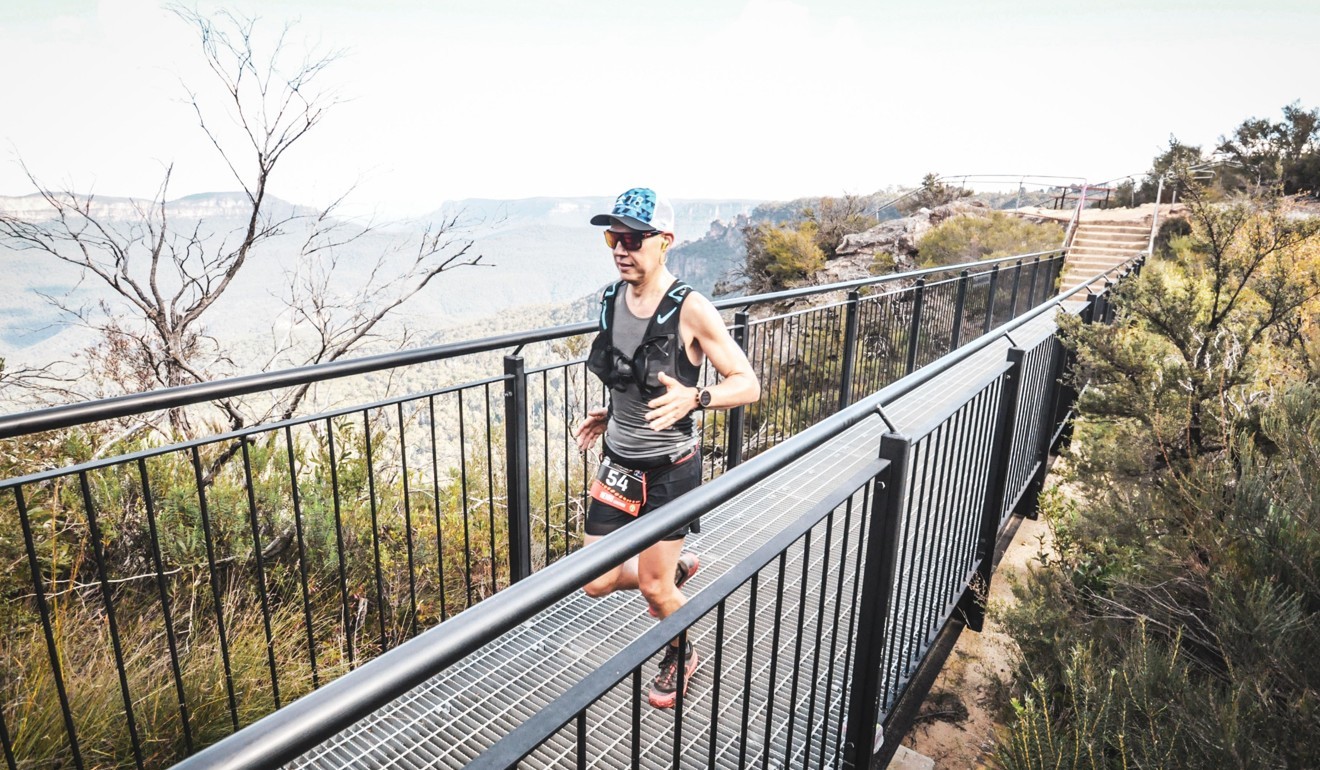
And it is working. In March, he ran the 100km Ultra Trail Australia (UTA). He was 69th after 1km, but finished 11th in a highly competitive field.
Power meters are common in sports like cycling, but are yet to be taken up widespread in trail running. Lehkonen was introduced to the meter by his coach Andy Dubois, who crunches the data to give him an accurate power curve for his races.
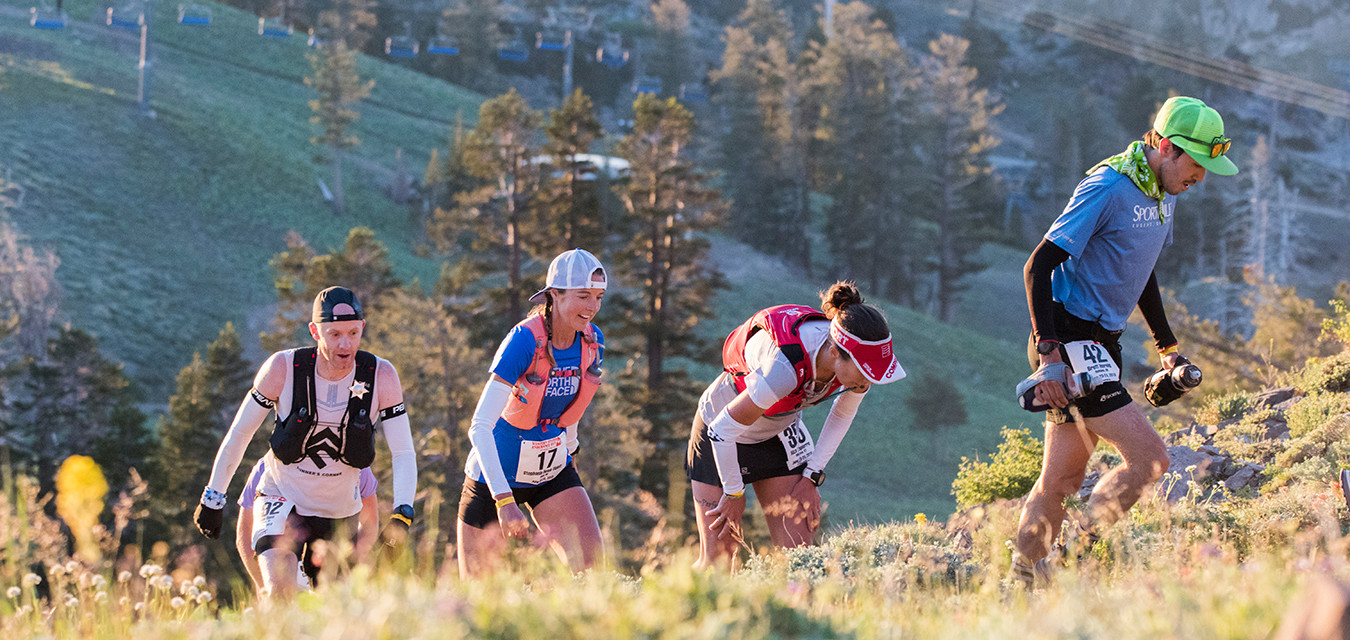
Aside from the gadgets, Lehkonen is leaving no stone unturned. It is notoriously hard to win a place at WSER100. Hopefuls enter a lottery, and improve their chances by entering the lottery multiple years in a row. This was Lehkonen’s third year submitting an application, which is relatively quick.
“It’s Western States. It’s that big and it’s hard to get into, so I’m viewing it as all in,” he said.
He flew to California for a weekend to look at the course. The race directors organised a three-day event where runners could do the last 112km of the course, with some of the checkpoints set up.
(06/21/2019) Views: 1,930 ⚡AMPWestern States 100
The Western States ® 100-Mile Endurance Run is the world’s oldest and most prestigious 100-mile trail race. Starting in Squaw Valley, California near the site of the 1960 Winter Olympics and ending 100.2 miles later in Auburn, California, Western States, in the decades since its inception in 1974, has come to represent one of the ultimate endurance tests in the...
more...Western States 100 course record holder Jim Walmsley makes Hong Kong debut
Hong Kong is in peak trail-running season, and one of the world’s champion runners, Jim Walmsley, has flown in for a series of events that will test his legendary speed and stamina.
Walmsley has set records for running across the Grand Canyon, smashed the Western States record, earned back to back titles as Ultrarunner of the Year, and is the world’s top ranked runner on ITRA. Despite this, he sets new goals tirelessly.
He is visiting Hong Kong primarily to compete in the Fast 50 Miles Ultra trail run: a gruelling 80km dash along a single trail from Route Twisk to Shing Mun and around the Shing Mun Reservoir, with about 2,500 meters of elevation.
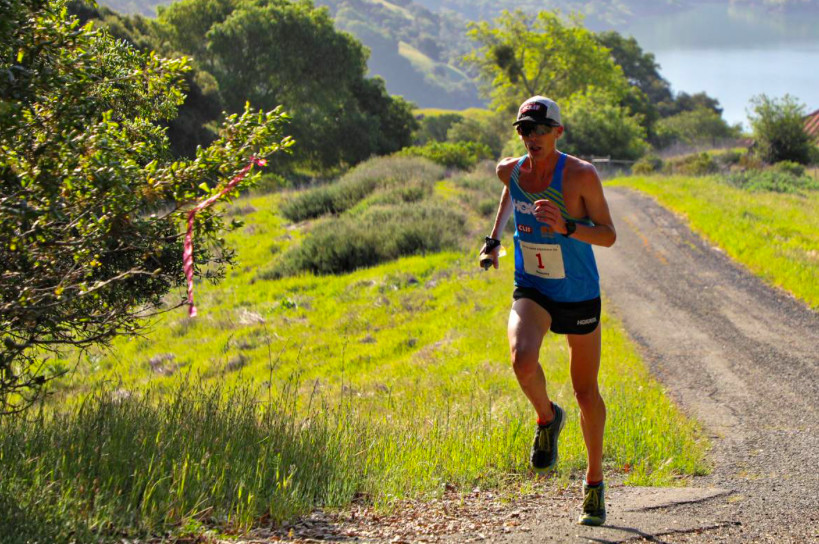
Britain’s UTMB CCC winner Tom Evans will make his Western States 100 debut next June
Tom Evans is among a top line-up of confirmed elite runners for next year’s Western States 100. The world trail bronze medallist is one of 10 runners invited by organisers of the Ultra Trail World Tour, which includes the Western States 100. Also due to take part in the world’s oldest 100-mile trail event on June 29, 2019, is Italy’s Francesca Canepa, who won the main UTMB race this year, and Spain’s Jordi Gamito Baus, who was second on this year’s UTWT standings. Britain’s Beth Pascall, who was fourth in this year’s UTMB, is another who will be heading Stateside. Evans wrote on Twitter: “So excited to announce that I will be racing Western States 100 next year! It will be my first 100 mile race. I can’t wait for the highs and lows of training to get to the start line. It’s going to be one big journey." The race from Squaw Valley to Urban along the Western States Trail was established in 1977 and has since become one of the world’s toughest and most prestigious trail running contests. (11/29/2018) Views: 1,323 ⚡AMPJim Walmsley breaks the Western States 100 record by over 15 minutes on a baking hot day
We posted on Tuesday that even with the forecasted hot weather, Jim Walmsley was going to break the course record set in 2012 by Timothy Olsen who clocked 14:46:44.
For two years now, Walmsley’s public declaration that he will not only try and break the famous 100-mile course record but trim more than 45 minutes off it has bought him massive attention.
Fast forward to this year's race. Jim hit the 85.2 mile mark in 12 hours 16 minutes. Could he hold on for 15 more miles? The temperature in Auburn, California where the race finishes at 6pm was 96 degrees.
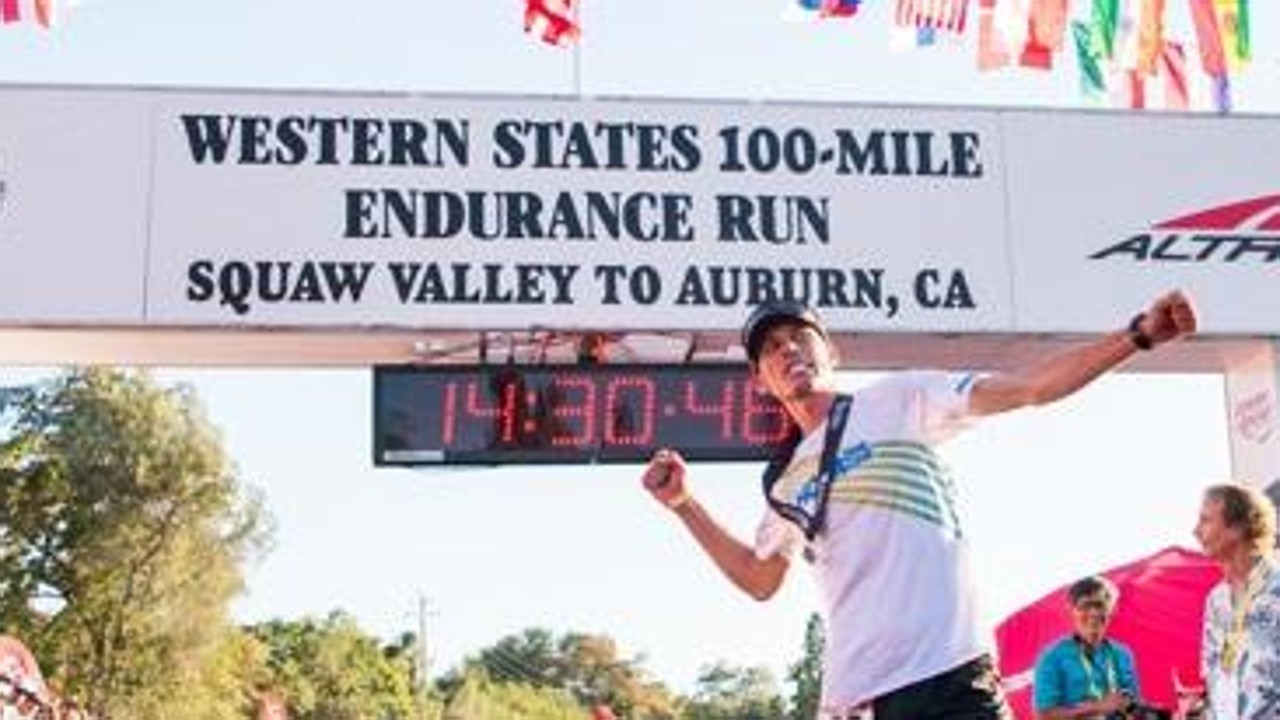
That was still a lot of miles in that kind of heat. At Pointed Rocks (94.3 miles) he was still trying to hold it together. He ran 10:50 pace for that 3.7 mile split. It was hot. Meanwhile Courtney Dauwalter continued to lead the women hitting 79.8 miles in 13 hours 48 minutes. Course records were still possible.
Jim passed the 96.8 mile check point at No Hands Bridge and ran right on through without stopping. He was 14 minutes ahead of the course record still.
Courtney was 33 minutes ahead of course record at mile 80 with Lucy Bartholomew in second place some miles back. Frenchman Francois Dhaene was in second place at 90.7 miles about an hour behind the leader.
Reliable reports told I Run Far that Jim was delayed for about ten minutes by a bear with cubs along the trail at around 95 miles. He passed the Robie Point check point (98.9 miles) running 8:11 pace now knowing he was going to finally win the Western States 100 and maybe still set the course record.
He kept it together and went on to win clocking 14:30:04 on a baking hot day, taking over 15 minutes off the course record.
(06/23/2018) Views: 3,900 ⚡AMP

